 |
The Hissem-Montague Family  |
 |
The Hissem-Montague Family  |
My father-in-law's mother was a Wells and much of the data in this section was based, in its original form, on material put together by him. This included family photographs of the main players, the best proof I know of the accuracy of this part of the descent. As a starting point this has been invaluable, but until I made one change, I was stymied in getting back beyond Constance Wells, my wife's Third Great-Grandfather. When I realized his given name was actually Constant, it opened up the past for me.
Originally it was thought that Hugh Wells of Colchester, Essex county, England, was the earliest of the family to reach America from England. He supposedly married Francis Belcher and came to America in 1635. They were supposed to be some of the first settlers in Wethersfield, Connecticut in 1636. You may find the story of this descent at Wells or Wells Family.
Other researchers, see The Genealogy of Walter Gilbert, upon whose work I have leaned heavily, present a different story, of the widow of a Thomas Wells of Evesham who brought her two sons to New England. See also The Dickerson and Taylor Family for more detail on the family of Lloyd Sylvester Wells.
(16) Unknown Wells (c1565)Otherwise unknown, he was still living when his son, Thomas, died early in 1637. It has been conjectured that he was Thomas Welles and that his wife was Helen Sidney.
(17) Thomas Wells (c1595)Anita's 8th Great-Grandfather. Thomas Wells [Welles], was born in about 1595, probably in Evesham, in the Wychavon district of Worcestershire, England. Some have placed this date more precisely as 22 December 1595, but based on what source I do not know. His mother and father are unknown.
Worcestershire
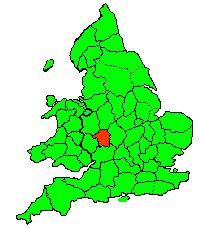
This is in the east of England, quite close to the Welsh border. Evesham lies southeast of Shakespeare's home, Stratford-upon-Avon. There is today a fairy-tale beauty about this region along the Avon river. |
 Per his will, Thomas was a weaver. In this early period that would have meant he worked at home, on a loom of his own. His wife and children may have spun the yarn for him. It took four to five spinners to provide enough material for the weaver.
Per his will, Thomas was a weaver. In this early period that would have meant he worked at home, on a loom of his own. His wife and children may have spun the yarn for him. It took four to five spinners to provide enough material for the weaver.
Thomas Wells married Frances Albret [Albright] in the Parish of All Saints, Evesham, County Worcester on 13 October 1625. So far nothing has been found of Thomas before his marriage. His father was still living in February 1636 since he was included as a beneficiary of Thomas' will, however his name was not stated. No likely candidate to be Thomas' father has been found in the burial and probate records of Evesham nor in the surrounding area.
Thomas had the title of Ensign, a rank commonly used in the British Army of the day to denote the most junior officer in an infantry unit. This probably alluded to his service in the local militia where military rank would equate to social standing. The 'Colonel' of the regiment would most likely be the local squire. I'm not sure I can make an accurate assessment from this remove in time, but it would seem to me that any officer rank, even the most junior, must denote some social standing. I'll assume it means the upper-middle class.
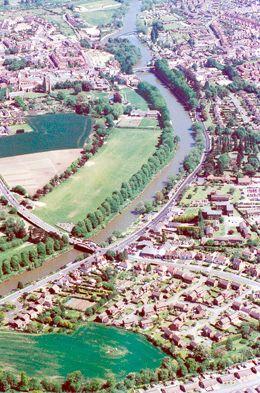 The Town of Evesham The Town of Evesham
The old market town of Evesham, in the beautiful Vale of Evesham, straddles the River Avon and on the banks of the river are the extensive ruins of Evesham Abbey, a Benedictine house founded about 701 AD. The abbey was, in a roundabout way, responsible for the name of Evesham. It seems that Eoves, a herdsman of the Bishop of Worcester, had a vision of the Virgin Mary at this spot. It was Eoves' vision that prompted the building of the abbey and the herdsman's name is immortalized in the name of the abbey and the town that grew up around it. The Battle of Evesham was fought here in 1265, on a spot slightly to the north of the town. This final conflict of the Baron's War saw the forces of Simon de Montfort trapped in a loop of the river by troops under the command of Prince Edward, son of Henry III and later King Edward I. Simon's forces were destroyed utterly and his body hacked to pieces.
Little remains of the village that Thomas Welles would have known. The historic city is now mainly Georgian in character. Isolated examples of 16th architecture include the Evesham Almonry, part of the original abbey complex, below left, and the Roundhouse [which isn't round], to below right. The area is known today as the fruit and vegetable basket of England, at least amongst the villagers themselves. |
It is not clear where Thomas' wife, Francis, was born, but her brother, Richard Albright, lived in Alderminster. The marriage of Richard to Ann Kelbie on 7 June 1631 is recorded there. Two children of this marriage are christened there and Richard died there. An inventory of his property, dated 6 March 1638/39, exists. Richard Albright left bequests in his estate to his three children and his brothers John Albright and Griffen Low. Richard and several of these same individuals were also named in the Will of Thomas Welles. Alderminster is located about 10 miles east of Evesham in County Warwick.
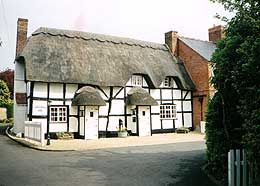 In 1636 Thomas was a resident of Evesham, owned his house, similar to the cottage on the left. He apparently raised hogs with the help of a laborer, for in his will he bequeathed "to my man Charles Whitell a shire hog worth eight shillings and two hatchets which he doth work with." The christening of three children (Mary, Sarah, and John), and the burial of daughter Sarah, are recorded in the records and/or transcripts of the two parishes of Evesham: All Saints and Saint Lawerence. The churches for these two parishes are located immediately adjacent to each other in the center of Evesham.
In 1636 Thomas was a resident of Evesham, owned his house, similar to the cottage on the left. He apparently raised hogs with the help of a laborer, for in his will he bequeathed "to my man Charles Whitell a shire hog worth eight shillings and two hatchets which he doth work with." The christening of three children (Mary, Sarah, and John), and the burial of daughter Sarah, are recorded in the records and/or transcripts of the two parishes of Evesham: All Saints and Saint Lawerence. The churches for these two parishes are located immediately adjacent to each other in the center of Evesham.
15 Jul 1630 - Mary d/o Thomas Wels, christened, St. Lawrence (transcript)
10 Feb 1632/3 - Sara d/o Tho. Weles, christened, St. Lawrence
20 Feb 1635/6 - John s/o Thomas Welles, christened, All Saints
26 Jun 1636 - Sarah d/o Thomas Wells [Wills], buried, All Saints
Thomas died sometime after 13 February 1637 and was buried at the church of All Saints, Evesham. Nearly all of the information about Thomas comes from his will, dated 9 February 1637, in which he nominated his wife as executrix without giving her name. It is certain that this is the same Thomas Wells who married Frances Albret/Albright because he left bequests in his will to his brothers-in-law, John Albright and Richard Albright. Thomas left bequests to each of his living children (his daughter Sarah had already died): eldest son Thomas, daughter Mary, and son John. He even left a contingency bequest "if my wife be with child." Will of Thomas Welles, dated 9 February 1637,
In the name of god amen be it knowe to all men that I Thomas Welles of Evesham weaver doe make my last will and testament the ninth day of February 1637 the aner and forme as folowethSo he gave £92 and a house to various people; a lot of money in those days I would think. The will was not signed, but it was witnessed by Thomas Handy (mark TH), William Lampit, and Edward Ordway. The will was probated in 1637. According to Constance Wells, there was a Thomas Wells buried in the parish of All Saints on 13 February 1636/7.
first I beequeth my soule unto the hands of my lord and saviour Jesus Christ whoo had Redemed it next I bequeth my body to the earth and all my worldly goods In maner and forme following
first I forgive my father the 5 pownd which he oweth to me and I give to my father 6 pownd more to be paid in three yere by equell somes fourty shillings a yeare but if he dy the mony that is unpaid to remain to the Exseckiter.
Next I give to my eldest son Thomas 20 pownd to be paid at the age of 21 yeares and my house after the death of his mother
Item I give to my daughter Mary 30 pownd likwise to my son John 30 more but if my wife be with child and it live then it is my will that 10 pownd a pece shall be taken from John and Mary and given to it and it is my will that my son John shall be paid at the age of 21 yeare and my daughter Mary at hur day of mariage or at the age of 21 yeares: but if they prove stouborne and dissobedent then it shall be left to the will of thir mother and the overseers when they shall have it:
and further it is my will that if my son Thomas dy without a aire then it is my will that it shall come to my son John and if John dy without a a ire then to com to the other son if it be a son or elce to remaine to the Daughter if ther are two or elce to remaine to my daughter Mary.
Item I give to my man Charles Whitell a shipe [shire or sheep?] & Hoge worth eight shillings or two hachibs [hatchets] which he nowe doth work with upon his good behaviour to his dame.
Item I give to my godsons Joseph Blissor and John Welles 2 shillings a pece
Item I give to John Pathit 2 shillings.
Item I give to Aann Albright and Jone the daughters of John Allbright 2 shillings a peece.
Item I give to John Allbright and Catherin the sonne and daughter of Richard Allbright 2 shillings a peece.
Item I give to John Loe and Sara Loe the son and daughter of Griffen Loe 2 shillings apeece.
Item I give to Sara Ordway 2 shillings.
Item I give to my brother John Allbright my cloake.
Item I give to my brother Richard Allbright my best coate.
Item I give to the pore 5 shillings to be geven to whome my wif and Edward Ordway and William Lampit think good and I make my wife my whole exseckiter and my brother John Albright and my brother Richard Albright ovorseres." - from the "Calendar of Wills and Administrations in the Consistory Court of the Bishop of Worcester"
See The Widow Frances (Albright) Wells, Wife of Thomas Coleman of Wethersfield and Hadley by Douglas Richardson for an excellent account of these issues and the genealogy of the Albright family.
| St Lawrence & All Saints churches, Evesham
The Abbey at Evesham was founded in 701. It was surrendered to King Henry VIII in 1539 and demolition of the buildings commenced almost immediately. All that remains today are the Bell Tower, below, which was once the abbey campanile, and the twin parish churces of All Saints, pictured to the left, and St. Lawrence. Until 1979 these served as Parish Churches, one for each side of the High Street. Note in the picture below: All Saints is to the right of the Bell Tower and St. Lawrence is to the left. St Lawrence is now with the Churches' Conservation Trust. 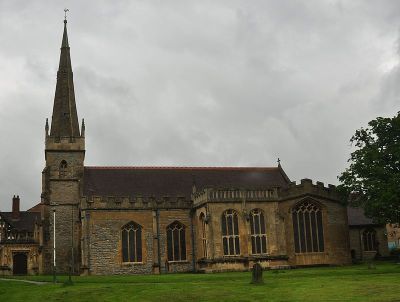 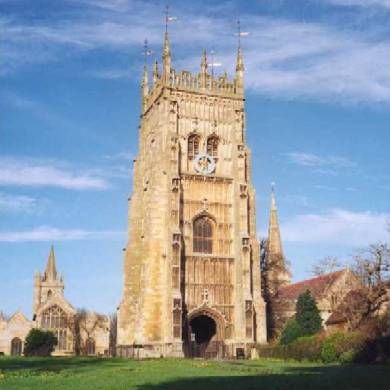
|
Thomas' widow, Francis Albright Wells, then married Thomas Coleman [Coalman]. There has been some confusion when and where this occurred. It had been said that Thomas Coleman's first wife died in Wethersfield, Connecticutt in 1642, afterwhich he married Francis. However, the following seems to refute this.
"The marriage took place before 6 March 1638 when it was noted in the inventory of Frances's brother Richard Albright that his estate owed the sum of £3 10s "to Thomas Coalemans Children." The children in question were doubtless Coleman's Wells stepchildren." - Douglas RichardsonThe problem may be a multiplicity of Thomas Colemans in New England at this time.
Thomas Coleman, his wife, and children, including the Wells children, then emigrated to America. This occurred sometime before 1639 when Thomas Coleman was a Selectman in Wethersfield, Connecticut. For his time in Wethersfield I have,
"Coleman, Thomas, was an early settler at Wethersfield, Conn.; appointed by the particular court, with Francis Norton, to appraise damage done in a field of corn, 1639; juror, Oct., 1644 ; defendant in court, 1643. In 1645, he with Nath'l Dickinson, were appointed by the P. court to take the particulars of the estate of Mr. Parksman, then deceased, and return the same to the court. Defendant in court May 19, 1647. In 1654, was appointed by the Gen. Court, with Edward Stebbing, to draw rules for sealing leather, and deputy the same session. At the Gen. Court, March, 1657-8, he was freed from watching, warding and training, if he proved he was over sixty years of age. He was juror Dec., 1641 ; Sept., 1645 ; Oct., 1645 ; Dec., 1647 ; four sessions in 1648 ; representatives to the Gen. Court four sessions in 1650 ; in May, 1651 ; May, 1652 ; also in June, Sept., Oct. and Feb., 1652 ; April, August and Sept., 1653, and repeatedly afterward. Few if any gentlemen in the colony was as frequently a member of the Gen. court as Mr. Coleman ; few sustained a higher reputation in the colony. Oct. 3, 1654, he and Mr. Hollister and Nath'l Dickinson, of Wethersfield, were appointed to join with the Dep. Gov., to see to the pressing of men and procuring necessaries in Wethersfield, to attend the expedition to Narragansett in the Ninigret war. Thomas Coleman, of Marlborough, England, farmer, embarked at Hampton [Southampton?], in the James, of London, for N. E., about April, 1635. He took charge of Ab'm Easton's estate until the court settled the administration, March, 1647.* He was much given to litigation, as many of the early settlers were. He was appraiser of John Cattell's estate, dec'd, of Wethersfield, July 17, 1644." - from "A Catalogue of the Names of the Puritan Settlers of the Colony" by Royal Ralph Hinman* A fellow researcher, Susan Coleman Williams, writes,
". . . from what I've found, Royal Ralph Hinman confused our Thomas Coleman with another Thomas Coleman who was from Marlborough, England and settled in Nantucket. I found another source, tracing the ships, which states that our Thomas Coleman's (and the rest of his blended family) ship was not found."Ninigret was the sachem of the Niantic tribe. While he allied with the colonists against the Pequot Indians in 1637, in "September 1654, the commissioners [in Boston] sent a message to the chief demanding his appearance in Hartford where they were convened, and also the payment of tribute that had long been due. He refused to appear, and sent them a haughty answer. War was again declared against him, and 270 infantry and 40 horsemen were raised and placed under the command of Major Samuel Willard. His instructions were to go to Ninigret's quarters, demand the tribute, and insist upon a cessation of the war with the Long Island Indians [who had placed themselves under the protection of the colonists]. On the approach of the troops, Ninigret fled to a distant swamp and was not pursued." - from Wikipedia.
| Wethersfield, Connecticut
"Founded in 1634 by a Puritan settlement party of "10 Men" including John Oldham, Robert Seeley, Thomas Topping and Nathaniel Foote, Wethersfield is arguably the oldest town in Connecticut,[5][6] depending on one's interpretation of when a remote settlement qualifies as a "town". Along with Windsor and Hartford, Wethersfield is represented by one of the three grapevines on the Flag of Connecticut, signifying the state's three oldest European settlements.[7][8] The town took its name from Wethersfield, a village in the English county of Essex. During the Pequot War, on April 23, 1637, Wongunk chief Sequin attacked Wethersfield with Pequot help. They killed six men and three women, a number of cattle and horses, and took two young girls captive. They were daughters of Abraham Swain or William Swaine (sources vary) and were later ransomed by Dutch traders.[9] Four witch trials and three executions for witchcraft occurred in the town in the 17th century. Mary Johnson was convicted of witchcraft and executed in 1648, Joan and John Carrington in 1651.[10] Landowner Katherine Harrison was convicted, and although her conviction was reversed, she was banished and her property seized by her neighbors." - from Wikipedia 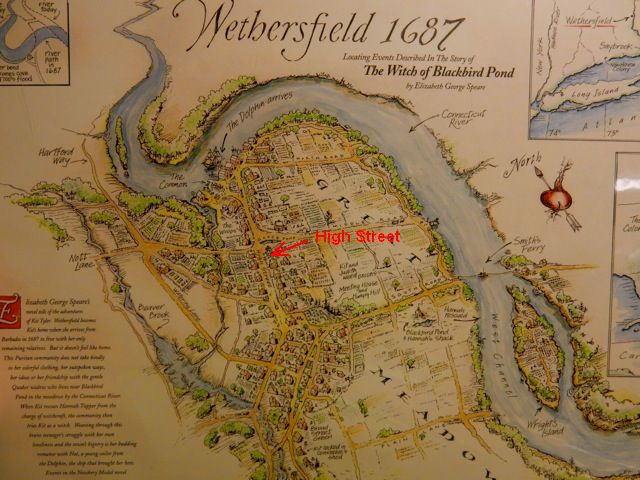 |
"On 3 October 1646 Thomas Coleman gave a power of attorney: . . . unto Captain Robert Harding of Boston "to aske &c ail writeinges touching his house in Esstum [sic; surely Evesham] in the County of Worcester wch are in the hands of John Albright or any other, & to said house do lett or sell & make seale & Deliver deeds or writeings of the same, & to receive the rent for the time past due; also to receive the Reminder of a Legacie in the hands of John Norton of Cotherstock Esq granted by the will of John Coleman of Cotherstock." - from "Cookie Crumbs Ancestry"
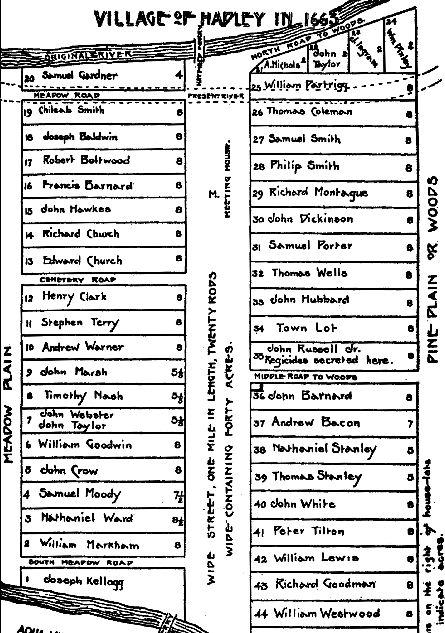 In the 1650's a portion of the Wethersfield Congregationalist Church became involved in a long running controversy. The dispute was caused by the liberalization of the requirement that stated only parents that had both taken communion should be allowed to have a child baptized and allowed non-communicants to vote. This issue had first arisen in the Hartford church where the contrary personalities of their pastor, the Reverend Samuel Stone, and the Ruling Elder, William Goodwin, increased the rancor. The Reverend Stone was aligned with the change while Mr. Goodwin, and the pastor of the Wethersfield church, the Reverend John Russell, were opposed. The dispute, however, became wide-ranging as tempers were inflamed. So irreconcilable did the feud become that the issue was eventually taken, on 20 May 1658, to the General Court to adjudicate. The court ruled that although Reverend Stone had been too strict in ignoring the majority of their parishioners, they were right in liberalizing the baptism ritual. It was also found that those members who disagreed could remove themselves to a location in Massachusetts to practice how they saw fit. Anticipating this decision, members of the congregations of the Hartford and Wethersfield churches, including Thomas Coleman and Thomas Wells, had met to discuss the issue at Goodman Ward's house in Hartford on 18 April 1659. There they entered into a compact.
In the 1650's a portion of the Wethersfield Congregationalist Church became involved in a long running controversy. The dispute was caused by the liberalization of the requirement that stated only parents that had both taken communion should be allowed to have a child baptized and allowed non-communicants to vote. This issue had first arisen in the Hartford church where the contrary personalities of their pastor, the Reverend Samuel Stone, and the Ruling Elder, William Goodwin, increased the rancor. The Reverend Stone was aligned with the change while Mr. Goodwin, and the pastor of the Wethersfield church, the Reverend John Russell, were opposed. The dispute, however, became wide-ranging as tempers were inflamed. So irreconcilable did the feud become that the issue was eventually taken, on 20 May 1658, to the General Court to adjudicate. The court ruled that although Reverend Stone had been too strict in ignoring the majority of their parishioners, they were right in liberalizing the baptism ritual. It was also found that those members who disagreed could remove themselves to a location in Massachusetts to practice how they saw fit. Anticipating this decision, members of the congregations of the Hartford and Wethersfield churches, including Thomas Coleman and Thomas Wells, had met to discuss the issue at Goodman Ward's house in Hartford on 18 April 1659. There they entered into a compact.
"At a meeting at Goodman Ward's house, in Hartford, April 18th, 1659, the company there met engaged themselves under their own hands, or by their deputies, whom they had chosen, to remove themselves and their families out of the jurisdiction of Connecticut into the jurisdiction of the Massachusetts, as may appear in a paper dated the day and year abovesaid. The names of the engagers are these:--In doing so they earned themselves the title of "the Withdrawers." Fifty nine families, headed by Governor John Webster of Hartford, did leave, moving up the Connecticut River to found the Church and town of Hadley.
. . .
Thomas Coleman
. . .
Thomas Wells
. . .
Richard Montague
. . .
1st. We whose names are above written do engage ourselves mutually one to another, that we will if God permit, transplant ourselves and families to the plantation purchased, on the east side of the river of Connecticut, beside Northampton, therein to inhabit and dwell by the 29th of September come twelve months, which will be in the year 1660.
2d. That each of us shall pay the charges of the land purchased according to his proportion, as also for the purchase of Hockanum [the meadow].
3d. That we will raise all common charges, of what sort soever, for the present, upon the land that men take up: mow, plow land and house lot, according to the proportion of land that each man takes of all sorts; and all charges shall be paid as they shall arise and be due, from the date hereof.
4th. That if any persons so engaging be not inhabiting there by the time aforesaid, then, notwithstanding their payment of charges, their lands and what is laid out in rates shall return to the town: and yet this article doth not free men from their promise of going and inhabiting.
5th. That no man shall have liberty to sell any of his land till he shall inhabit and dwell in the town three years; and also to sell it to no person, but such as the town shall approve on.
. . ." - from the "History of Hadley" by Sylvester Judd
A committee of the signers of the agreement were directed to go to the new town site "on the east side of Northampton and lay out the number of 59 homelots and allow 8 acres to every homelot." This was done some time in the early summer of 1659, and the occupation of the new settlement soon followed. When their church was recovenanted, John Russell of Wethersfield was chosen Pastor and William Goodwin of Hartford its Ruling Elder. - from "The Goodwins of Hartford, Connecticut, Descendants of William and Ozias Goodwin" compiled for James Junius Goodwin.
The Wells and Coleman families moved to Hadley, Massachusetts in 1659. Hadley is on the east bank of the Connecticut river, in a bend of the river. Thomas Coleman was one of the original 59 founding members of the town which, like so many communities in New England, was created out of religious discontent. On the plat map of Hadley, to the right, Thomas Coleman's homesite was three sites above that of Richard Montague and six above that of his step-son, Thomas Wells. Note that Thomas Wells' brother, John, settled in Hatfield. Hadley originally covered a wide expanse, including across the river where some lots were granted. This evenually became Hatfield. This was not the only occassion when a family member settled in Hatfield. Ozias Goodwin, the Elder's brother, also had a lot on the west side of the river.
I have to pause and mention how amazing the coincidences of life are that the Montague and Wells families that would be united in the 20th century in the marriage of my wife's grandparents, both lived in the same small village in colonial New England.
Thomas Coleman died in Hadley on 1 October 1674, aged about 75. He was buried in the Old Hadley cemetery.
"Thomas Coleman left a will dated 29 September 1674, which named his wife Frances, his own children including £60 to daughter Deborah, and an important provision for his stepson, Thomas, and his son John:"To my son in law Thomas wells I give all my part of that which is in England due to me for the Rent of the House at Evesham & two his son John Wells now dwelling with me £10 Provided that both these last are given with this Proviso that all writeings Respecting the house in England & any Exchange for it here be quietely Delivered in & all Pleas Concerning those matters to cease according to the last agremt novem: 2d 1670." witnessed by Rebecca Russell and Mary Wattson, the Inventory was taken by Richard Godman, Petter Tilton, and John Smith.Interestingly, Thomas Coleman was leaving to his stepson Thomas, the house in England that the elder Thomas Wells had left to young Thomas, but only after the death of Frances. The agreement Thomas Coleman referred to probably somehow took care of that complication.
As Jacobus and Wood sumarized it:"Evidently there had been negotiations looking to the disposal of the English realty, culminating in an agreement made 2 Nov. 1670. The "Exchange for it here" suggests that a purchaser in England was to send goods of a more movable type, and the rents which Thomas Wells was to receive, as well as the £10 given to Thomas's son John, were made contingent on this agreement being carried out. Also any litigation ("Pleas") would have to cease."Jacobus and Wood went on to suggest this was a "clue which should be followed in English records by those interested in the orign of either the Coleman or the Wells family." It would be 40 years before [Douglas] Richardson followed up and published his own findings." - from "Cookie Crumbs Ancestry"
Francis Albret Wells Coleman died shortly before 26 March 1678, in Hadley, when her undated will was proved. Francis bequeathed her property to the family of her son, Thomas Wells (he predeceased her in 1676), to her son, John Welles, of Hatfield (and his children), and to her daughter, Mary Wells Gilbert. Frances appointed her grandson, Jonathan Gilbert Jr., the executor of her will. Another point, in the will of Frances [Wells] Coleman she leaves to her son John Welles "my grate Bible". Her will,
"Frances Albright left an undated will, proved 26 March 1678 by the witnesses, Francis Barnard and Samuel Northam, giving:
to daughter Mary Wells, £6;
to son John Wells, £6;
to daughter Gilburt, £6;
to grandchildren Jonathan & John Wells, each 10s.
to son John Wells (his son) [i.e., John Wells Jr.] and to my grandson Thomas Wells a two and twentie shilling peice of gold to be equally divided between them;
to daughters of son John Wells Sarah & Mary, 10s. each;
to daughter Mary Wells that peice of stuff or searge I formerlie lent her husband;
to son John Wells his wife my best red petticoate & soe much of my other cloathes as shall make that coate equal or equivlent to the peice of Stuffe or searge that I gave to daughter Mary Wells;
to daughter Deboro [Coleman] my greene apron & two other aprons & some of my weareing Lining as alsoe my muffe as alsoe Penestone to maker a pettecoate;
the rest of the Penestone I give to son John Wells;
to daughter Deboro one iron pott;
to son John Wells my grate Bible;
to daughter Deboro that peice of searge in the chest as also woolen yarn that is the house;
to daughter Mary Wells my grate cheste;
to the wife of my son John Wells and to my daughter Mary Wells all the rest of my cloathes both woolen and lyning that is not before mentioned equally between them;
the rest of my estate that is not mentioned I give & bequeath to my son John Wells & to my daughter Deboro to be divided equally between them -- John shall have a double part with the Rest out of my estate;
my beloved son Jonathan Gilburd executor
A few notes may make this will somewhat clearer. In this time, it was common to use "his" in the possessive case, thus "John Wells (his son)" means "John Wells's son," and "John Wells his wife" means "John Wells's wife." Also, Penistone is a coarse woolen cloth that came from Penistone, England. The daughter Mary Wells was widow of Frances' son Thomas who had died about a year and half before Frances made her will." - from "Widow Frances Wells and Hugh Wells of Wethersfield" by Donald Lines Jacobus and W. Herbert Wood in The American Genealogist 28, Oct 1952: 227-235.
This family is in no way related to Governor Thomas Welles of Connecticut, another well researched line.
| Governor Thomas Wells
Thought at one time to be the brother of 'Hugh' Wells, the supposed forebear of our Wells family. He was born in 1598 in Essex county, England. His properties there were confiscated for political reasons of an uncertain nature. He came to America in 1636 as secretary to Lords Say and Brooke, and located at Saybrook, a fort at the mouth of the Connecticut river named for the two Lords. In the following year he was a magistrate at Hartford, where he continued to fill that office for twenty two years. In 1654 and in four other years he was Deputy to the General Court. From 1655 to 1658 was Governor of the Connecticut Colony. He also held other offices of trust and honor. He died on 14 January 1660 at the age of 62 and was buried in Hartford. He married Elizabeth Hart, who died in 1640. |
The children of Thomas Wells and Frances Albright, all of which, except Sarah, were named in Frances [Albright Wells] Coleman's will, proved 26 March 1678, along with her daughter Deborah Coleman, were,
(18) Thomas Wells (1620/8)
(18) Mary Wells (1630)
(18) Sarah Wells (c1632), who died young
(18) John Wells (1635/6)
It is with this Thomas Wells that the genealogies of Hugh Wells of Colchester, Essex and the competing vision of Thomas Wells of Evesham, Worcestershire unite. In both versions Thomas dies in the village of Hadley, Massachusetts in 1676.
Thomas Wells, the son of Thomas Wells and Frances Albret, was born in Evesham, Worcestershire in 1620, or 1628 depending on your source. Thomas Sr. died in 1637. His will stated,
"Next I give to my eldest son Thomas 20 pownd to be paid at the age of 21 yeares and my house after the death of his mother."Thomas' mother then married Thomas Coleman in 1638. The family then emigrated to Wethersfield, Connecticut, perhaps in 1639, but certainly in the early 1640's. They were amongst the earliest settlers in that colony.
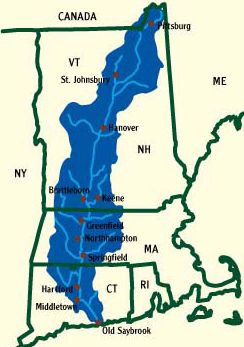 The Connecticut Colony The Connecticut Colony
Connecticut was founded by colonists of Massachusetss who, living in a relatively barren coastland, looked to the fertile valley of the Connecticut river for expansion. The father of Connecticut was Thomas Hooker. A pastor driven from England by Laud, he arrived in Boston in 1632. In June 1636 Hooker and his entire congregation resettled in Hartford, close to the mouth of the Connecticut river. At about the same time other congregations from Dorchester and Watertown founded the towns of Windosr and Wethersfield. Within a year eight hundred people had found their way into the valley. The settlers of these three communities formed an independent colony and approved the first written constitution in the American colonies. The Connecticut river provided a highway into the rich agricultural interior of New England. |
Thomas married Mary Beardsley, the daughter of William Beardsley and Mary Harvey, of Stratford [Hartford], Connecticut, in May 1651 in Wethersfield, Hartford county, Connecticut. Mary was born in 1631 [1636?] in Ilkeston, Derbyshire and emigrated to Massachusetts with her parents in 1635.
The whole Wells/Coleman family moved north to Hadley sometime around 1660. Thomas Wells and his step-father Thomas Coleman are amongst the 59 founding members of that village. See the plat map of Hadley, above, for Thomas' home site, three home sites below that of Richard Montague and six below that of his step-father, Thomas Coleman.
Thomas and Mary had 16 children, five while living in Wethersfield and the remainder after they moved to Hadley.
Thomas would have inherited his share from his father's estate upon the death of his mother, Frances, in 1678. However, he predeceased her in 1676. There is a clause in the will of Frances's second husband, Thomas Coleman, dated 29 September 1674, that bears on this. In it Thomas Coleman gave,
"to my son in law [i.e. stepson] Thomas Wells ... all my part of that which is in England due to me for ye Rent of ye House at Evesham & two [to] his son John Wells now dwelling with me £10 Provided that both these last are given with this Proviso that all writeings Respecting ye house in England & any exchange for it here be quietely delivered in & all Pleas Concerning those matters to cease according to ye last agremt. Novem: 2d 1670."I believe this indicates that Thomas and John had concerns with the way Thomas Coleman was administering their father's bequests, on behalf of their mother.
Thomas died in Hadley, Massachusetts around Between 30 September and 14 December 1676, supposedly as a result of wounds received at the Battle of Bloody Brook. I do have a reference in the "History of Hadley" that says Thomas Wells of Hadley was in the "falls-fight" of 19 May 1676. This was an attack on an Indian village and rendezvous for raiders that became a massacre and then a rout when fresh Indian forces cut off the colonists' retreat.
Mary subsequently married Samuel Belding [Belden] Sr., of Hatfield, the father of eight children whose wife had been killed in an Indian raid. Mary died in Hatfield on 20 September 1691.
Thomas Wells and Mary Beardsley's children were,
(19) Lieutenant Thomas Wells (1652), was born on 10 January 1652 in Wethersfield, he moved to Deerfield, volunteered under Captain Holyoke at the Falls Fight in 1676, he died before 2 December 1691 in Deerfield
(19) Mary Wells (1653), born on 1 October 1653 in Wethersfield
(19) Sarah Wells (1655), born on 5 May 1655, she married David Hoyt, she died in 1676 in Deerfield
(19) John Wells (1656/7), born on 14 January 1656/7 in Wethersfield, died young
(19) Captain Jonathan Wells (1658), born between 1658 and 1659 in Wethersfield. He was a boy hero of the Turners Falls fight. Moved to Deerfield. He married Hepzibah Colton of Springfield, Mass.; the couple had two sons, one of whom died in infancy. He died on 3 January 1738/9.
(19) John Wells (1660), born 3 April 1660 in Hadley, drowned in the river at Hatfield Town 20 January 1679/80
(19) Samuel Wells (1662), born in about 1662 in Hadley, he died on 9 August 1690 in Hatfield
(19) Mary Wells (1664), born on 8 September 1664, married Stephen Belding, second married Capain Joseph Field, she died on 15 March 1751 in Northfield
(19) Lieutenant Noah Wells (1666), born on 26 July 1666 in Hadley, removed to Hatfield, married Mary White in 1685 in Hatfield [note that Daniel White Jr. and John White Jr. lived in Hatfield at this time], died 12 June 1712 in Colchester, New London county, Connecticut. The following refers to King William's war, 1688-1698.
"February 25, 1689/90, Hatfield voted that three or four houses should be "well and strongly fortified . . ." A fortification of palisades was ordered from the south side of John Field's and Thomas Hasting's home lots (the same as the south line of fortifications in King Philip's war) to the north side of Noah Wells's and Samuel Marsh's (opposite the Deerfield lane). . ." - from "A History of Hatfield, Massachusetts," pg 117, by Daniel White Wells and Reuben Field WellsDeerfield lane was probably today's North street, which is above School street (then known as Middle lane). Samuel Marsh's lot was the fourth above that of John Wells. Noah's children were,
"Betsey Wells b.15 April 1757 Colchester, died 1820 Burlington Flats, Otsego, NY- (20) Hannah Wells (1697)
Father: Lt. James M. Wells, b 1732 in Colchester, died in the Wyoming Massacre in PA 1778
GFather: Jonathan Wells b. Hatfield? died 1756 in Colchester
GGFather: Noah Wells b. 1666 (Hatfield, Hatley, Deerfield MA, died 1712 in Colchester
You have both Jonathan and Noah listed on page 6/48 in your history.
While some of both Coleman and Wells Families stayed in the Hadley MA area, others moved to Colchester, CT. Thomas Coleman and Thomas Wells (his stepson) are near neighbors in the 1663 map of Hadley. Stepbrothers John Coleman and John Wells lived near each other when nearby Hatfield was founded. And when Noah Coleman relocated to the newly founded Colchester (with a half brother, Ebenezer Coleman) to Colchester, Noah Wells relocated also. Yikes, the names Thomas, John, Noah etc. etc, keep reappearing each generation!
Betsey brought the Wells/Coleman connection together when she and Jason Coleman married in Colchester.
Going down the Rabbit Hole of what Thomas Coleman was doing in England before he married Frances Albright Wells remains a big mystery. Surprisingly, there is no record found yet of who his first wife, the mother of his first four children, was and where she died. I have hopes that somewhere in England is the link. My Brother, John Coleman, and I have found key Family information by digging in rural courthouses etc., and know that what has been collected on the Internet is not the whole story. So, we pick up peripheral threads and hope to connect them.
in regards to your history, on page 2/48, I think you need to add Thomas and Francis' first son, Thomas Wells, to the list of their children. He had to have been born before 1630.
And, from what I've found, Royal Ralph Hinman confused our Thomas Coleman with another Thomas Coleman who was from Marlborough, England and settled in Nantucket. I found another source, tracing the ships, which states that our Thomas Coleman's (and the rest of his blended family) ship was not found.
No matter what, Family Search remains very interesting. I am constantly amazed that ANY records survive during this dramatic time in History.
Regards, Susan Coleman Williams"
"Ebenezer, s. of Thomas (2), was b. July 20, 1669, in Hat. He m. (1) Dec. 4, 1690, Mary, dau. of Benjamin Waite. She was one of the captives taken by the Indians Sept. 19, 1677. She d. abt. 1704. He m. (2) Aug. 15, 1705, Sarah, wid. of John Lawrence (who was slain by the Indians at Brookfield, 1694). She was dau. of Samuel Smith of Hat." - from the "History of Hatfield, Massachusetts" by Daniel White Wells and Reuben Field WellsEbenezer's children were,
She was baptized in St. Lawrence Parish, Evesham, Worcestershire, England, on 15 July 1630. She came to America with her mother and step-father around 1639. She married Johnathan Gilbert,the son of Thomas Gilbert and Elizabeth Bennett, in 1650. It was his second marriage. He was born in Yardley, Worcester county, England, on 8 June 1617 and died in Hartford, Connecticut on 19 December 1682. Mary died in Hartford, Connecticut, on 3 July 1700, aged 74. It was said of her that she was a keen and practical woman with an eye to business. In this she was like her husband. The two were well mated and worked together for common ends and had common ambitions. They had considerable commercial success and rose in both official and social status. They had eight children. Jonathan and Mary were the grandparents of Jonathan Belcher, Governor of Massachusetts and later of New Hampshire, and ancestors of Noah Webster, noted American author and lexicographer.
(18) Sarah Wells (1632)Sara, the daughter of Tho. Weles, was baptized in the St. Lawrence Parish church, Evesham, Worcestershire, England, on 10 Feb 1632/3. Sarah, the daughter of Thomas Wells [Wills] died in Evesham in June 1636 and was buried at All Saints Parish church.
(18) John Wells (1635/6)Anita's 7th Great-Grandfather. Also as Welles. John Wells, the son of Thomas Wells, was born in Evesham, Worcestershire and baptized in the All Saints Parish church of Evesham on 20 February 1635/6 - from numerous second-hand sources, "The Widow Frances (Albright) Wells, Wife of Thomas Coleman of Wethersfield and Hadley," "Coombs Family History," the "Wells Family Research Association" and per All Saints, Evesham parish register, as cited in Douglas Richardson, "Wells and Albright," NEHGR, 146(1992):298 (FHL #974 B2ne). Alternately, he was born in 1628 per the "History of Hatfield, Massachusetts."
John's father died in 1637. From his father's will,
"Item I give to my daughter Mary 30 pownd likwise to my son John 30 more but if my wife be with child and it live then it is my will that 10 pownd a pece shall be taken from John and Mary and given to it and it is my will that my son John shall be paid at the age of 21 yeare and my daughter Mary at hur day of mariage or at the age of 21 yeares: but if they prove stouborne and dissobedent then it shall be left to the will of thir mother and the overseers when they shall have it . . ." - from "The American Genealogist" Volume CXLVIHis mother then married Thomas Coleman and the whole family moved to America, sometime before 1639. They settled in Wethersfield, Connecticut. John purchased a house at Wethersfield from his step-father, Thomas Coleman - from Douglas Richardson.
John Wells married Sarah Curtis [Curtiss], the daughter of Capt. William and Mary Curtis, in 1658 in Stratford, Fairfield county, Connecticut. Sarah was born on 10 October 1642 in Stratford. In some documents she is referred to as Sarah Fellowes [a previous marriage?]. As early as 1650 William Curtis was commissioned an officer of the Train Band of Stratford, that is, of a trained band of soldiers.
|
(17) Captain William Curtis (1618) (16) John Curtis William was born in June 1618 and baptized on 21 June 1618 in Nazing, Essex, England. A proprietor of Stratford, Fairfield county, Connecticut. "Curtis, William, S. of John. Deputy for Stratford [to the Connecticut Colony Court], Oct. 1667, May and Oct. 1668, May and Oct. 1669, May and Oct. 1670, May 1671 (called Lt. Joseph by error), May and Oct. 1672, May and Oct. 1673, May and Oct. 1674, May and Oct. 1675, Oct. 1676, May and Oct. 1677, May and Oct. 1678, May and Oct. 1679, May 1680, Oct. 1681, May and Oct. 1682, May, July and Oct. 1684, May 1685, Oct. 1686, Jan. and Mar. 1687, May and June 1692. Commissioner for Stratford, 1671-75, for Stratford and Woodbury, 1676-79, for Stratford, 1680-87, 1689-97. Ca1led Lt., Oct. 1667; Capt., Stratford Trainband, June 1672; Second Military Officer, Fairfield County, June 1672; Capt., Fairfield County Troop, Nov. 1673, Oct. 1675; Militia Committee, June 1672; War Committee, Aug. 1673." |
The following is from a biography of John Wells.
"John Welles first appears in Stratford, Connecticut. There he married Sarah Curtis. Two children were recorded to "John Welles" in Stratford, the name of their mother not being stated: Sarah and Mary. The birth of the next child, Abigail, missed recording. The family moved after the deed of 1662 to Hatfield, Massachusetts, and the births of six younger children are given in Judd's "History of Hadley," Appendix, p. 150. John Welles is there stated to have died on 18 October 1692 and his widow Sarah, in about 1743. The first five children were daughters and the first son was John, born on 15 September 1670. This source names only the 3 daughters and one son, which leaves 5 children unnamed." - from "The American Genealogist Vol. 28:230"The "deed of 1662" refers to,
"That John Welles married Sarah Curtis is shown by a deed made 15 April 1662 to "my Unckle John Curtise of Stratford" of half the dwelling house "I now liue in," Jonathan Curtis owning the rest "by gifte of his grandmother." Jonanthan's father, Capt William Curtis [Sarah's father], gave bond that Jonathan would confirm the deed when he came of age. The reference to the gift of the grandmother was to the 1658 will of widow Elizabeth Curtis whereby she gave an interest in her house and lot to her grandchildren to Jonathan and Sarah Curtis. For John Welles to sell that interest, he had to have been the husband of Sarah." - from "Cookie Crumbs Ancestry"
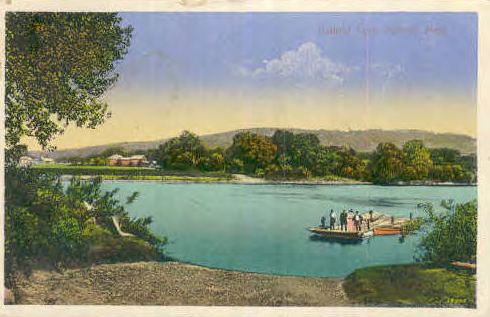 This deed is recorded in Stratford Deeds, 1:192 (FHL #005770).
This deed is recorded in Stratford Deeds, 1:192 (FHL #005770).
After the move north, circa 1663, John Wells lived on the west side of the river, across from present-day Hadley. There was a ferry at the north end of the Hadley town commons that connected with properties granted directly north of that town. To the right is a print at the ferry crossing from Hadley circa 1850.
On 21 Janaury 1661 a committee was appointed "to lay out a tract of land on the West side of the river for houselots." A road (the southern end of today's Main street), 10 rods wide, was surveyed that spring running north/south for about a mile. The lots on the east side of that road backed onto the river. The map below shows the street as it was in 1873. A space for a common was reserved at the south end. The southern part of the village, that directly across from Hadley, was low lying and subject to flood. Common land for mowing and tilling was in the meadow called the Great Ponsett. Woodland lots were divided for timber and hunting north of the settlement. Additional common land was laid out west of the Mill river.
"The committee made allotments to 28 individuals of 192 acres on both sides of the street. All the lots on the east side were 16 rods wide except that of John Wells, which was 18 rods. The proprietors in order beginning at the south were Thomas Bull, Daniel Warner, Richard Billings, Nathaniel Dickinson, Jr., John White, Jr., Edward Benton, Samuel Dickinson, William Gull, Samuel Belding, John Coleman, John Wells, Samuel Gillett, Philip Russell." - from "A History of Hatfield" by Reuben Field Wells
Until 1668 the residents had to cross the Connecticutt river for church services and town meetings. In that year they built a meetinghouse on their side of the river. A survey of Hadley, including the land on the west side of the river, was taken in 1668.
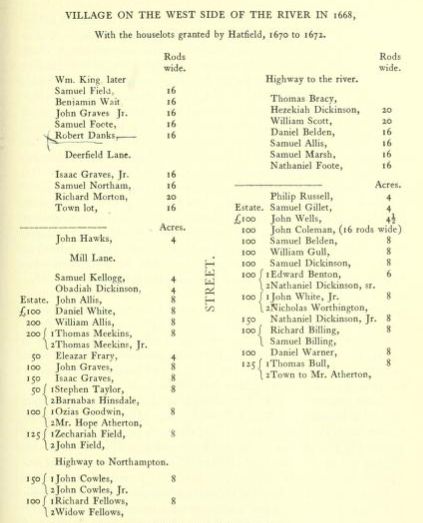
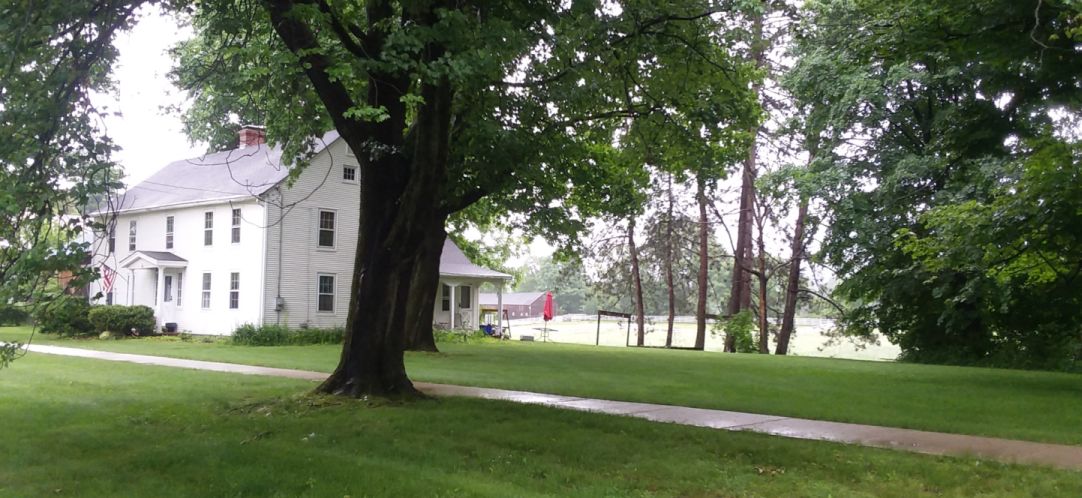
A burial ground of their own, today's Hill cemetery, was established in 1669. The earliest markers were made of wood and have not survived. The earliest stone monuments date to the 1690's.
| The Town of Hatfield
The area around Hatfield, like Hadley, had been farmed by the Indians and the land, replenished by flooding of the river, was fertile. The nearby forests had been kept free of underbrush by annual burnings by the Indians. |
The land around Hatfield was low-lying and prone to flooding by the Connecticutt river. While this caused problems to the early colonists, it greatly enriched the soil. A drainage system was developed later and, finally, a dike. The farmers of Hatfield crew corn, winter and summer wheat, and peas, raised cattle, and traded their farm products with Boston and Springfield.
Here's another historical note of interest: Europeans were amazed at the fecundity of the colonial settlers. I think there are several reasons for the very large, surviving families. One was that, having moved out of established cities & towns of England with their decades of accumulated filth, the climate was healthier. Second, land was abundant, again so unlike England, so parents felt more free to have large families and food was available to feed them. To this latter point should be added the incredible plenty of the virgin forests, rivers and ocean. There is a story that the fish were so plentiful that the first fisherman on the Grand Banks used baskets to scoop them up. Likewise it was easy to find game in the forests. The American population increased at a far greater rate than anyone in England had thought possible.
In 1670 Hatfield became a separate parish and town from Hadley. The original limits of Hadley were quite extensive, including today's Hatfield, Amherst, Granby and South Hadley. There continued, however, to be disputes between Hatfield and Hadley over ownership and the right to tax.
In 1675 the house lots at the upper end of the street were,
West side........Street.....East side
----------------...............Samuel Allis
Deerfield Lane...............Samuel Marsh
----------------...............Nathaniel Foote
Isaac Graves Jr..............Philip Russell
Samuel Northam............Samuel Gillett
Richard Morton..............John Wells
...............Blacksmith's shop
Town lot.......................John Coleman
John Hawkes.................Samuel Belden
----------------
Middle Lane
----------------
Below is a 19th century map of the town. Note that School street was originally known as Middle lane. To confuse matters even more, the latter road was also called Mill lane, since it lead to the mill on today's Prospect street.
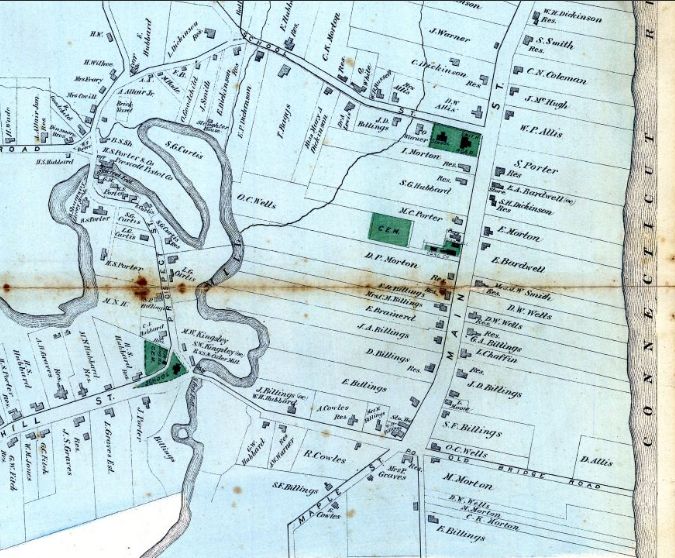
The D. W. Wells, in the map above, was Daniel White Wells. He, along with his son, Reuben Fleet Wells, were the authors of "The History of Hatfield, Massachusetts." His houselot was that of John White Jr. circa 1668.
"Of John White, Jr., not very much is known . . . His house lot was the next above that of Nathaniel Dickinson, now owned by Daniel White Wells, who is not, however, a direct descendant."Daniel White was a descendent of the Thomas Wells of Hadley family, via his youngest son, Joshua.
John Wells' houselot of 1670/75 probably corresponded to that of C. N. Coleman in the map of 1873.
During King Philip's War, which began in 1675, the town of Hatfield was attacked several times. While the town had a palisade built around it, not all the houselots were protected. The northern wall ended just beyond Samuel Dickinson's lot, meaning that John Wells' home was not protected - from "A History of Hadley."
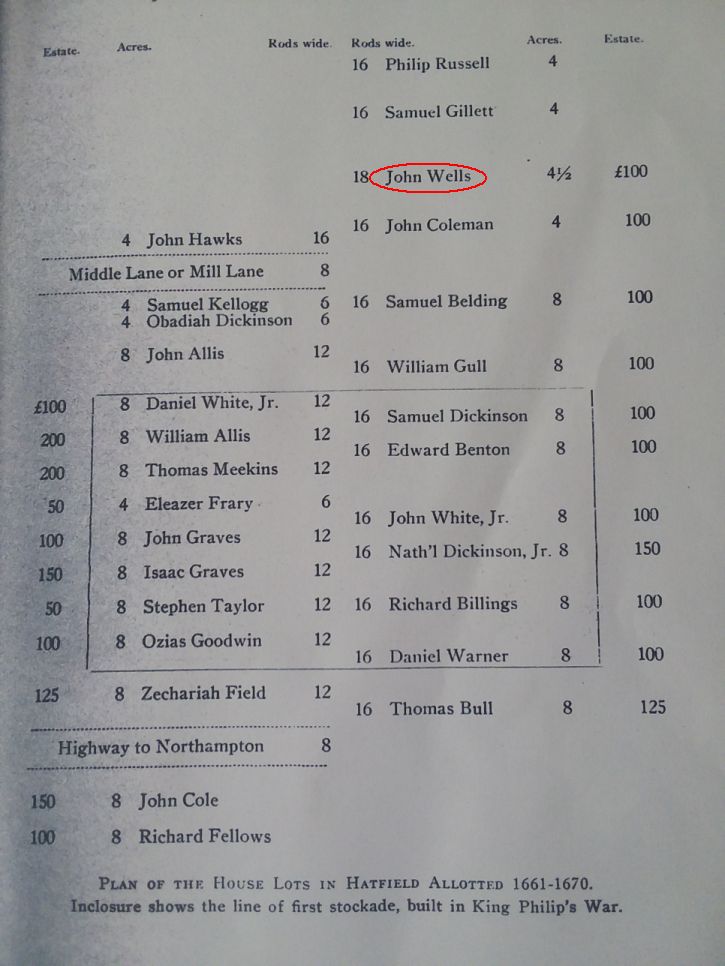
An attack had been driven off after a couple of hours of fighting in October 1675. In March 1676 another attack was beaten off. After a retalitary raid went badly, 700 Indians attacked Hatfield on 30 May 1676. Unable to face such a large force, the colonists withdrew inside their stockade leaving the Indians to plunder and burn all the houses and barns outside. This probably included John Wells' place.
In October 1677 Hatfield was again attacked, this time with the element of complete surprise. Most of the men of Hatfield were working in the meadows cutting corn, south of the stockade, and many families were left outside. The house of John Coleman, John Wells' next neighbor, was burned and his wife and child killed. Two others were captured. John Wells' wife, Sarah, was tomahawked by the Indians, but survived her wounds. One his daughters was wounded and another, Elizabeth, aged 2, was killed. John's other neighbor, to the north, Samuel Gillett, had been killed at Turner's Falls. His widow, Hannah was made prisoner with two of her children.
"The persons killed, taken and wounded, at Hatfield, Sept. 19, 1677, were as follows:--Seventeen captives had been taken and were marched north. It was the most destructive raid the village was to know.
Killed.-- . . . Elizabeth Wells, aged two years, daughter of John Wells . . .
Wounded.-- A child of John Coleman; wife and daughter of John Wells; wife of Obadiah Dickinson." - from the "History of Hadley" by Sylvester Judd
John Wells' only son at the time, John Jr., was 7 years old. He may have been old enough to be away from home, helping his father.
| King Phillips War, 1675-1677
Massosoit, the chief of the Wampanoags died in 1662, as did his eldest son, Alexander. In that same year his second son, Philip, assumed leadership of the tribe. Unlike his father, he was set on war in a final attempt to drive the English colonists out of the bay colony. Hostilities began in 1675. While many tribes took part, the Mohawks, importantly, did not. Bodies of men from all of the villages of the Connecticutt river valley, including Hatfield, took part in various scouting expeditions and pursuits of the hostile Indians. However, in the main the colonists took a defensive posture.
In March of the next year Hatfield was attacked by force of Indians that had just been repulsed at Northampton. These were driven off by the two companies of militia still hosted by the town. The Indians remained in the area another two days, but after failing in a second attack on Northampton, they returned north. An empty mound on the south east side of the Hill cemetery in Hatfield is where 25-30 Indians were buried who were killed in the attack on Hatfield in 1676. The rest of the year was spent by the colonists in strengthening their fortifications. The stockade at Hatfield protected more than half of the houses built at that time. Those living outside brought their families inside at night during times of trouble. While the attacks on Northampton and Hatfield had been defeated, widespread attacks on the rest of the bay colony resulted in a panic and a withdrawal of troops to protect eastern villages. In April Hatfield had only 45 troops garrisoned. In May the Indians raided the North Meadow of Hatfield, carrying off 70 or 80 head of stock. In retaliation a force of 141 men were gathered at Hatfield to attack Indian villages to the north at Turner's Falls. While successful, the raiders were subsequently overtaken by a superior force and nearly a third of the men who set out were lost in a running fight. Jonathan Wells, the nephew of our John Wells, gained notariety for his brave conduct in this debacle. At the end of May the Indians again attacked Hatfield with a force estimated at 700 men. The inhabitants withdrew within their stockade while the Indians plundered and burned the houses and barns outside. The last attack took place at eleven o'clock on the bright fall morning of 19 September 1677. The men of the village were caught off guard. They were outside the stockade, either helping to frame a new house or working in the fields south of the palisade. The natives never tried to enter the stockade, instead attacking the houses outside the twelve-foot walls. Some men standing on top of the new house were shot and fell; others were captured and bound. Thirteen homes were invaded and seven were burned. 12 villagers were killed, 4 were wounded and 17 hostages were taken. The men in the fields saw the smoke and rushed back to the village, but by the time they got there, the Indians had marched their seventeen captives across the fields and turned north on the Poctumtuck path toward Deerfield. They were bound for Canada. After a ransom was paid a number of the captives were released, though some had died on the trip north and one man from Deerfield had been burned at the stake. The war ended in 1677. The Mohawks had entered the war on the colonist's side in 1676, tipping the balance. Subsequently a member of Philip's own household assasinated him. |
After the war was over, but before the fear of further trouble died away, it was decided to extend the stockade. This was soon done, encompassing Richard Morton's lot and blacksmith shop, as well as that of John Wells, on the other side of the road.
An Oath of Allegiance was ordered by the General Court of the colony. In Hatfield it was taken on 8 February 1678 and included "Jno Wells" and Jno Wells June [Junior]." In 1678 John Wells and John Field were selected to "gather the rates." I believe that means the taxes.
John Wells Sr. was a Selectman of Hatfield in 1691.
John died on 18 October 1692 in Hatfield, Hampshire county, Massachusetts - from "Births, Marriages, and Deaths, [Hampshire] County Court, entries for Hatfield, p. 110 (FHL #760648). A distribution of his estate was made on 2 March 1699. I don't know where this paper may be found.
Sarah's father, William Curtis, died on 21 December 1702.
"In the Name of God, Amen, I, William Curtiss of Stratford in the County of Fairfield in ye Colony of Connecticut being aged and weak of body yet through ye goodness of God of perfect memory and understanding do make this my last will and testament as followeth:
Imprimis, I Commit my soule to God hpoing for salvation in and through ye righteousness and merits of Jesus Christ my only saviour and redeemer and my body after this life to be decently buried at ye discretion of my surviving relations and having disposed of all my children in marriage and gave them such portions as I thought fitt according to my ability and having now but little to dispose of my will is that after funerall expenses and just debts being paid my estate be disposed of as followeth:
Item, I give and bequeath to my loving son Daniell Curtiss my common meadow lyeing in the great Neck and my meadow in ye Salt Pond in said Neck and one third part of all my land lyeing in Paquanock field and four acres in the new pasture and a fourth part of all my wood land laid out and to be laid out.
Item, I give and bequeath to my loving son, Ebenezer Curtiss three acres of meadow lying at Nesumpaws being the equall half of my Lot out there and one third of all my land lyeing in Paquanock field and hallf my farme in the woods on Turky Hill amd one fourth part of all my wood land layd out or to be laid out.
Item, I give and freely bequeath to my loving son Zachariah Curtiss one acre of meadow at Nesumpaws and one acre of land at ye North Ends of the Towne next adjoining to his owne land and one third part of all my land lyeing in Paquanocke field and half my farme at Turkey Hill and one fourth part of all my wood land laid out or to be laid out.
Item, I give and freely bequeath to my loveing Sonn, Josiah Curtiss one acre of land at the North End of the Towne and four acres of land lyeing next to Samuell French his land and three acres of Land in the Intack and three acres of Land near Harveys farme in the Ox pasture and two acres and half of land in the farfield and two acres of land of the two miles division near Nesumpaws Creek and one quarter part of all my wood land laid out or to be laid out.
Item, I give to my daughter, Sarah Wells five pounds and to my daughter Elizabeth Rose five pounds and to my son Joshua Curtiss five pounds to be paid by my executors hereafter named: I also give to Jonathan Curtiss the son of Jonathan Curtiss the summ of twenty shillings, all the rest of my estate within doors and without goods and chattels, I freely give and bequeath to my four sons: Daniell, Ebenezer, Zachariah, and Josiah to be equally divided amongest them and I do hereby ordaine and make my said sons Daniell Curtiss, Ebenezer Curtiss, Zachariah Curtiss, and Josiah Curtiss sole executors of this my last will and testament allways during life reserving for my comfort to dispose of any of my owne estate that this is my last will and testament revoking all other wills this fifteenth day of December in ye year of our Lord God 1702.
Signed and declared by the said William Curtiss to be his last will and testament in presents of us
William Curtiss Seal
Joseph Curtiss
John Beach
Mr Joseph Curtiss and Mr John Beach appeared at ye prorogative Court held in Fairfield on the 31st of Decembr 1702 and made oath that they saw Capt William Curtiss signe ye above instrument and heard him declare it to be his last will and testament and that they judged him to be competent. Captiane William Curtiss of Stratford being deceased his last will and testament being exhibited to ye prorogative court siting in Fairfield December 31st 1702 ye said will being proved is by the court approved and is ordered to be recorded.
Nathan Gold, clerk " - from his will, in the Fairfield county, Connecticutt Probate Records Volume (1702-1750), pg 9
Sarah Curtis Wells later married Samuel Belding Jr.; she was his fourth wife. Oddly, Samuel Belding Jr. had also married the widow of John's brother, Thomas Wells. She was his second wife. Sarah died in Hatfield, Massachusetts in about 1743. That seems awfully late, making her 101 years old.
The children of John and Sarah were, from "The History Of Hadley, Massachusetts", Republished, 1976 by New Hampshire Publishing Company, Somersworth,
(19) Sarah Wells (1659), the daughter of John Welles, was born 29 September 1659 in Stratford, Fairfield county, Connecticutt
(19) Mary Wells (c1661), the daughter of John Welles, was born circa 1661 in Stratford, Fairfield county, Connecticutt
(19) Abigail Wells (c1663), born circa 1663 in Stratford, Fairfield county, Connecticutt
(19) Hannah Wells (1665), she was born on 12 November 1665 and died on 24 November 1676.
(19) Hester Wells (1668), she was born on 26 Apr 1668
(19) John Welles Jr. (1670)
(19) Elizabeth Wells (1675), she was born on 21 June 1675 and died on 20 September 1677, slain in an Indian raid
(19) Jonathan Wells (1682), he was born on 14 December 1682
(19) Elizabeth Wells (1686), she was born on 10 January 1686
Anita's 6th Great-Grandfather. John Wells Jr., the son of John and Sarah Wells, was born on 15 September 1670 in Hatfield - from Vital and Town Records of the Town Clerk, Hatfield Massachusetts.
"After the deed of 1662, the [John Welles] family moved to Hatfield. The first son, John, was born there, and was the only son born before his grandmother Frances (Albright) (Wells) Coleman wrote her will, referring to "my son Jno Wells (his son)." Her will also mentioned the older daughters, Sarah and Mary." - from "Cookie Crumbs Ancestry
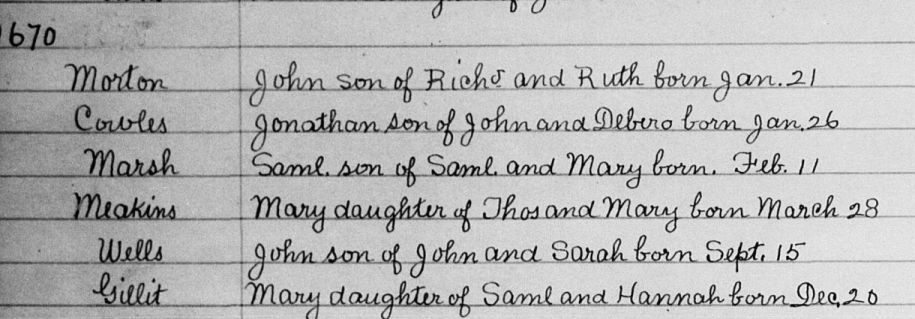
At the time of the last Indian attack on Hatfield during King Philip's War, on 19 October 1677, John was just 7 years old. He avoided the fate of his little sister, Elizabeth, who was killed.
John Wells married Rachel Marsh, the daughter of Samuel Marsh and Mary Allison, in 1699 in Hatfield. She had been born on 15 October 1674 in Hatfield. Samuel Marsh lived 4 houselots to the north of John, in Hatfield.
John Wells was a freeman in 1690 and representative in 1705 and 1706 [or does this refer to Samuel Marsh?].
| Witch Trials in New England
Mary continued to be abused, however. While a local man lay ill, supposedly under her bewitchment, a number of young men tried an experiment upon the old woman. Having dragged her out of the house, they hung her up until she was near dead, let her down, rolled her sometime in the snow, and at last buried her in it and there left her. However, she survived and the man died. |
| Why?
The Purtians were a fundamentalist sect that believed in the strict word of the Bible. Part of their disagreement with the Church of England had been in the rejection of the bishops' role in interpreting the Bible for the laity. Each Puritan felt it his duty to read, interpret and understand the Bible, within the limits of their accepted faith. They had a close, 'personal' relationship with God and, concomitantly, a believe in the close existence of Satan and his minions. This belief in the existence of devils, imps and other satanic creatures was pre-Christian in origin. They believed it was possible to enter into a compact with this devil in exchange for certain powers. Intolerant of other's beliefs, this intense focus on an uncompromising religion left the Puritans open to an hysterical response to evidence of witchcraft, the open opposition to their faith. The witch trials were an attempt to force a kind of "political correctness" on the population. |
John Wells was a Selectman of Hatfield in 1718.
John died on 21 April 1720 in Hatfield at the age of 49 - from Vital and Town Records of the Town Clerk, Hatfield Massachusetts..

Rachel Marsh Wells died on 8 April 1760, aged 94! The children of John and Rachel were Sarah, Abigail and:
His children were,
(20) John Wells (1700)
(20) Joseph Wells (1702)
(20) Samuel Wells (1704)
(20) Aaron Wells (1707)
(20) Sarah Wells (c1710)
(20) Jonathan Wells (1713)
(20) Noah Wells (1719)
He was born on 12 March 1700 and died in 1760 [or 15 February 1745/6} in Hardwick, Worcester county, Massachusetts where he had been a Selectman and Treasurer of the town at various times. He resided for a time in Amherst. He married Martha Allis in 1725. She was born on 9 November 1674. Their children were John (1728), Martha (1731), Mary (1733), Lucy (1735), Lydia (1738), Submit (1742), and Elijah (1744).
From the "Hardwick History - Civil History:"
pp. 35-36 "The following is a list of persons' names and the lots drawn by them, with the number of acres belonging to each lot drawn by the persons admitted settlers in Lamberstown, so called." Then follows a list of names, including:
" WELLS . . . . . 100"
p. 36 "October 30, 1733. ....... Voted, That Lieut. Leonard shall have the Mill lot adjoining to the Ware River, at the southerly corner of the town, 2 provided that he erects a good grist mill on the River in one year from the last day of June next, and that he keeps and maintains the said mill in good repair for the space of twenty years, so as to supply the the inhabitants of the town with grinding from time to time, and for the usual toll ...." " 2 At Gilbertsville. Lieutenant Leonard failed to perform the conditions, and the lot was granted to "William Jennison, Esq., and to Stephen Stearnes, both of Worcester, and Stephen Harrington of Lamberstown in equal parts.......". ..... The mill and lot subsequently became the property of John Wells, after whose death they were sold, 24th October, 1750, to Jonathan Warner."
p. 38 "The meeting, thus authorized, was holden February 9, 1737, and its proceeding are here entered in full, as they show to a certain extent who were then inhabitants. It was voted:" "5. That John Wells be Town Treasurer"
p. 42 "A meeting was accordingly held in March 5, 1738-9, at which town officers were elected, to wit: ....John Wells ... Selectmen .... John Wells, treasurer...."
From the "Hardwick History - Ecclesiastical History:"
p. 176 "November ye 17th 1736. A church was gathered and imbodied in Lambstown, and the members of the church publically invited and chose Mr. David White to be their pastor. " "The names of the men who solemnly entered into a church state in Lambstown, that before were members of other churches: ... John Wells...." p. 179-183 These pages describe a controversy over the location of the Meeting House, that went on for several years. The name of John Wells is mentioned several times.
p. 193 " ....Mr. White had the happiness to behold again a state of harmony and peace in his parish. Thus, though he encountered storms through the journey of life, the evening of his days was calm and serene, and his sun went down in a clear sky. His wife (who was a niece of Thomas Wells, Esq., of Deerfield), had closed her pilgrimage about six months previously, July 17, 1783."
He was born on 4 March 1702. He resided in Sunderland and Amherst.
(20) Samuel Wells (1704)He was born on 19 November 1704 in Hatfield. He married Martha Chapin on 20 October 1726 in Springfield, Hampden county, Massachusetts. She was born on 5 September 1704 in Hatfield. He resided in Hatfield and died on 25 May 1801. His children were Samuel (1728), Gad (1729), Martha (1734), and Bathsheba (1738).
(20) Aaron Wells (1707)He was born on 2 September 1707 and died 9 August 1778.
(20) Jonathan Wells (1713)He was born on 4 Apr 1713. He resided in Shutesbury.
(20) Noah Wells (1719)Anita's 5th Great-Grandfather. Noah, the son of John Wells and Rachel Marsh, was born on 18 January 1719 in Hatfield, Hampshire county, Massachusetts - from Vital and Town Records of the Town Clerk, Hatfield.

He married Abigail Bardwell in 1743 [or 1748]. She had been born on 14 October 1721/2 in Hatfield, the daughter of Ebenezer Bardwell, of Deerfield [Hatfield?], and Mary Field. She was the grand-daughter of Robert Bardwell, an early settler of the Connecticut river valley. He came from London, residing there during both the Great Plague and the Great Fire. He was a soldier in the Great Swamp Fight [now referred to as a massacre] on 19 December 1675 when the power of the Narraganset Indians was broken during King Philip's War and he was a Sergeant in the militia under Turner and fought at the Falls Fight. Two of her brothers fought in the French & Indian War.
On 11 February 1750 Noah Wells of Hatfield sold "Three Quarters of an acre of land lying in the South or Home Meadow so called in the Township of Hatfield" in consideration of "Eight Pounds Ten Shillings Lawful Monay paid Me by Elijah Morton of Hatfield aforesaid, Blacksmith." This was land bordered on the "South on Land belonging to the Widow Rachel Wells of Hatfield." This was his mother who went on to live for another 10 years.
"In 1758, Noah Wells built a house west of the Abel Scott place" in what was to become Whately - from "History of the Town of Whately, Mass." This was not necessarily a big move, Whately was created out of a portion of Hatfield in 1771.
"Wells, Noah, came to Whately in 1758 and built a house on the west side of Chestnut Plain street, about fifteen rods south of the house of the late Wells Dickinson. It was torn down a great many years ago. He was succeeded by his son, Lemuel, and for a time by Israel Wells." - from the "History of the Town of Whately" by James M. Crafts.Israel was the second son of Lemuel.
"Some of the first houses in the Straits, and on Chestnut plain, were built of logs: some were partly of logs, with an upright frame attached; and all were without inside finish. Noah Wells's was a log house; and when his son Perez built in "Claverack," he moved down part of the old logs, and added a small frame." - from "Town of Whately, Mass., 1660-1871" by J.H. Temple
| The Town of Whately
Located in Franklin county, Massachusetts, this village was formed from part of Hatfield in 1771. The Hampshire county of the 17th and 18th centuries included the present-day Hampden and Franklin counties. Established in 1811, Franklin county is just north of the Hampshire county region of Hadley and Hatfield. Whately is just north of the border with Hampshire. The village of Deerfield is north of it, Hadley and Hatfield to the south, Sunderland is to the east. |
On 20 September 1761 the heirs of John Wells sold 185 acres of land.
"Samuel Wells, Noah Wells, Sarah Wells, Elijah Wait, & Martha Wait of Hatfield, Aaron Wells of Hadley, John Wells, Nathan Billing, and Lydia Billing of Hardwick" in consideration for the sum of "Seventy eight Pounds" to me paid by "Joseph Billing and David Billing, both of Hatfield aforesaid," for "certain Land or parcell of land lying and being in the Third division of Country in Hatfield being the lot originally granted and recorded vis John Wells the first of Hatfield decd and is bounded East on a high way South on the Dickinsons land West on the three mile and [Isthional] Grant so called and North on the Mortons land containing by Estimation one hundred and eight five acres [plus?] one quarter of an acre." - Deed of saleElisha Wait was the great-grandson of Thomas Wells and Mary Beardsley. He married Martha Wells, the great-granddaughter of John Wells and Sarah Curtis.
In 1768 Asa Dickinson bought the Lemuel and Noah Wells property . . . He lived there, after pulling down the Wells house, many years ago. Since Asa died his son, Wells Dickinson, has owned the place." - from the "History of the Town of Whately" by James M. Crafts. This sounds like the house Noah built in 1758. Lemuel was Noah's eldest son.
A list was made of the inhabitants of the town as of May 1771. It did not include Noah, perhaps, as the History states, because "Noah Wells had probably removed, temporarily, to the Equivalent Lands, afterwards Hawley."
| The Town of Hawley
Hawley was first settled in 1760 as Plantation Number 7, by a group from Hatfield. The town was called the "Hatfield Reserve" until it was officially incorporated in 1792. The town was named for Joseph Hawley of Northampton, a local leader in the American Revolution. Hawley's main industries were forestry and, eventually, recreation. The town originally included the land of its neighbor, Plainfield, which split off in the early nineteenth century. Today the town is divided by the Kenneth Dubuque State Forest into East Hawley and West Hawley sections. The original "village" is within the State Forest, burned in a tannery fire in the mid 1800s. |
Noah obviously returned from Hawley because he was a Selectman of Whately from 1772 to 1775, 1778, 1782, 1783, and in 1788. Noah was an Assessor of the town in 1773, 1774, 1778, 1779, 1782, 1783 and 1788 - from the "History of the Town of Whately" by Josiah Howard Temple.
On 4 May 1775, in the uncertainty attending the aftermath of Lexington and Concord, the city fathers of Whately drafted a proclamation,
"Whereas the Law of the Province, or the execution of it is ceased, and the constables have not had that power to collect the rates as heretofore: These are to let you know, as constables, that this town's Committee, chosen for that purpose, will and do protect you in the collection of those rates that are now behind, in six weeks from this date, or the town treasurer shall have full power to distrain on said constables.That is, no one was to think that just because Americans weren't going to be taxed by the British that they didn't need to pay their taxes to the town.
Signed, --
. . .
Noah Wells,
. . .
Whately, May y 4th, 1775."
Noah subsequently attended the Third Provincial Congress, a revolutionary organization, held on the last day of May 1775, in Watertown, as a delegate for Whately. This Conress dissolved on 19 July 1775 on the same day that the new state government was inaugurated.
| The Massachusetts Provincial Congress (1774-1780)
This was a provisional government created in the Province of Massachusetts Bay early in the American Revolution. Based roughly on the terms of the colonial charter, it exercised de facto control over the rebellious portions of the province, and after the British withdrawal from Boston in March 1776, the entire province. - from Wikipedia |
A convention of the county was called on 20 October 1782 at Hatfield to discuss the matter of a county seat, commutation of officers' pay, and the subject of National and State debts. The village of Whately sent three delegates, one of whom was Noah Wells - from "History of the Town of Whately, Mass."
On 7 April 1783 the town voted to send Noah as a delegate to a convention to be held at Hadley on the third Wednesday of that month.
In the 1790 census for Whately, Massachusetts as Noah Wells. There is one male and 2 females living in Noah's house. He lived on the west side of Chestnut Plain road.
Note that Shays Rebellion took place at about this time and some men of the town were on record as being sympathizers, though Noah was not included in this number. These men were warned out of town in 1791.
Noah died in 1800 in Hawley, Franklin county, Massachusetts. Hawley is northwest of Whately. We know the names of many of his children, including Lemuel, Elisha, Daniel, Abigail, Simeon, Perez, Violet, and John - from "History of the Town of Whately, Mass."
Noah's children were,
(21) Lemuel Welles (1745)
(21) Elisha Welles (1747)
(21) Daniel Welles (1749)
(21) Abigail Welles (1754)
(21) Simeon Welles (1754)
(21) Perez Welles (1757)
(21) Violet Wells (1759), she married Joel Morton
(21) John Welles (1761)
He was born in Hatfield on 30 July 1745. He married Lydia Scott, the daughter of David Scott. In the 1790 census for Whately, Massachusetts, there was one male over 16, 4 under, and 2 females living in Lemuel's house.
Their children were Solomon (b: 1769, d: 9 June 1817 in Norwich, Chenango county, New York. A carpenter/joiner. Listed in the 1810 census of Chenango county), Israel (b. 16 June 1774), Lydia (1775, m. Israel Graves), Lemuel (b: 5 March 1777 in Whately, d: 6 February 1863 in Norwich, Chenango county, New York. An early settler of Chenango, arriving in 1805), Quartus (baptized 22 August 1779), Noah (baptized 6 Janaury 1782, m. Jenny Ferguson, died at Sangersfield, New York), Gad (1783) and Esther (1785, married Israel Crafts).
He died in Hawley.
(21) Elisha Welles (1747)He was born in Hatfield on 30 July 1747. He married first, Rhoda Graves, then Amy. His children were Amy, Sarah, Jonathan, Thaddeus, Abigail, Sabra, Elisha, Emily, Clarissa and Ruth. He lived on the west side of Mount Esther, but later removed to Hawley.
(21) Daniel Welles (1749)He was born in Hatfield on 19 May 1749. He married Aphia Dickinson on 19 May 1774. She was born in 1756 in Whately, Massachusetts, the daughter of Abner Dickinson. She was a descendent of Nathaniel Dickinson.
(21) Abigail Welles (1754)She was born on 10 June 1754 in Hatfield. She married Paul Warner.
(21) Simeon Welles (1754)Anita's 4th Great-Grandfather. Simeon Wells, the son of Noah Wells and Abigail Bardwell, was born on 10 June 1754/5 in Hatfield, Hampshire county, Massachusetts. Some sources show his birthplace as Whately, Franklin county, Massachusetts, where his father, Noah, was living in 1758. As referred to earlier, both could be correct since Whately was formed from part of Hatfield in 1771.
"Simeon Wells born June 10, 1754, died August 10, 1806 at Brookfield [Vermont]. Sarah Wells his wife was born Feb. 11, 176? . . . Simeon Wells and Sarah Snow of Whately, Mass, m. Nov. 29, 1787 by Rev. Rufus Wells, pastor Congregational Church." - from "Wells Family Research Bulletin" page 476, by Elain Ramstein WellsYes, Rufus was a close relative. Sarah Snow was the daughter of Lemuel and Margaret Snow of Whately.
| Simeon
The name Simeon is from the Bible. He was he second son of Jacob/Israel, after Reuben and before Levi. His mother was Leah. Simeon was fierce toward his enemies. He and his brother Levi slew Hamor and the Shechemites after the violation of Simeon's sister Dinah. His loyalty to his family was at times opportunistic. He joined with his brothers in sellling their brother Joseph, of the 'Coat of Many Colors,' to the Ishmaelites who took him to Eqypt. The offspring of Simeon were allotted the territory in the south of Israel, including Beersheba. This turns out to have been a quite common name of the period. |
Simeon served in the Revolutionary War as a Private in service to Massachusetts in the Northern Army. The first muster roll I've found that contains Simeon Wells was from the period of the Lexington Alarm of 19 April 1775.
See also, as,"The Lexington Alarm.--The battle of Lexington was fought April 19th, and the news reached the valley late in the day of the 20th. The alarm was immediately sounded, and the Whately company of minute men was ready to start early the next morning. They marched that day and the next forenoon forty miles, and receiving intelligence that the British had retreated and that their services would not be required, they returned home the 23d.
The rolls of this company, found in the state archives, is as follows:
Capt. Henry Stiles
Lieut. Noah Bardwell
. . .
Simeon Wells" - from the "History of Whately"
"Wells, Simon [sic], Whately. Private, Capt. Henry Stile's co. of militia, which marched April 21, 1775, in response to the alarm of April 19, 1775; service to April 23, 1775." - from "Massachusetts Soldiers and Sailors of the Revolutionary War"The next we hear of Simeon during the war is the following.
"23 April [1777], an order was issued for raising two battalions of seven hundred and fifty men each, from Hampshire County, for two months' service at Ticonderoga. A company of fifty-seven men, under Capt. Salmon White, Col. David Wells's [regiment] was out from May 10, to July 10. The Whately men in this company appear to have beenThey served for 2 months and 10 days, including 8 days (160 miles) travel home. The roll was sworn to in Hampshire county. Salmon White was of Whately. I suspect that Simeon's outfit was discharged because Fort Ticonderoga surrendered on 6 July 1777. However, Simeon stayed on until the end of November.
. . .
Joel Morton [Simeon's brother-in-law]
. . .
Perez Wells [Simeon's younger brother]
. . .
Simeon Wells" - from "History of Whately, Mass." by J. H. Temple
"Some of the Whately men that went out at this time coninuted in service through the campaign, till after the surrender of Burgoyne, Oct. 17. . . Moses Crafts, Phineas Scott, and Simeon Wells, were with the northern army in Capt. John Kirkland's company, Aug. 16, to Nov. 29." - from "History of the Town of Whately" by Josiah Howard Temple
| Siege of Fort Ticonderoga
The 1777 Siege of Fort Ticonderoga occurred between 2 and 6 July 1777 at Fort Ticonderoga, near the southern end of Lake Champlain in the state of New York. Lieutenant General John Burgoyne's 8,000-man army occupied high ground above the fort, and nearly surrounded the defences. These movements precipitated the occupying Continental Army, an under-strength force of 3,000 under the command of General Arthur St. Clair, to withdraw from Ticonderoga and the surrounding defences. Some gunfire was exchanged, and there were some casualties, but there was no formal siege and no pitched battle. Burgoyne's army occupied Fort Ticonderoga and Mount Independence, the extensive fortifications on the Vermont side of the lake, without opposition on 6 July. Advance units pursued the retreating Americans. |
The following sounds like a similar mission, but the dates are later in the year.
"Wells, Simeon. Private, Capt. John Kirkland's co., Col. [Benjamin] Ruggles Woodbridge's regt.; enlisted Aug. 16, 1777; service, 3 mos. 23 days; regiment raised to reinforce Continental Army at the Northward." - from "Massachusetts Soldiers and Sailors in the War of the Revolution"Colonel Woodbridge's regiment, also known as the 1st Hampshire Regiment of Massachusetts Militia, was called up at South Hadley, Massachusetts on 16 August 1777 as reinforcements for the Continental Army during the Saratoga Campaign. The regiment marched quickly to join the gathering forces of General Horatio Gates as he faced British General John Burgoyne in northern New York. The regiment served in General Warner's brigade under Major Genral Benjamin Lincoln. They were part of an American force gathered at Pawlet, Vermont for a three-pronged attack of 500 men each against Fort Ticonderoga. Colonel John Brown led a force against the outposts of Ticonderoga, Colonel Samuel Johnson led a diversionary force against Mount Independence across Lake Champlain from Ticonderoga, and Colonel Woodbridge led a covering force to Skenesborough (now known as Whitehall) at the south end of Lake Champlain. Colonel Brown's attack successfully crippled the British position at Ticonderoga, preventing supplies or reinforcements from reaching General John Burgoyne, who subsequently surrendered at Saratoga on 17 October. The regiment was disbanded on November 29, 1777.
"Father [Simeon Wells] served from Franklin Co., Mass under Capt. Kirkland." - from "Wells Family Research Bulletin" page 476, by Elain Ramstein
Finally, in 1779,
"1779. During this year no less than six levies of men were ordered by the General Court. The term of enlistment in most cases was nine months. The fine for refusing to go when drafted was from L45 to L50. The pay of a soldier was L16 per months, in addition to the regular Continental pay, with allowance for $6 for blanket and 6d per mile traveled. . . This town voted "To allow three men, that will engage nine months for Continental army, 40s per month - equal to wheat at 4s a bushel - with addition of the bounty and mileage allowed by the Court." The men who enlisted were Samuel G. Morton, Gardner Marcy, aged 17, and Simeon Wells." - from the "History of the Town of Whately, Mass" by James Monroe Crafts
"Wells, Simeon. Descriptive list of men raised in Hampshire Co. to serve in the Continental Army for the term of 9 months, agreeable to resolve of June 9, 1779, as returned by Noah Goodman, Superintendent; Capt. White's co., Col. Chapin's regt.; age, 24 yrs.; stature, 5 ft. 9 in.; complexion, light; hair, light; engaged for town of Whately;
- also, list of men returned as received of Noah Goodman, Superintendent for Hampshire Co., by Justin Ely, Commissioner, dated Springfield;
- also, list of men returned as received of Justin Ely, Commissioner, by Capt. James Cooper, at Springfield, July 19, 1779;
- also, Capt. Farley's co., Col. Wesson's (9th) regt.;
- entered service 9 July 1779; discharged 9 April 1780; term, 9 months." - from "Massachusetts Soldiers and Sailors in the Revolutionary War"
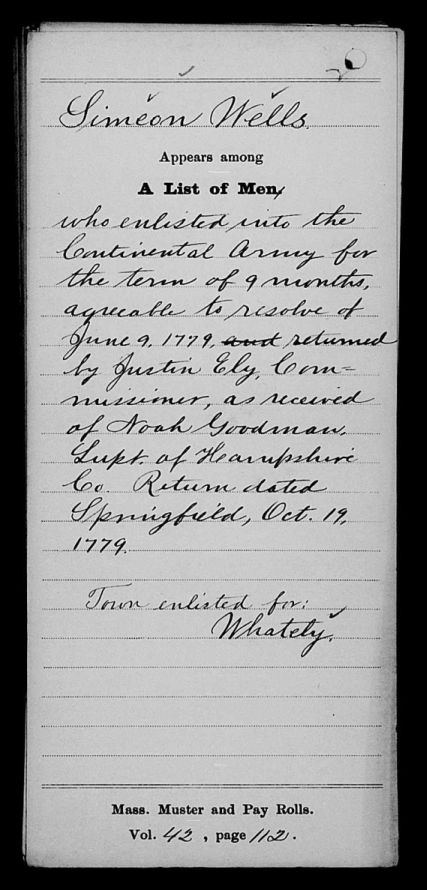
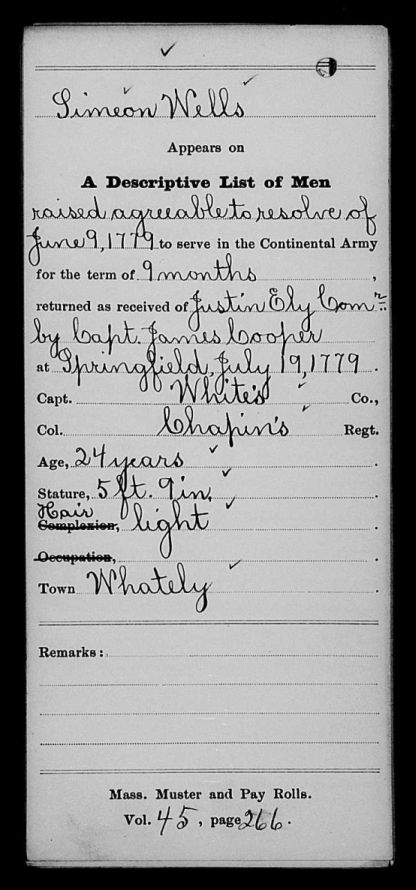
"That he again enlisted, at said New Salem, in fore part of October 1779, in a company commanded by Capt. _____ Merryman, Thomas Grover, Lieut. & Josiah Osgood, Ensign, in Col. Israel Chapin's Regiment for three months. The Reg. assembled at Sunderland, marched from thence to Pittsfield, and from thence to Claverack, State of New York, from thence to Kinderhook, and from thence to Albany, where he remained during the term, and was there discharged." - from "Massachusetts Soldiers and Sailors of the Revolutionary War""Sunderland is just north of Hadley. Pittsfield is about 25 miles due west. Claverack is about 20 miles southwest of there, near the Hudson river. Kinderhook is perhaps 10 miles north of Claverack. And, finally, Albany is some 15 miles north of there. So they marched west to the Hudson river, then turned right and marched up the river to Albany where they sat until they were discharged early. As for Wesson's regiment,
"Some time in the year 1779, Col. Wesson was transferred from the Eighth to the Ninth Massachusetts Regiment, and was stationed that year and the next at West Point and Orange town." - from "Brookline in the Revolution" by Margaret Elizabeth May, 1895James Wesson was in command of the 8th regiment in July 1779 and of the 9th in August 1779 - from "The Centennial of the United States Military Academy at West Point" by Edward Holden. Both West Point and Orangetown are on the Hudson river, above New York City, where the British army lay. General Anthony Wayne's army had taken King's Ferry and the fort at Stony Point, just above Orangetown, on 16 July 1779. Wesson's regiment was probably in a covering position for the fort and ferry.
| Washington's Campaign of 1779
George Washington's campaign in 1779 resolved into a contest for control of the forts along the Hudson river. Washington arrayed the brigades of the Continental army in defensive positions on both sides of the Hudson River with their center on West Point, the last remaining American bastion on the Hudson, where Washington made his headquarters. He expected that British commander, General Henry Clinton, would renew his offensive up the Hudson with the aid of the reinforcements expected to arrive by the end of August. When the forces that arrived were smaller than anticipated, Washington turned to the offense and began gathering his forces for a projected attack on New York City itself. These came to nothing, but the battle to retake King's Ferry, on the Hudson just south of Peekskill, had successfully concluded on 21 October and the British determined to evacuate Rhode Island. So, Washington's campaign did not accomplish its goal, but it did convince the British to pull their forces back, leaving the important port of Newport open for use by the French fleet. |
After the war, Simeon married Sarah Snow on 29 November 1787 in Whateley.
"Simeon Wells and Sarah Snow of Whately, Mass, m. Nov. 29, 1787 by Rev. Rufus Wells, pastor Congregational Church." - from "Wells Family Research Bulletin" page 476, by Elain Ramstein WellsSarah was born on 31 March 1762 in Whately, Franklin county, Massachusetts. Or "Sarah was [born on 11 Feb 1768] the daughter of Lemuel and Margaret Snow - from the "History of the Town of Whately, Mass" by Josiah Howard Temple.
In the 1790 Federal census 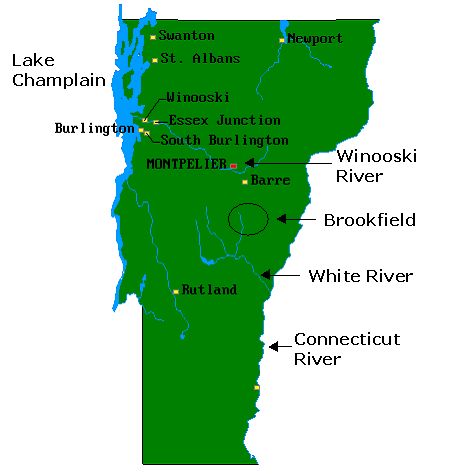 of Whately, Hampshire county, Massachusetts as Simeon Wells, head of the household. In the house is one male over the age of 16, two under, and 1 female. This matches what we would expect in 1790, the two boys being Charles and William, below.
of Whately, Hampshire county, Massachusetts as Simeon Wells, head of the household. In the house is one male over the age of 16, two under, and 1 female. This matches what we would expect in 1790, the two boys being Charles and William, below.
Sometime before 1796, when his son Dexter was born, Simeon moved into the Green Mountains of Vermont.
"Simeon Wells came to Brookfield in 1794, from Whately, Mass., lived near Mr. Baker's present residence for twelve years and died in 1806, aged 51." - from the "History of Brookfield, Vermont"
The 1800 Federal census shows Simeon residing in Brookfield township, Orange county, Vermont. His household included 3 boys [Charles, William and Dexter], a father, 2 daughters and their mother (1-2-0-0-1--2-0-0-1). There are no other Wells living in the community. Simeon probably moved north up the Connecticut river, poling a raft perhaps, then up the White river, a tributory, to Brookfield township. The Green Mountains form the spine of Vermont, with the Connecticut river on the eastern side and Lake Champlain on the western. Brookfield is on the eastern slope of the mountains. Going over the mountains to western Vermont would have been arduous in the 18th century.
 Brookfield Township, Orange county, Vermont Brookfield Township, Orange county, Vermont
This township in the west side of Orange county, Vermont was established in 1791. Its located just south of Montpelier, the capital, in the geographic center of the state. The county borders the Connecticut river, to the east. The name Vermont is derived from Green Mountains, or Vert Mont. |
Simeon died on 10 August 1806 in Brookfield, or was it in 1826? My guess, based on the 1810 census, was that he died in 1806. He was buried in the Brookfield cemetery.
"Simeon Wells W19599 Massachusetts Sarah
Simeon Wells died 10 August 1826 [sic] town of Brookfield, Vt. age 52 [would make it 1806].
payable to William Wells. Dexter Wells, Content Bacon--" and Constant Wells only surviving chn." - from "Wells Family Research Bulletin" page 476, by Elain Ramstein Wells
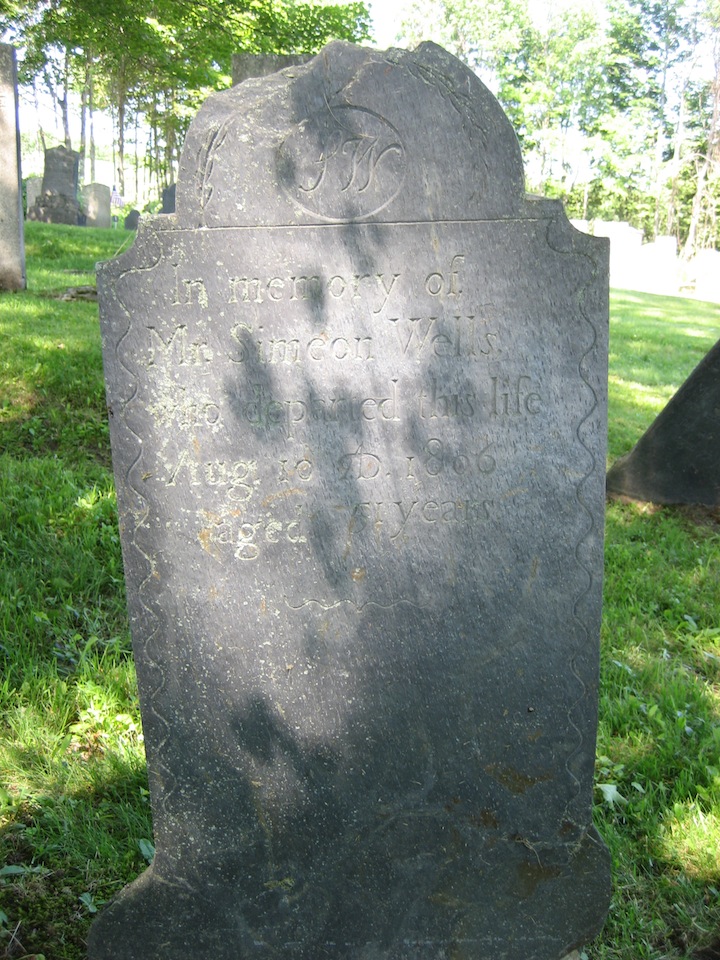
The 1810 Federal census does not show a Simeon Wells in Brookfield township, but does have a Joel and Sarah Wells in separate households. I don't know who Joel Wells was. In Sarah's household were 1 boy under 10 (Constant), 1 10-16 (Dexter), 1 16-26 (Charles or William), 1 girl under 10 (Electa), 1 10-16 (Content), 1 16-26 (Sarah Jr.), 1 woman over 45 (Sarah). Charles, the eldest son, may have been a farm laborer by this time, living in the house of his employer.
Sarah Snow Wells lived to be 82 and died in East Pitcairn, St. Lawrence county on 24 December 1845 - from "Wells Family Research Bulletin" by Elain Ramstein Wells. She appears to have been living with her son, Dexter, and had never remarried.
Stray bits: "NY - Dexter Wells a resident of town of Pitcairn - age 51 - to obtain pension due his mother Sarah Wells at the time of her death. Sarah Wells died 24 Dec. 1845. Father served from Franklin Co., Mass under Capt. Kirkland. Simeon Wells born June 10, 1754, died August 10, 1806 at Brookfield. Sarah Wells his wife was born Feb. 11, 176?. Charles Wells b. March 31, 1788, d. June 9, 1827; William Wells b. Jan. 14, 1797; Sarah [garbled] b. 1795; Content b. Feb. 14, 179-; twin sons born and died same day 1800; Constant b. Jan. 14, 1801" - from "Wells Family Research Bulletin" page 476, by Elain Ramstein Wells
Stray bits: Children of Simeon and Sarah Wells: Charles Welles1,2 b. 31 Mar 1788, d. 9 Jun 1827 William Welles3,2 b. 14 Jan 1790, d. 16 Jun 1867 Sarah Welles3,2 b. 5 Sep 1792, d. 29 Dec 1840 Hulda Wells3,2 b. 8 Mar 1795, d. 20 Mar 1795 Dexter Wells+3,2 b. 3 Mar 1796 Content Wells3,2 b. 14 Feb 1798 Constant Wells+6,2 b. c 1801, d. c 1885 Constance Wells3,2 b. 14 Jan 1801 Electa Wells3,2 b. 13 Jul 1803
Simeon and Sarah's children were,
(22) Charles Wells (1788)
(22) William Wells (1790)
(22) Sarah Wells (1792)
(22) Hulda Wells (1795), died young
(22) Dexter Wells (1796)
(22) Content Wells (1798)
(22) Constant Wells (1801)
(22) Constance Wells (1801) [?]
(22) Electa Wells (1803)
He was born on 31 March 1788 in Whately and died on 9 June 1827, probably in Vermont. Noted in the "History of Whately."
(22) William Wells (1790)He was born on 15 June 1790 in Whately, Massachusetts, though he may have been baptized as late as 2 October 1791. Noted in the "History of Whately." He died on 16 June 1867 in Montpelier, Vermont. Living in Brookfield, Orange county, Vermont in the 1820, 1830 and 1840 census. In the 1850 census of Brookfield as a 59 year old lawyer [!]. Living with him were his wife, Achsah, 56, and William N., 23. William was also in the 1860 Brookfield census, aged 70. Living with him were his wife, Achsah, 67, an Alfred Smalley, 17, and Henry M., a 27 year old printer.
| Achsah
A biblical name, from the book of Joshua 15:17-19. She was the daughter of Caleb, a great hero of the bible. Caleb offered the hand of his daughter in marriage as a prize to the warrior who attacked the city of Debir, or Kirjath-sepher, and took it. Caleb's nephew, Othniel, did so and won the hand of Achsah. |
William probably died soon after the 1860 census, but by the time of the 1870 census almost all of the Wells families, including Richard's family below, had moved out of Brookfield. There was a Flora Wells [?] still living there in 1870, but there were no Wells surnames in 1880.
(23) Thomas S. Wells (1820)Perhaps the son of William. He was born in Vermont. In the 1850 census of Brookfield he was a 29 year old farmer. Living with him were his wife, Lucy, 27, of Vermont. He resided just two households away from his "father," William.
(23) William N. Wells (1827)He was born in Vermont. In the 1850 census of Brookfield, aged 23, living with his father, William Sr. In the 1860 Brookfield census he was living next door to his father, aged 35, but with no occupation listed. Living with him were his wife, Martha, 27, of New Hampshire, and Lillian M., 1.
(23) Henry M. Wells (1832)In the 1860 Brookfield census, a 27 year old printer, living with his father. I can't find him in the 1870 census, but in the 1880 census he has removed to District 566, New York, New York, a 47 year old printer. Living with his was his wife, Lizzie M., 33, and Mary A., 18 years old, born in Vermont, who is "at college." In the 1910 census there is a Henry Wells, 75 [1834], born in Vermont, who was then living in the 4th township, Madera county, California.
(22) Sarah Wells (1792)She was born on 5 September 1792 in Whately and baptized on 30 November 1792. Noted in the "History of Whately." She died on 29 December 1840.
(22) Dexter Wells (1796)He was born on 3 March 1796 in Vermont. Not noted in the "History of Whately," perhaps, logically, because he wasn't born there. He married Dolly Ingalls. In the 1820 and 1830 census he was living in Brookfield township, Orange county, Vermont, already with several children. There are a total of seven members in the family. Also living in Brookfield were Joel, Richard and William Wells, probably his brothers. Clearly he joined his younger brother, Constant, in Pitcairn, New York well after Constant had made the move there in 1823. There were six members in his family in 1830.
In the 1840 Federal census Dexter was in Pitcairn township, St. Lawrence county, New York. He was listed just above his brother, Constant. He has one son aged 15-20 years old [Simeon?], and himself, aged 40-50. Of the women of the house, there was his wife, aged 30-40, and two older women, one aged 60-70 and another 70-80. This may be his mother [Sarah Snow Wells would have been 78 years old] and mother-in-law. When Sarah Snow Wells died she was living in the house of Constant Wells.
In the 1850 census of Pitcairn, New York as Dexter Wells, a 52 year old farmer born in Vermont. Living with him were Betsey, 45 and also born in Vermont, Amanda, 7, born in New York, Simeon, a 26 year old farmer born in Vermont, Betsey E., 25, Simeon's wife, born in Vermont, and Harvey, I, 4, Simeon's son, born in New York.
In the 1860 census of Pitcairn, New York he was a 64 year old farmer. Living with him were his wife, Dolly [are Dolly and Betsey the same woman?], 55, and Amanda, 17.
In the 1870 Federal census, Pitcairn, St. Lawrence county, New York Dexter was listed as a 73 year old farmer, born in Vermont. His wife was Lolla, 65 years old, born in Vermont. She was keeping house. Dexter died on 14 June 1874. His widow died in East Pitcairn on 25 November 1874. She was called Dolly and aged 70 years at her death.
(23) Simeon Wells (1824)He was born in Vermont. He was living with his father at the time of the 1850 census of Pitcairn, New York, a 26 year old farmer. His wife, Betsey, 24, and Harvey, 4, also lived with Dexter. In the 1860 census of Pitcairn he was a 36 year old farmer. Living with him were his wife, Mary [a second wife I presume], 24, Harvey, 14, Jasper, 9, Eliza, 4, and Francis, 7/12. His first wife apparently died before 1860. The last three children may belong to either Betsey or Mary
Simeon Wells, of East Pitcairn, New York was, in 1861, a Captain in Company I of the 33rd Regiment of the New York State Militia, under the command of Colonel Charles R. Brundage. This was a precursor of the 60th Regiment in which Simeon's nephews, Constant and Joel Wells, served. Simeon was appointed to recruit for the Regiment. Simeon was not part of the organization when it left for the war. Company I was then under the command of Jesse H. Jones, with Colonel William B. Hayward commanding the Regiment, Colonel Brundage having been reduced to the rank of Major. The men apparently elected their officers. - from "History of the Sixtieth Regiment New York State Volunteers" by Richard Eddy.
All of this is very confusing considering that Simeon next joined he 11th Cavalry as an enlisted man.
From "Town clerks' registers of men who served in the Civil War, ca. 1865-1867": 6 Wells, Simeon, [born] 1824, [place of birth] x, [father] Dexter, [mother] Dolly Ingalls.
Simeon Wells was Quartermaster-Sergeant of Company D, 11th New York Cavalry. He had enrolled on 18 December 1861 at Pitcairn. A pension record indicates that a Simeon Wells of New York was in Company D, 11th New York Cavalry. Dexter Wells, Simeon's cousin and son of Constant Wells, was also in the 11th.
Promoted to Full Sergeant (Reduced rank [?])
Enlisted as a Quartermaster Sergeant on 18 December 1861 at the age of 37
Enlisted in Company D, 11th Cavalry Regiment New York on 15 January 1862.
Received a disability discharge Company D, 11th Cavalry Regiment New York on 13 September 1862 at Camp Relief, Washington, DC
The pension record also indicates that Simeon saw service in Company H of the 20th [?] New York Infantry. This would have been 'Turner's Rifles,' but this doesn't seem right. The 20th saw service only from 1861-1863. Antietam seems to have been the death of them. Alternatively, another site run by the Park Service, Civil War Soldiers and Sailors System, indicates this was Company H of the 20th Cavalry, the same outfit that Constant Jr. was in. This does make sense. This outfit didn't stand-up until 1863. Simeon, like Constant Jr., had been sent home to recuperate. When recruiters came around for this new cavalry unit, the cousins signed up together.
Confusingly, there's another Simeon, of New York, who I haven't figured out yet. Its possible he's a son of our Simeon:
Enlisted as a Private on 31 August 1864 at the age of 20 [born 1844]
Enlisted in Company H, 20th Cavalry Regiment New York on 31 August 1864.
Mustered out Company H, 20th Cavalry Regiment New York on 30 May 1865 in Fort Monroe, Va
In the 1870 census of Pitcairn, New York as a 45 year old farmer. He had real estate worth $4000 and other property worth $1800. He was born in Vermont. Living with him are his wife, Mary, 34, Jasper, 18, Eliza, 14, Frances, 10, Cornelius, 3, and Olive, 1, all born in New York.
From the Pitcairn Business Directory - Individuals, 1873-74:
Last Name, First Name, Post Office, Occupation, Farm Acres, Comments
Wells, Simeon, East Pitcairn, Justice of the peace, postmaster & farmer, 220 - This is probably Dexter Sr.'s son.
In the 1880 census of Pitcairn as a 56 year old farmer. Living with him were his wife, Mary E., 49, Francis T., a 19 year old school teacher, C.J. [Cornelius], 12, and Olive, 11.
There was a Simeon Wells was still living in East Pitcairn in 1890 and Mary E. Wells, 74, was still living at the time of the 1910 Pitcairn census.
(24) Harvey I. [Jesse?] Wells (1846)The son of Betsy, Simeon's first wife. His middle initial may be J. Four years old at the time of the 1850 census of Pitcairn, New York. Also in the 1860 census. Not present in the 1870 or 1880 census. A researcher writes,
"Hi Steve,His death certificate lists him as Harvey Jesse Wells, born 8 May 1846 in East Pitcairn, the son of Simeon Wells, of Vermont, and Eliza Benister, of New York; died 8 July 1924 in Kansas City, Missouri. (24) Jasper S. Wells (1852)
I ran across your site while I was researching for a publication I am writing on a dollhouse in our collection and I wanted to let you know it was very helpful to me. The dollhouse was made by Harvey Jesse Wells and I believe he is the Harvey Wells (Gen. 24, b. 1846) listed on your site and therefore the son of Simeon Wells (Gen. 23, b. 1824).
Harvey Jesse went to Kansas to establish the first N.Y. Central Freight office west of the Mississippi. His granddaughter (who was born in 1916) knows very little about his past except that he was from New York and one of his grandmothers was a full-blooded Iroquois Indian. Most of what I know about his family I learned when I obtained his death certificate through the State of Missouri which I will attach for your records. He married Ellen Dickinson, a second cousin to the famous poet Emily Dickinson, and lived in Kansas City, Missouri for the rest of his life. His only child was born on November 25, 1877 and was named Antoinette May Wells (Nettie for short). He built the aforementioned dollhouse for her sometime in the 1880s.
Thank you for all your research and for taking the time to publish it!"
In the 1860 census of Pitcairn, New York, 9 years old. In the 1870 census of Pitcairn, New York as an 18 year old, "works on the farm." He was born in New York, living with his father. In the 1880 census for Potsdam, St Lawrence county, New York as J.S. Wells, as single man 27 years old. He was a "cheesemaker" boarding in the house of Hiram Pickett. In the 1910 census, aged 60, living in Parishville, St. Lawrence county, New York. He appears to have died before the 1920 census. I've found no evidence of children.
(24) Eliza Wells (1856)In the 1860 census of Pitcairn, New York, 4 years old. In the 1870 census of Pitcairn, New York as a 14 year old. Born in New York, living with her father.
(24) Frances D. Wells (1860)In the 1860 census of Pitcairn, New York, 7/12 years old. In the 1870 census of Pitcairn, New York as a 10 year old. Born in New York and living with her father. She became a school teacher.
(24) Cornelius J. Wells (1867)In the 1870 census of Pitcairn, New York as a 3 year old, born in New York, and living with his father. Referred to as C.J. in the 1880 census. In the 1910 Pitcairn census, he was 42 years old. In the 1920 census of Pierrepont, Saint Lawrence county, New York, he was 53. Living with him were his wife, Louise, 52, Lizzie, 21, who was a teacher in the [garbled] district school, William, 18, a farm laborer, Glenn, 16, Carl, 14, and Jay, 8, all born in Pitcairn, New York. Interestingly, on the census form for place of birth, Pitcairn was written in, then crossed out, followed by New York. Did the census taker's supervisor crosss this out as "too much information?"
(25) Elizabeth Wells (1899)A school teacher in the district school.
(25) William Wells (1902)He was born in Pitcairn, New York, the son of Cornelius in the 1920 census. The common-ness of his name makes research extremely difficult.
(25) Glenn Wells (1904)He was born in Pitcairn, New York, perhaps on 19 May 1904 according to the Social Security death records. The son of Cornelius in the 1920 census. Was his name Glen or Glenn? There is a Glen H. Wells, born in New York around 1904, living in Ticonderoga, Essex county, New York at the time of the 1930 census. He was a single man, a 25 year old laborer working on a state road, boarding in the house of Ezekiel Delorm. Road work might imply that Glen was a transient in Ticonderoga, living there only so as that part of the road was under construction. He may have died in May 1968.
(25) Carl Wells (1906)He was born, perhaps on 12 July 1905, in Pitcairn, New York, the son of Cornelius in the 1920 census. He may have died in October 1968.
(25) Jay Wells (1912)He was born in Pitcairn, New York, the son of Cornelius in the 1920 census. Could his full name be Jasper, for his uncle?
(24) Olive Wells (1869)In the 1870 census of Pitcairn, New York as a 1 year old. Born in New York, living with her father.
(23) Dexter Wells Jr. (1834)He was born in New York, probably a son of Dexter Sr. He was the 'third' Dexter. Not the Dexter who was born in 1796, nor the son of Simeon, Dexter Sr.'s younger brother, who was living with his father in 1860. This Dexter was not in the 1850 census, but was in the 1860 census for Pitcairn, New York, a 25 year old laborer, living in what appears to be a boarding house. He may have fought in the Civil War, see his cousin, Dexter, below. I don't see him in the census of later years.
(23) Amanda Wells (1843)She was born in New York. In the 1850 and 1870 census of Pitcairn, New York.
(22) Richard Wells (1798)Was he a son of Simeon? He was born in Massachusetts. He may be a son of Simeon. In the 1820, 1830 and 1840 census of Brookfield, Orange county, Vermont. His brothers, Dexter, Joel and William also lived in Brookfield for an extended period. In the 1850 Brookfield census Richard was a 52 year old farmer. Living with him are Elizabeth, his wife, 53.
(23) George W. Wells (1821)He was born in Vermont. Residing next door to Richard in the 1850 Brookfield census as a 29 year old farmer. Living with him were his wife, Susan T., 22, and Elizabeth B., 3. In the 1860 Brookfield census, aged 40. Living with him were his wife, Susan T., 33, Lizzie B., 13, Gloria E., 9, and Elizabeth, 73. I assume this last was his mother, though she appears to have aged 20 years in a single decade. This implies that Richard had died by 1860, when he would have been 63 [or 73 if he aged the same way Elizabeth did].
(24) Elizabeth B. Wells (1847)She was born on 14 February 1798 in Brookfield, Orange county, Vermont. She married Sylvester Bacon. She was his second wife. He was born 9 July 1787 and first married Lucy Goodenow. Content died on 24 June 1858. They did not appear to have any chidren.
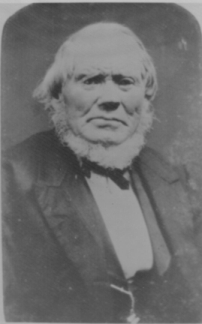 (22) Constant Wells (1801)
(22) Constant Wells (1801)Anita's 3rd Great-Grandfather, right. The name may also be Constance, per Anita's father. Perhaps he used both names.
Constant Wells, the son of Simeon Wells, was born on 14 January 1801 in Brookfield township, Orange county, Vermont, per Moses Hubbard, Town Clerk - from "Vermont Vital Records, 1760-1954."
Constant moved from Vermont to the St. Lawrence region of New York before 1823. He probably moved from Brookfield west, over the mountains, to pick up one of the rivers emptying into Lake Champlain, like the Winooski that drains the western part of Orange county. Then he went up the lake to the St Lawrence river, down that river, which borders St. Lawrence county, striking a tributory into the the region of Pitcairn.
"Settlement of the town [Pitcairn] was started by Constant Wells in 1823. At the first town meeting, 29 March 1836, Constant Wells was elected as one of the Commissioners of Common Schools and one of the Constables. - From "Child's Gazeteer of St. Lawrence", 1873-74.Constant's older brother, Dexter, joined him later and became postmaster.
Constant first married Betsey Ann White on 15 January 1826 in Edwards, St Lawrence county, New York. She was born, the daughter of Joel White and Isabel Stewart, on 23 July 1808 in Blandford, Hampden county, Massachusetts. She died on 02 November 1844, at the age of 36, in East Pitcairn, St Lawrence county, New York after the birth of her 10th child.
"A Congregational church was organized by Rev. James Murdock, of Gouverneur, at Pitcairn about 1829, with Constant Wells and fifteen others, but in course of time the death and removal of most of the members caused its discontinuance . . . There was no house of worship in the town until 1875, when Constant Wells, one of the pioneers, erected and donated a building which he named "The Union Church of East Pitcairn." It cost $1.000." - from "History of Pitcairn, NY"
| Pitcairn, New York
The town was named for Joseph Pitcairn, at one time US Consul to Paris. He was replaced in that position by Thomas Jefferson. He owned much land in the county and the town was perhaps named to placate him. The town of Pitcairn in New York is a very small village, with a current population of just 723, downstream of Montreal on the St. Lawrence river. St. Lawrence county is at the very top of the state of New York, on the St. Lawrence river, bordering Canada. While the St. Lawrence county region had good transportation via the river, it was not until railroads were built that this region was connected with the rest of the State. The first railroad was the "Northern," from Ogdensburg to Rouse's Point, on Lake Champlain, begun in 1848 and completed in two years. A north and south line was projected in 1852 from the New York Central, at Rome, to Cape Vincent on the St. Lawrence, to which a branch to Ogdensburg was built in 1862. These, with other branches, became a part of the New York Central in 1891. 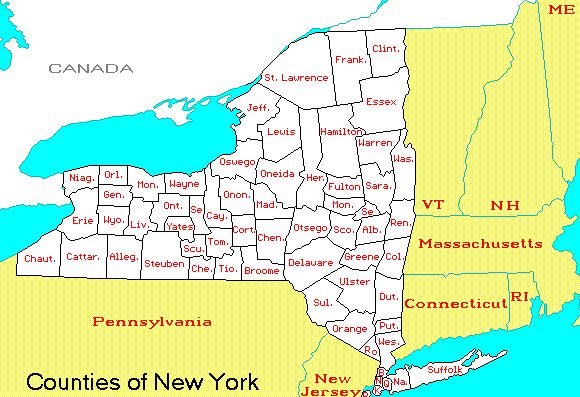 |
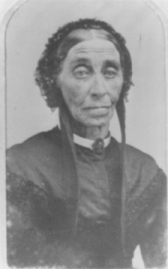 Constant donated a $1000 to have a church built for the town. He also supplied much of the information for the Pitcairn history and one of the other towns in the area, probably Edwards.
Constant donated a $1000 to have a church built for the town. He also supplied much of the information for the Pitcairn history and one of the other towns in the area, probably Edwards.
After Betsey's death in 1844 Constant married Rachel Isabel Higgins, left, on 27 February 1845 in Russell, St. Lawrence county, New York. She was born on 22 June 1808 [1807] in Russell, New York, the daughter of Nathaniel and Mary Higgins.
Constant is listed in the Federal census for 1840, 1850, 1870 and 1880 in Pitcairn township, St. Lawrence county, New York. In the 1840 census he is listed just below his brother, Dexter. He has one son under 5 years old, 1 son 5-10, 2 sons 10-15, and himself,aged 30-40. He also has one daughter aged 10-15 years old, 1 30 to 40, probably his wife, and one aged 40-50.
In the 1850 census of Pitcairn, St. Lawrence county, New York as Constant Wells, a 49 year old farmer with $1700 worth of real estate. He was born in Vermont. Living with him were his wife, Rachel S., 42, and children, Dexter, 18, Constant Jr., 14, Joel W., 9, Albert, 8, Betsey A., 4, Lloyd S., 1, and Lauren C., 1.
In the 1860 census of Pitcairn, St. Lawrence county, New York as Constant Wells, a 59 year old farmer with $2500 of real estate and $500 in other goods. He was born in Vermont. Living with him are his wife, Rachel, 52, and children, Dexter, 26, Mary N. [F?], 20, Albert, 18, Betsy A., 14, Lloyd, 11, and Laura C., 11.
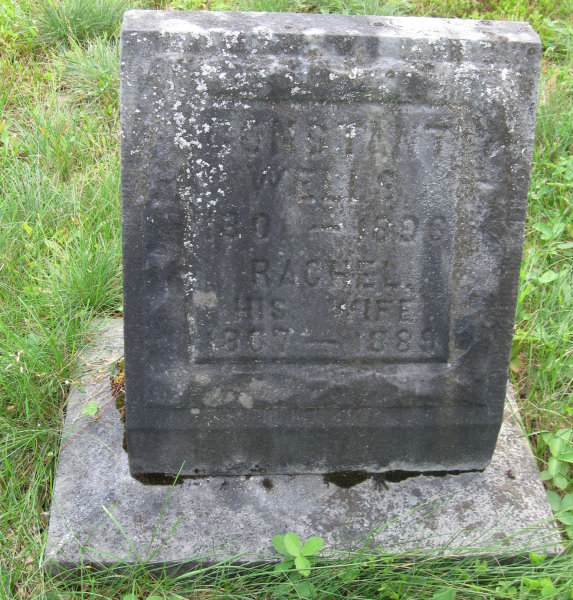 In the 1870 census of St. Lawrence county, New York as Constant Wells, a 69 year old farmer with real property worth $4,000 and other property worth $1,000. He was born in Vermont. His wife was Rachel, aged 62, keeping house. She was born in New York. Laura C. [Content] Wells was living with them, a 21 year old school teacher, born in New York. Living next door was Constant's son, Dexter, and his family.
In the 1870 census of St. Lawrence county, New York as Constant Wells, a 69 year old farmer with real property worth $4,000 and other property worth $1,000. He was born in Vermont. His wife was Rachel, aged 62, keeping house. She was born in New York. Laura C. [Content] Wells was living with them, a 21 year old school teacher, born in New York. Living next door was Constant's son, Dexter, and his family.
From the Pitcairn Business Directory - Individuals, 1873-74:
Last Name, First Name, Post Office, Occupation, Farm Acres, Comments
Wells, Constant, East Pitcairn, Farmer, 129
- Since Constant Jr. died in 1866, this must be Constant Sr.
In the census of 1880 for Pitcairn, St. Lawrence county, New Yorks as Constant Wells, 79 [born in 1801], of Vermont. A farmer, both of whose parents were born in Massachusetts. Living with him was his wife, Rachel, 79 [1809], of New York, then keeping house.
Constant died on 16 November 1885 in East Pitcairn, St Lawrence county, New York.
"Died. Wells. In Pitcairn, Nov. 16, 1886 (?), Constance Wells, aged 86 years." - from the Gouverneur, New York Herald newspaper, St. Lawrence County, New York
Rachel died on 28 October 1889 in East Pitcairn. Constant and Rachel's gravestone is shown to the right. It reads,
"Constant
Wells
1801 - 1886
Rachel
His Wife
1807 - 1889"
The children of Constant and Betsey Ann were,
(23) William Neville Wells (1827)
(23) Edwin M. Wells (1828)
(23) Isabell Welles (1830)
(23) Edwin Dexter Wells (1832)
(23) Harriet Newell Welles (1834)
(23) Constant J. Wells Jr. (1836)
(23) Charles Lymon Wells (1838)
(23) Mary N. Wells (1840)
(23) Joel White Wells (1840)
(23) Albert White Wells (1842)
(23) Male Welles (1844)
Children of Constant and Rachel Wells:
(23) Betsy Ann Welles (1846)| East Pitcairn Cemetery
Wells, Cornelius 1867-1930 Wells, Louisa his wife, 1868-1925 Wells, Frances, w/o John H. Cocagne d. Apr 2, 1891 age 32 yrs. Wells, Dexter d. June 14, 1874 age 78 yrs. Wells, Simeon d. July 25, 1897 age 73 yrs. 2 mos. Wells, Betsey E. w/o Simeon Wells d. July 20, ? 28 yrs. Wells, Charlie G. s/o S.M. Wells b. Jan 25,1864 d. Aug 27, 1867 Wells, Mary E. w/o S. Wells (no dates) Wells, Constant 1801-1896 Wells, Rachel his wife 1807-1889 |
He was born on 12 April 1827 in East Pitcairn. He died in 1860 in Kansas City, Montana.
(23) Edwin M. Wells (1828)He was born on 23 May 1828 in East Pitcairn.
(23) Isabell Welles (1830)She was born on 2 May 1830 and died on d 9 July 1846, aged 17.
(23) Edwin Dexter Wells (1832)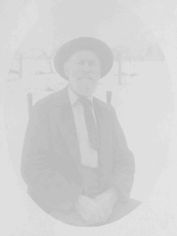 Edwin or Erwin. Known as Dexter, he was born on 8 May 1832 in Edwards [or East Pitcairn], St. Lawrence county, New York. He married Mary Constance Fanning on 1 March 1859 in East Pitcairn. She was born on 26 November 1835 in Russell, New York, the daughter of William Fanning and Similey Higgins.
Edwin or Erwin. Known as Dexter, he was born on 8 May 1832 in Edwards [or East Pitcairn], St. Lawrence county, New York. He married Mary Constance Fanning on 1 March 1859 in East Pitcairn. She was born on 26 November 1835 in Russell, New York, the daughter of William Fanning and Similey Higgins.
In the 1850 census as Dexter, aged 18, listed as the son of Constant. Also in the 1860 census with his father, Constant, aged 26.
Dexter enlisted as a Private on 12 March 1862 in Company D, 11th Cavalry Regiment of New York. He was 29 years old. Dexter was mustered out, still a Private, on 11 March 1865 in Memphis, Tennessee. His pension records confirm his service, as Dexter Wells Jr.. I am now uncertain whether this notation was for Constant's son or Dexter's, above. The use of the Jr. implies the former, but 'our' Dexter was later called the '2nd' at a time when he was living next door to Constant, implying a closer relationship. This is still unresolved. However, the following is clearly for Constant's son: From "Town clerks' registers of men who served in the Civil War, ca. 1865-1867": 16 Wells, Dexter, [born] 1832, [in] Pitcairn, NY, [father] Constant, [mother] Betsy Ann White. Simeon Wells, Dexter's cousin, was also in the 11th, enrolling earlier, on 18 December 1861 at Pitcairn.
| The 11th New York Cavalry Regiment
Colonel James Swain organized the regiment, made up primarily of urban and rural New Yorkers, on Staten Island from December 1861 to May 1862. They were known as "Scott's 900," in honor of Thomas A. Scott, Assistant Secretary of War, who was a friend of James Swain. Swain was attempting to organize a unique regiment with distinctive uniforms. There were ten companies of 89 men and a general staff of ten officers. Each company used a different type of horse in order to distinguish one company from another. One company, for example, was given sorrels, another grays, and another used bays. It was rare to have a volunteer unit of cavalry and Swain decided that his unit would be a regiment of Regular Calvary and not under State command. Company D was recruited from the Canton, Colton, Pitcairn, Potsdam and Ogdensburg areas. During recruitment the regiment grew to 850 men. Their days on Staten Island were spent in the constant drilling necessary to make farmers, clerks, boatmen and teachers into a crack cavalry outfit. The regiment left New York on 5 May 1862 for Washington, D.C. They were attached to the Military District of Washington and the 22nd Army Corps, Dept. of Washington, from May 1862 to March 1864. They were a Detachment In 8th Army Corps, Middle Department. They were stationed at Camp Relief, named thus not because it offered relief to the men, but after the wife of Colonel Swain, Relief Swain. At the camp there was a huge parade ground where the regiment practiced and drilled with swords and revolvers. An oval track that ran around the parade ground was used for exercising the horses. The regiment did a lot of Provost work in Washington, making many mounted patrols in Virginia and Maryland. Throughout the summer, the regiment made raids on suspected Confederate recruiting areas in Maryland and captured many new rebel recruits.
On the expiration of their term of service the original members, except veterans, were mustered out and the veterans and recruits were consolidated on 21 July 1865, into a battalion of four companies, which remained in service until 30 September 1865, when it was mustered out at Memphis, Tennessee. Service.--Duty in the Defenses of Washington, D.C., until March, 1864. Action at Blue Ridge Mountain, Va., June 18, 1862. Poolesville, Md., December 14. Near Fairfax Court House, Va., June 27, 1863 (Cos. "B" and "C"). Bolivar Heights June 30. Harper's Ferry July 7. Near Harper's Ferry July 14. Halltown July 15. Edwards' Ferry, Md., August 27 (Detachment). Expedition from Leesburg August 20-September 2 (Co. "F"). Rockville, Md., September 22. Ordered to Dept. of the Gulf March. 1864, and duty in the District of LaFourche, La., until June, and in the District of Baton Rouge, La., until August. Action at New River, La., May 15. Manning's Plantation June 10 and July 20. Orange Grove, near Donaldsonville, July 31. Doyall's Plantation and Donaldsonville August 5. Expedition from Baton Rouge, La., to Clinton, Greensburg, Osyka and Camp Moore October 5-9. Bayou Sara October 5. Lee's Expedition from Baton Rouge to Brookhaven, Miss., and skirmishes, November 14-21. Brookhaven, Miss., November.IS. Near Jackson November 21. Clinton November 23. Liberty, Miss., November 24. Davidson's Expedition from Baton Rouge, La., against Mobile & Ohio Railroad November 27-December 13. Franklinsville November 27. Ocean Springs December 27. Ordered to Memphis, Tenn., February, 1865. Expedition from Memphis, Tenn., into Northern Mississippi March 3-11. Germantown March 28 and April 18. Duty at Memphis, Tenn., and in District of West Tennessee until September. Mustered out at Memphis, Tenn., September 30, 1865, and honorably discharged from service.
They fought in the following battles:
The regiment lost 344 men during the war: 25 from battle or wounds; 43 drowned at sea when the steamer North America sank off the coast of Florida on December 22, 1864; and the majority, 256 men, died from disease. One out of every four men in this regiment died from disease.
See also: "'Scott 900' Eleventh New York Cavalry, from the St. Lawrence River to the Gulf of Mexico, 1861-1865," by Thomas West Smith, Chicago, 1897. |
In the 1870 census Dexter, called Dexter 2nd [to differentiate him from his uncle?], was a 32 year old [should be 38, he appears to be getting younger in every census] farmer with real property worth $2,400 and other property worth $1,200. He was shown as born in New York. His wife was Mary, 33, keeping house and also born in New York. Their children were Carrie I., 9 years old, and Erwin D., 4 years old. In all the census' he is living at a property next door to his father, Constant.
From the Pitcairn Business Directory - Individuals, 1873-74:
Last Name, First Name, Post Office, Occupation, Farm Acres, Comments
Wells, Dexter 2d, East Pitcairn, Farmer, 133 - This is Constant's son, Dexter.
In the 1880 census Dexter, a farmer, is 48 years old [more like it], living with Mary C. Wells, aged 44, Carrie I., 18, Erwin, 13, and and John C., 8.
Dexter moved his family to South Dakota. This was probably as a result of his daugther, Carrie's, marriage of his daughter in 1882.
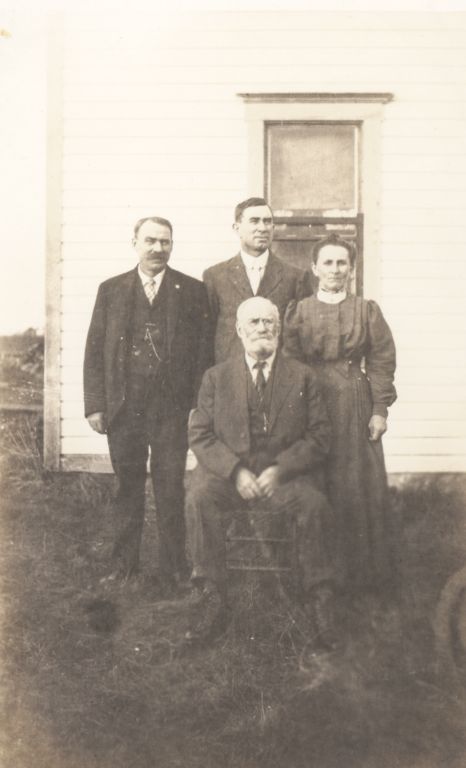 They lived in South Dakota from about 1882 to 1899. A Dexter Wells was listed in the South Dakota 1890 Veterans schedule, living in Hamlin county, Ed.212 township. This is just northeast of Kingsbury county, where Lloyd Sylvester lived in 1890. Edwin's wife, Mary, died on 15 May 1895 in Bryant, South Dakota. She was buried in the Woodlawn cemetary. Left is Dexter Wells with his children Edwin, John and Carrie
They lived in South Dakota from about 1882 to 1899. A Dexter Wells was listed in the South Dakota 1890 Veterans schedule, living in Hamlin county, Ed.212 township. This is just northeast of Kingsbury county, where Lloyd Sylvester lived in 1890. Edwin's wife, Mary, died on 15 May 1895 in Bryant, South Dakota. She was buried in the Woodlawn cemetary. Left is Dexter Wells with his children Edwin, John and Carrie
Edwin and family, along with Carrie Isabell Wells' family, arrived in Oregon in 1899. He was in the 1910 census of Aumsville precinct, Marion county, Oregon, 77 years old, living with his son John. In the 1920 census of Shaw, Marion county, Oregon, a 87 year old man, lliving with his daughter, Carrie McAllister and her husband and family. He died on 26 July 1920 in Salem [or Shaw], Oregon. He is buried in the Pioneer cemetary, Salem, Oregon.
(24) Carrie Isabell Wells (1861)She was born on 24 July [June] 1861 in East Pitcairn. She married William Orgail Chadwick on 1 January 1882 in Pitcairn. He was the son of Ira Chadwick and Eleanor Spaulding. He had been born in 1862 in Pitcairn, St. Lawrence county, New York. He apparently took Carrie out west because their first child, Gertrude, was born in Bryant, South Dakota in 1885. William died on 27 October 1887 in Bryant of "malaria and brain fever." Was it he that pulled the Edwin Dexter Wells family out to South Dakota?
Carrie married Charles McAllister on 10 August 1891 in Bryant, South Dakota. He was born on 13 September 1863 in New York. The Dexter Wells clan, including Carrie and her husband, left Pitcairn, New York, probably around 1890, and lived in South Dakota from at least 1890 to 1899.
Charles and Carrie, the five children, and Carrie's father, Dexter Wells, came to Shaw, Oregon in 1899. They had a store in Shaw and Charles had the Star Rt. from the Post Office where Carrie was postmaster for several years before they bought a small farm. They had a prune farm and dried them. In the 1910 census of Aumsville precinct, Marion county, Oregon as Carrie McAllister. Her sons, Glenn, 17, Dexter, 14, and Vernon, 12 were all born in South Dakota. In the 1920 census for Shaw, Oregon living with her husband, Charles, and son, Dexter. She died on 24 April 1944 in Eugene, Oregon. Charles died on 8 February 1946 in Salem.
(24) Edwin Dexter Wells Jr. (1866)He was born on 22 April 1866 in East Pitcairn. In the 1880 census, aged 13, living with his father. The Dexter Wells clan left Pitcairn, New York, probably around 1882, and lived in South Dakota from about 1882 to 1899. He married Julia McAllister, his sister-in-law, on 25 November 1886 in South Dakota. She died on 6 February 1890 in Bryant, South Dakota. Next he married Luella Perkins on 22 February 1893 in Bryant. She was born on 7 July 1871 in Cedar Falls, Blackhawk county, Iowa, the daughter of James Perkins and Alice.
They arrived in Oregon in 1899. In the 1910 census of Aumsville precinct, Marion county, Oregon, as Erwin D. Wells, a 43 year old farmer from New York. Living with him were his wife, Luella A., 34, who was from Iowa, and Merrill E., 12, and Eva M., 9, both of whom had been born in South Dakota. Edwin died on 24 March 1914 in Shaw, Oregon, predeceasing his father.
Luella Wells, a 46 year old widow, was living in Salem, Oregon at the time of the 1920 census. Living with her were Byron, 30, who was born in South Dakota, and Merle, 22, both laborers in a saw mill, and Eva, 18. Luella died on 13 January 1956.
(25) Byron Dexter Wells (1890)The son of Julia McAllister, he was born on 26 April 1889 in Bryant, South Dakota. He married Hazel Bradshaw on 21 July 1921 in Salem, Oregon. She was born on 30 March 1890 in Bryant, South Dakota. He died on 11 December 1955 in Aumsvill, Oregon. She died in December 31, 1978 in Salem, Oregon.
(26) Erwin Dudley Wells (1923)He was born on 29 January 1923. He married Doris Franke on 5 March 1948 in Salem, Oregon. They had one childe, Linda Sue Wells, who married a Woods.
(26) Lyle B. Wells (1927)He was born on 19 February 1927. He married unknown.
(27) Wendell A. Wells (1950)He was born on 9 April 1950.
(27) Jeffrey L. Wells (1952)He was born in June 1952.
(26) Stanley B. Wells (1929)He was born on 27 March 1929.
(25) Merle [Merrill] E. Wells (1898)The child of Luella Perkins. He married Marion. He was born on 1 December 1897 in South Dakota. He died in 1978 in Redmond, Oregon.
(26) Eldon Wells(26) Ray Wells
(26) Mary Ann Wells
(26) Teresa Wells
(25) Eva Mae Wells (1902)
She was born on 21 March 1901 in Bryant, South Dakota. She married Fredrick H. Kaiser. He died on 10 December 1935 in Salem, Oregon. Next she married Theo C. Amend on 6 October 1936 in Chehalis, Washington. He was born on 13 April 1887 in Chilton, Washington. He died in 1960. She died on 7 August 1997 in Salem, Oregon.
(24) John Constant Wells (1871)He was born on 25 October 1871 in East Pitcairn. In the 1880 census, aged 8, living with his father in New York. The Dexter Wells clan left Pitcairn, New York, probably around 1882, and lived in South Dakota from 1892 to 1899. He married Edith May Perkins, the sister of Luella, on 10 October 1894 in Bryant, South Dakota. She was the daughter of James Perkins and Alice. She was born on 7 June 1877 in Cedar Falls, Blackhawk county, Iowa. She died on 15 August 1903 in Bryant, South Dakota.
He arrived in Oregon after the rest of the clan. John had a farm north of Salem in the keizer district. He married Floy [Florence] Cummings on 12 October 1904 in Shaw, Oregon. This was a double wedding with her sister, Sibyl Alice Cummings. Sibyl married Chester W. Laughlin. Florence was born in 1885. Floy and Sibyl's parents were Mr. and Mrs. William L. Cummings. Floy was born on 4 August 1875. In the 1910 census of Aumsville precinct, Marion county, Oregon, as John C Wells, a 38 year old farmer raising poultry. Living with him were his wife, Florence, 34, who was from Wisconsin, and Ruth, 13, Grace, 6, both born in South Dakota, and Lois, 4, born in Oregon, as well as his father, Dexter, who was 77 years old.
Floy died on 31 August 1915 in Shaw, Oregon. Next he married Iona May Campbell in 1916. She was born on 15 July 1885. In the 1930 census for Chemawa, Marion county, Oregon, as J.C. Wells, a 59 year old farmer. Living with him was his new wife, Iona, 47, of South Dakota. She was a saleperson at a bakery. John died on 5 September 1944 in Salem, Marion county, Oregon. Iona died in December 1971 in Klamath Falls, Oregon.
(25) Ruth Alice Wells (1897)She was born on 1 June 1896 in Bryant, South Dakota and was the daughter of John Constant Wells and Edith May Perkins. She married William Ware Oglesbly on 2 December 1916 in Salem, Oregon. At the time of the 1920 census Ruth was 23 years old, living in Turner, Marion county, Oregon with her husband, William. Both were employees at the State Reform School. She was a bookeeper and he was a farmer. She died on 31 December 1976 in Eugene, Oregon.
(25) Grace Edith Wells (1904)She was born on 25 May 1903 in Bryant, South Dakota. At the time of the 1920 census Grace was 16 years old, living in Turner, Marion county, Oregon, an employee at the State Reform School, as was her sister. Her occupation, however, was listed as none. She married Lynn Hill. He was born on 28 January [] in Michigan. He died on 17 February 1965 in Salem, Oregon. She died on 24 May 1984 in Salem, Oregon.
(25) Esther Lois Wells (1906)She was born on 22 April 1906. She married Edgar Edwin Sawyer on 31 May 1928. She died on 1 January 1979 in Salem, Oregon.
(25) Margaret Constance Wells (1910)She was born on 10 June 1910 in Shaw, Oregon. She married Van A. Spores on 31 May 1938. She died on 5 May 1997 in Keizer, Oregon.
(23) Harriet Newell Welles (1834)She was born on 7 May 1834 in East Pitcairn and died on 22 May 1935. I don't see Harriet in the 1850 or 1860 census.
(23) Constant J. Wells Jr. (1836)He was born on 10 July 1836 in Pitcairn. In the 1850 census for Pitcairn, St. Lawrence county, New York he was 14 years old, born in approximately 1836. Per his tombstone, below, this was probably on 10 July 1836.
He was a Civil War veteran. From "Town clerks' registers of men who served in the Civil War, ca. 1865-1867": 12 Wells, Constant Jr, [born] 1836, [in] Pitcairn, NY, [father] Constant, [mother] Betsy Ann White.
He enlisted as a Private on 25 October 1861 at the age of 25 in Company D, 60th Infantry Regiment of Odensburgh, New York [as did his younger brother, Joel White Wells. There's an Abraham and a George Wells in the company as well, both enlisting around the same time. I don't know if they're related.]. Company D was under the command of Captain Winslow M. Thomas. Constant received a disability discharge, while still a Private, from the 60th on 30 October 1862 in York, Pennsylvania. This was soon after the battle of Antietam. I have another source that says Constant Wells was honorably discharged from Company D, 60th Regiment in Newark, New Jersey. - from "History of the Sixtieth Regiment New York State Volunteers" by Richard Eddy.
His pension record shows assignments to both Company D, 60th New York Infantry and Compnay H, 20th New YOrk Cavalry. I assume he was well enough in 1863 to join the newly forming 20th Cavalry. From "History of St. Lawrence County," New York, published by L. H. Everts & Company, 1878: He enlisted as a Private in this cavalry unit on 27 August 1863 at Gouvernor, St. Lawrence county, New York. Company H was under the command of Captain J. Bower Preston Jr. His pension papers show a widow named Amanda H. Wells. He mustered out, as a Sergeant.
| The 60th New York Infantry Regiment
Also known as the St. Lawrence Regiment, they saw extensive service in most of the hot spots of the war. They were organized at Ogdensburg, New York on 30 October 1861 and mustered out at Alexandria, Virginia on 17 July 1865. During the war they lost 3 officers and 64 enlisted men killed and mortally wounded and 5 officers and 96 enlisted men by disease. Part of the 12th Corps, 2nd Division, 3rd Brigade, under Colonel Abel Godard. There is a monument to the regiment on Culp's Hill, Gettysburg. The left the State for Baltimore, Maryland on 4 November 1861. Attached to Dix's Division to March 1862. Railroad Brigade, Army of the Potomac, to June 1863. 2nd Brigade, Sigel's Division, Department of the Shenandoah, to 26 June 1862. 2nd Brigade, 2nd Division, 2nd Corps, Pope's Army of Virginia, to August 1862. 3rd Brigade, 2nd Division, 2nd Corps, Army of Virginia, to September 1862. 3rd Brigade, 2nd Division, 12th Army Corps, Army of the Potomac, to October 1862. 2nd Brigade, 2nd Division, 12th Army Corps, to May 1863. 3rd Brigade, 2nd Division, 12th Army Corps, Army of the Potomac, to October 1863, and Army of the Cumberland to April 1864. 3rd Brigade, 2nd Division. 20th Army Corps, Army of the Cumberland, to July 1865. Service.--Duty at Baltimore, Md., and between there and Washington, D.C.; also at Relay House, Md., and Harper's Ferry, W. Va., until June, 1862. Defense of Harper's Ferry May 28-30. Operations in the Shenandoah Valley until August. Pope's Campaign in Northern Virginia August 16-September 2. Sulphur Springs August 24. Battle of Groveton August 29. Bull Run August 30. Maryland Campaign September 6-22. Battle of Antietam, Md., September 16-17. It was just after this that Contant Jr. got his disability discharge from the 60th. Duty at Bolivar Heights until December. Reconnaissance to Rippon, W. Va., November 9. Expedition to Winchester December 2-6. March to Fredericksburg, Va., December 9-16. Duty at Fairfax until January 20, 1863. "Mud March" January 20-24. Chancellorsville Campaign April 27-May 6. Battle of Chancellorsville May 1-5. Gettysburg (Pa.) Campaign June 11-July 24. Battle of Gettysburg, Pa., July 1-3. Pursuit of Lee to Manassas Gap, Va., July 5-24. Duty on line of the Rappahannock until September 24. Movement to Bridgeport, Ala., September 24-October 3. Duty in Lookout Valley until November. Reopening Tennessee River October 26-29. Chattanooga-Ringgold Campaign November 23-27. Battles of Lookout Mountain November 23-24. Mission Ridge November 25. Ringgold Gap, Taylor's Ridge, November 27. Duty at Bridgeport, Ala., until May, 1864. Scout from Stevenson to Caperton's Ferry April 11 (Detachment). Veterans on furlough December, 1863-January, 1864. Atlanta (Ga.) Campaign May 1-September 8. Operations about Rocky Faced Ridge, Tunnel Hill and Buzzard's Roost May 8-11. Battle of Resaca May 14-15. Near Cassville May 19. New Hope Church May 25. Battles about Dallas, New Hope Church and Allatoona Hills May 26-June 5. Operations about Marietta and against Kenesaw Mountain June 10-July 2. Pine Mountain June 11-14. Ackworth June 12. Lost Mountain June 15-17. Gilgal or Golgotha Church June 15. Muddy Creek June 17. Noyes Creek June 19. Kolb's Farm June 22. Assault on Kenesaw June 27. Ruff's Station, Smyrna Camp Ground, July 4. Chattahoochie River July 6-17. Peach Tree Creek July 19-20. Siege of Atlanta July 22-August 25. Operations at Chattahoochie River Bridge August 26-September 2. Occupation of Atlanta September 2 to November 15. Expedition from Atlanta to Tuckum's Cross Roads October 26-29. Near Atlanta November 9. March to the sea November 15-December 10. Near Davisboro November 28. Siege of Savannah December 10-21. Campaign of the Carolinas January to April, 1865. North Edisto River, S.C., February 12-13. Battle of Bentonville, N. C., March 19-21. Occupation of Goldsboro March 24. Advance on Raleigh April 9-13. Occupation of Raleigh April 14. Bennett's House April 26. Surrender of Johnston and his army. March to Washington, D. C, via Richmond, Va., April 29-May 20. Grand Review May 24. Mustered out July 17, 1865. |
| The 20th New York Cavalry Regiment
"McClellan Cavalry." On 19 June 1863, Colonel Newton B. Lord received authority to recruit this regiment, which received its numerical designation on 8 October 1863, and was organized at Sackett's Harbor, where its companies were mustered in the service of the United States for three years. Colonel Lord was previously with the New York 35th Regiment of Infantry, the "Jefferson County Regiment", which had seen action at Bull Run, Antietam and Fredericksburg and was mustered out in June 1863. Constant Jr. was in Company H, which was mainly recruited in Antwerp, DeKalb, Edwards, Fowler and Gouverneur in St. Lawrence county. The regiment left the state on 30 September 1863 and served in the 22nd Corps from October 1863. The unit remained in the Department of Virginia until January 1864 when it joined Heckman's Division, 18th Corps. It was involved in the defenses of Portsmouth in the District of East Virginia, Department of Virginia and North Carolina from April 1864 and was with the 1st Brigade, Kautz's Division, Cavalry, Army of the James, from December 3 1864. The regiment was honorably discharged and mustered out under the command of Colonel David M. Evans 31 July 1865, Companies E and H at Fort Monroe, the other companies at Manchester, Virginia. |
At some point Constant married Amanda Hannah Seabury. She was the daughter of Stephen Seabury, an early settler in Pitcairn, and Hannah. Constant died on 11 November 1866 and was buried in the Waukau cemetary in the village of Waukau, Winnebago county, Wisconsin. Per his headstone, he died on 19 November 1866 at the age of 30 years, 4 months and 9 days. Other records indicate 11 November. That would make his date of birth 10 July 1836. Amanda later married Zelotus [Zelatus] M. Clarke. She was also buried in the Waukau cemetary next to Constant, her tombstone showing she was born 17 February 1842 and died on 9 August 1892, the wife of Z.M. Clark. Also buried there was her father, Stephen Seabury, born in Maine on 24 March 1801 and died on 28 January 1879, aged 78 years, 10 months, and 4 days. There was a tombstone for her mother, Hannah Seabury, who died on 28 February 1844, aged 44 years, shown as Stephen's wife. I understand that Hannah died in New York and was actually buried there, in the Garrison Cemetery in Pitcairn, New York. Amanda's second husband was not buried in Waukau.
| Waukau, Winnebago county, Wisconsin
|
How did Constant Jr. come to die in Wisconsin almost a year and a half after the Civil War ended? My guess is that he married Amanda upon his return in the summer of 1865. They almost immediately made plans to move west and, with Amanda's parents, settled in Wisconsin. Constant probably died, not from lingering wounds as I one-time thought, but of the usual dangers of the frontier.
(23) Charles Lymon Wells (1838)He was born on 23 May 1838. This may be incorrect. I don't see him in the 1850 census.
(23) Mary N. Wells (1840)In the 1860 census of East Pitcairn as the 20 year old daughter of Constant Wells. She was born in New York. Her middle initial may have stood for Newell, as with her older sister.
(23) Joel White Wells (1840)He was born on 21 October 1840. His middle name was given in honor of his maternal grandfather, Joe White. In the 1850 Pitcain census as Joel W., 9, living with his father. In the 1860 census he was not in Pitcairn, but there was a Joel Wells, aged 19, in the Potsdam, Saint Lawrence county, New York census. He was a farm laborer living in the house of his employer, Nancy Parmenter.
A Civil War veteran. From "Town clerks' registers of men who served in the Civil War, ca. 1865-1867": 10 Wells, Joel White, [born] 1840, [in] Pitcairn, NY, [father] Constance, [mother] Betsy Ann White. He died on 21 February 1863. From his date of death, I would assume it was war related.
Enlisted as a Private on 12 September 1861 at Ogdensburg, New York at the age of 21.
Enlisted in Company D, 60th Infantry Regiment New York [as did his older brother, Constant Wells Jr.] on 30 October 1861.
Received a disability discharge, still a Private, from Company D, 60th Infantry Regiment New York on 09 February 1863 in Philadelphia, Pennsylvania. He died soon after. His older brother, Constant Jr., had left the company in October 1862 on a disability.
He appears to have never married.
(23) Albert White Wells (1842)He was born on 18 [19] July 1842. His middle name is, I believe, derived from the maiden name of his mother, Betsey Ann White. In the 1850 Pitcairn census living at home, aged 8. In the 1860 census of Pitcairn, New York as an 18 year old farmer, living with his father, Constant. I don't see him in the 1870 census.
Charlotte Read Kensil writes,
"I was trying to determine the parents of Albert White Wells and found your website today. I had a birth date and his birthplace as East Pitcairn, NY so that led me to the Wells page. I am fairly sure that the Albert White Wells that I was researching belongs to the family group of Constant and Betsey.(23) Male Welles (1844)
Albert married Ida Bell Read, who was the daughter of my g-g-uncle John Butler Read and his wife Emerline Perkins. (I think that makes her my first cousin many times removed).
Recently, I set up a findagrave page for Albert and Ida. A kind photo volunteer took pictures last week. Albert's birthdate matches the birth date on your page (also the birth location).
Find A Grave.
The information that I have is that Albert H. White Wells was born in East Pitcairn, St. Lawrence, New York on July 19, 1842. He married Ida Bell Read on 14 Nov 1876 in LaSalle County, Illinois. He died in Modesto, Stanislaus, California on May 14, 1917. I don't know where he was initially buried but my information is that in 1919, he was re-interred in Modesto Pioneer cemetery.
Ida Bell Read was born on 13 March 1855 in Saratoga County, New York and died on 5 April 1938. Her parents were John Butler Read and Emerline Perkins of Stillwater, Saratoga, New York.
Albert and Ida's children were:
1) Corrie or Carrie M. Wells, born March 1878 in Illinois and died sometime before 1910. The family was living in Nebraska in 1900. I do not have more information but I now wonder if he went by "Connie" (for Constant) and it was mistranscribed by the census takers.
2) Loren Edmund Wells, born May 8, 1887 in Nebraska, married Myrtle (LNU), died 5 Oct 1970 in Oakland, CA.
3) Ella Francis Wells, born Aug 1888 in Nebraska, married a Charles Carroll, then a John C Brown. My last location for her was Merced, CA in 1967.
Hope this info is helpful to you. I was very happy to find your website and to make a match of the birthdate and hence, his parents."
Born on 12 October 1844 and died in December 1844. His death may be related to his mother's in November 1844.
Children of Constant and Rachel Wells:
(23) Betsy Ann Welles (1846)She was born on 4 May 1846 in East Pitcairn. I assume she was named in honor of Constant's recently deceased first wife. In the 1860 census of Pitcairn, New York, aged 14. She died in 1863
(23) Lauren [Laurie/Laura] Content Welles (1848)Was her middle name Constance? She was born on 12 October 1848 in East Pitcairn. In the 1860 census of Pitcairn, New York, aged 11. She married Alonzo Graham. He was born 1849 in East Pitcairn and died in February 1913. Laura died on 24 May 1934 in East Pitcairn.
The Wells Family in CaliforniaAnita's 2nd Great-Grandfather. The twin of Laura Content. His surname is sometimes spelled Welles. He was born on 12 October 1848, in East Pitcairn, St. Lawrence county, New York. The twins were named after Content Wells, Constant's older sister, and Sylvester Bacon, her husband. In the 1850 census of Pitcairn, Saint Lawrence county, New York as Lloyd S. Wells, aged 1. Also in the 1860 census for Pitcairn, aged 11. I don't see him in the 1870 census, when he would have been 21 years old. He was not living at home, like his twin, Laura.
Lloyd moved to Illinois, still a single man, sometime before 1874, perhaps he was on the move during the 1870 census. He probably traveled down the St. Lawrence river, through the Great Lakes to Chicago, then down the railroad, or the Illinois river, to the prairie country of Illinois. While the Vermillion river, running northwest, is a tributory of the Illinois river, by the middle of the 19th century railroads had become the chief means of transportation and Odell, in Livingston county, was on the main line.
Lloyd S[ylvester] Wells married Clarissa C[aroline] Lopeman, aged 27, on 27 December 1874 in Normal, Mclean county, Illinois - from Volume H, page 5, McLean County, Illinois "Marriage Record Index." She was from Illinois.
The 1880 Fedeal census for Odell, Livingston county, Illinois lists a Lloyd S. Wells, head of household, born in 1849, in New York, aged 31. He was a farmer. His mother's birthplace was New York, but his father's was blank. His wife was Clara Wells, aged 23, born in Illinois. She was keeping house. Her Father was from Pennsylvania, her mother from New York. Their children included Albert L. [named for Lloyd's next eldest brother?], aged 4, Laura A. [named for his twin?], aged 2, and Wesley L., aged 10 months. The children were all born in Illinois.
Below is Lloyd Syvester and his wife, Clarissa Caroline (Lopeman). The boy standing behind his father is Albert Lloyd Wells.
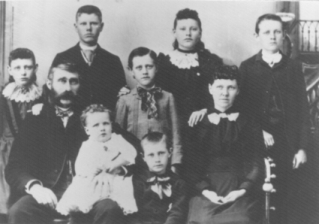
| Livingston County
|
At some point after the 1880 census and before 1883, Lloyd moved to South Dakota and became a rancher and farmer. He was not listed in the South Dakota Territorial census of 1885, but he was in the state by at least 1883, when Jesse W. Wells was born. In 1889 Bessie Welles was born in in Hartland, Kingsburg county, South Dakota. Around 1890 Erwin Dexter Wells, Lloyd's elder brother, was in Hamlin county, South Dakota, the next county to the northeast.
From 'Federal Land Records, Kingsbury county, South Dakota' : Wells Lloyd S., Homestead patent for 160 acres at 112 N 055 W, Section 8, dated 27 January 1891. From 'Suspended Land Entries, South Dakota, 1891, Watertown, South Dakota Land Office': Lloyd S. Wells. This latter is a list of land entries that were suspended and adjudicated by the Federal Commissioner of the General Land Office during the fiscal year ending 30 June 1891.
Lloyd moved to Pomona, California in about 1895 and started a dairy farm. Perhaps they had suffered one too many Dakota winters. Note that Erwin Dexter Well's clan stayed in South Dakota until at least 1904. Lloyd's son Albert, aged about 19 at the time, brought the cattle by train from South Dakota to Pomona.
In the 1910 census Lloyd S. Wells was living in the 4th ward, Riverside, Riverside county, California, aged 61, on 256 East 94th Street. It shows that Lloyd and his mother were born in New York, but has his father as born in Connecticutt. Lloyd was a foreman in a Milling Company. Living with him were his wie, Clara C., 52, Jesse W., 26, born in Dakota, and Harry B., 16, Eva N., 13, and Lizzie A., 11, all born in California.
LLoyd S. Wells died on 24 November 1917 in Riverside, California. He was buried in the Evergreen Memorial Park and Mausoleum in Riverside.
In the 1920 census of Riverside Clara C. Wells, 62. Living with her were Harry B., 26, N. Eva [Eva N.], 24, and L. Amy [Lizbeth A.], 20. Clarissa died on 13 July 1930, also in Riverside, California.
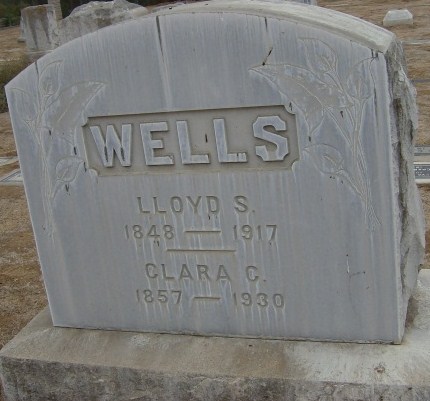
Lloyd and Clarissa eventually had eleven children,
(24) Albert Lloyd Wells (1875)
(24) Laura Althea Wells (1877)
(24) Wesley Louis Wells (1879)
(24) Augusta "Gussie" Clara Wells (1881)
(24) Jesse W. Wells (1883)
(24) George Lucian Wells (1885)
(24) Bessie Wells (1889)
(24) Merrill Allen Wells (1890)
(24) Harry Byron Wells (1893)
(24) Eva N. Wells (1897)
(24) Elizbeth Amy Wells (1899)
Anita's Great-Grandfather. He was born on 15 September 1875 in Odell, Livingston county, Illinois. In the 1880 census of Odell, Livingston county, Illinois he was known as Albert L. Wells, 4 years old, living at home with his parents, Lloyd S. and Clara Wells.
Shortly after 1880 the family moved to Kingsbury county, South Dakota, and stayed there until at least 1890. The family then moved to Pomona, California, transporting their dairy cattle by train. They made this move sometime between 1890, when Merrill Wells was born in South Dakota, and 1893, when Harry Byron Wells was born in California. Pomona is about 20 miles west of Riverside, where the family eventually settled down.
| Pomona
Located due east of Los Angeles, Pomona began as a Spanish land grant in the 18th century. The southern portion of the Rancho San Jose was sold to speculators from Los Angeles in 1875. They named the area "Pomona" after the Roman goddess of fruit and fruit trees. Vineyards flourished in the 1880's supplying the winemaking and raisin industries. Citrus orchards and olive groves replaced vineyards in the 1890's. Today the city has been absorbed by the Los Angeles mega-city. In the late nineteenth century California was already known as the Golden State, first for its gold strikes from the middle of the century, but later as well for its golden weather and citrus groves. |
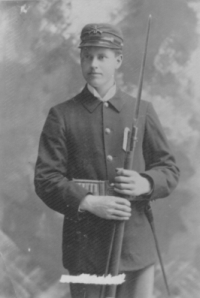 Was Albert ever known as Bert L? Pension documents refer to an Albert, alias Bert, as being a member of the D7 California infantry. I think this refers to company D of the 7th California Volunteer Infantry. They were called up for the Spanish American War. His photograph, left, was taken while he was stationed at the Presidio in San Francsico.
Was Albert ever known as Bert L? Pension documents refer to an Albert, alias Bert, as being a member of the D7 California infantry. I think this refers to company D of the 7th California Volunteer Infantry. They were called up for the Spanish American War. His photograph, left, was taken while he was stationed at the Presidio in San Francsico.
| The 7th California Volunteer Infantry Regiment
The Seventh Infantry of the California National Guard was mustered into Federal service on 9 May 1898 at San Francisco. It was comprised of 979 men and 50 officers. 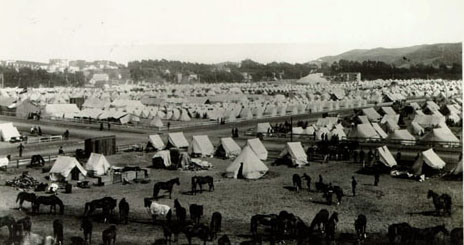
The Regiment was moved to Camp Merritt, left, the staging area for the expedition, located just north of Golden Gate Park, on 25 May 1898. Eighteen thousand men were encamped in the camp, occupying it only until the fleet upon which they embarked was assembled and fitted for their reception. There was considerable sickness, especially measles. Some cases typhoid fever also appeared. The 7th California was camped at about Arguello and Euclid. The camp was abandoned on 27 August 1898.
The 7th California was assigned to the steamship INDIANA, scheduled to sail for the Phillipines on 25 June 1898. Below is a photograph of California Transport INDIANA receiving troops and freight at Pacific Mail Docks on the eve of departure, on 27 June 1898 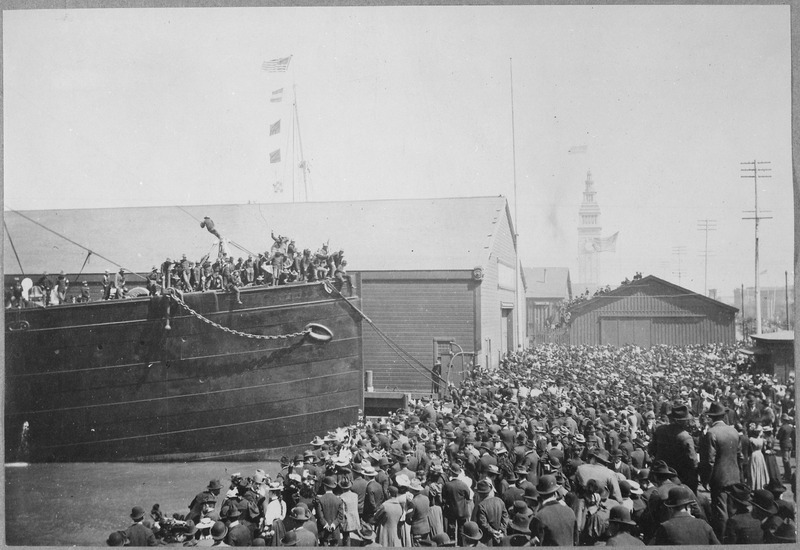 The dock was located at First Street between Brannan and Townsend streets, and is now a segment of First Street called Delancey Street in the newly-developed South Beach neighborhood. This is just north of the ball park.
On 13 October 1898 the regiment was ordered to Los Angeles and furloughed. They reassembled on 12 November and established Camp Pratt at present day Exposition Park in Los Angeles. The war was over and the Regiment was mustered out of Federal service at Los Angeles on 2 December 1898. In Pershing Square, Los Angeles, there is a monument, right, by Samuel M. Goddard dated 1900. From the monument: "7th California Infantry. War with Spain, 1898." Nice bird on the statue's head. |
Bert L. Wells filed for pension benefits in California on 7 July 1923, in the invalid class. He was awarded benefits under certificate number 1238531.
In the 1900 census of . . . There is a Burt Wells, a 23 year old farm laborer, living in Township 1, Inyo county, California at this time, but he came from Ohio, and was born in April 1877. This does not appear to be our man.
Albert married Gertrude Margaret Nelligan on 17 December 1903 in Tonopah, Nevada, pictured below, circa 1913. Nellie was the daughter of Henry P. Nelligan and Annie Murphy. Henry was a house painter in Virginia City, Reno, and later in Bishop, where he was living circa 1900. Annie, meanwhile, had been a singer in the Virginia City opera house before she married Henry. How did Albert and Gertrude end up getting married in Tonopah? Gertrude's brother, William, a bachelor, was the president of a mining company in Tonopah in 1903, so she might have been keeping house for him. Albert may simply have been footloose.
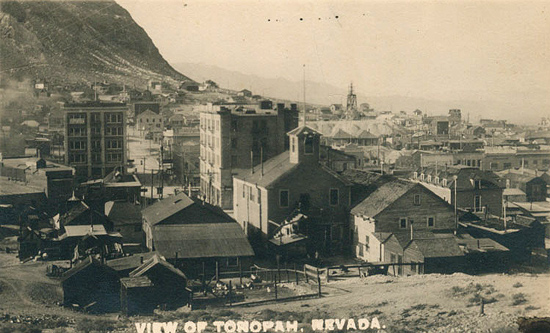
| The Nelligan's in Virginia City, Nevada
(22) Michail Nelligan (c1823) According to a researcher of the Caffery Family, he was born in Ireland. He married Johanna Kirby, also born in Ireland. They moved to Belle Vernon, Pennsylvania and had a son, Henry P. Nelligan. Michael was possibly the brother of William Nelligan, of county Kerry, Ireland. "My 3g grandfather, William (b. about 1810), and his wife, Julia (b. about 1818), arrived in New York between 1847 and 1851 with their son Timothy (b. 1846) and supposedly William's brother, Michael. Their last name may have been changed from Neligan to Nelligan. I have a copy of William's intention paper, dated 3 Jul 1851 from New York. By 1860 they had made their way to Erie, PA, where both are buried." - Matt PostlewaiteErie is in north western Pennsylvania, on Lake Erie. Belle Vernon is in south western Pennsylvania, near Pittsburgh. (23) Henry Parnell Nelligan (1853) (22) Michail Nelligan
In the 1870 census . . .
According to stories passed down by her daughter, Annie Murphy had been a singer in Virginia City. She could have performed in one of the many saloons in town, or at the local opera house. It may have been the latter since she supposedly lived behind the opera house. Henry Nelligan was a house painter, not one of the roudy miners who spent their wages in the many bars and brothels in town. I suspect he traveled in a very different circle, one that did not include bar girls. The first opera house in Virginia City, that of Thomas Maguire of San Francisco, was built in 1863, on D street between Union and Taylor. D street is one block below C, which is the main street of town. The MacKay mansion, which still stands, is on D street. 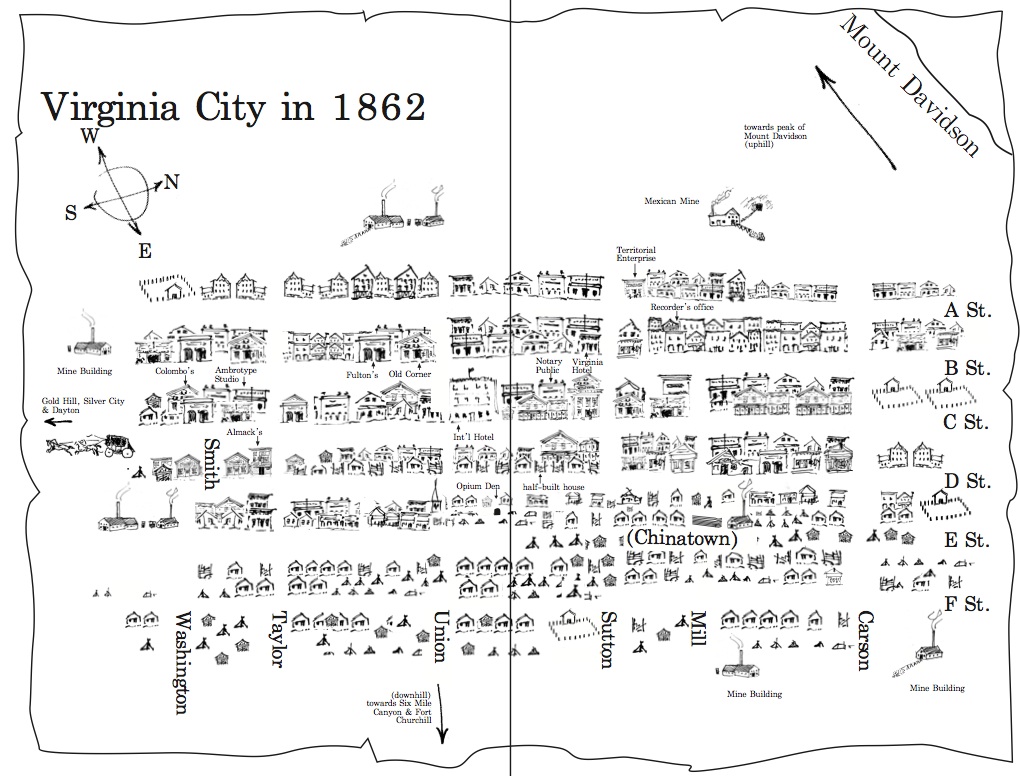 In 1867 Maguire sold this early opera house to John Piper, a bar owner and the town's mayor in 1866. This building was destroyed in the great fire of 1875, the year before Annie Murphy's wedding, but shows continued to be put on at the Odd Fellow's Hall, National Guard Hall, and other facilities around town. A new opera was built at the corner of B and Union street, behind Piper's saloon, but it was not opened until 28 January 1878. Based on the date of her marriage, Annie could not have performed in this new opera house. In the 1880 census of Virginia City, Storey county, Nevada as Henry P. Nelligan, a 29 year old painter. His parents were both from Ireland. Living with him were his wife, Annie, 21, keeping house, and a son, Willie, 1 year old. Henry was born in Pennsylvania, Annie in California and Willie in Nevada. I also have a reference to another family researcher who says "that Henry P Nelligan shows up in the Virginia City Directory [1878-1887 Nevada City Directory] living at 20 Union, as a painter." There were two other Nelligans in town, H. Nelligan, miner C and C shaft [a transcription error for Gold & Curry?], and Thomas Nelligan, miner, res 46 South H. |
| Virginia City & the Comstock Lode
Gold was found at the head of Six-Mile Canyon in 1859 by two miners named Pat McLaughlin and Peter O'Reilly. A fellow miner, Henry Comstock, stumbled upon their find and claimed it was on his property. The gullible McLaughlin and O'Reilly believed him and assured Comstock a place in history when the giant lode was named. Following the gold up the canyon an outcropping of gold in quartz was found. Another miner, James Finney, nicknamed "Old Virginny" from his birthplace, is reported to have named the town during a drunken celebration. He dropped a bottle of whiskey on the ground and christened the newly-founded tent-and-dugout town on the slopes of Mt. Davidson "Old Virginny Town," in honor of himself [this story has all the trappings of a modern myth]. The biggest problem in this grubstake paradise was the sticky blue-gray mud that clung to picks and shovels. When the mud was assayed, it proved to be silver ore worth over $2,000 a ton - in 1859 dollars! Gold mixed with high quality silver ore was recovered in quantities large enough to catch the eye of President Abe Lincoln. He needed the gold and silver to keep the Union solvent during the Civil War. On 31 October 1864 Lincoln made Nevada a state although it did not contain enough people to constitutionally authorize statehood. The resulting boom turned Virginny Town into Virginia City, the most important settlement between Denver and San Francisco; and the grubby prospectors into instant millionaires who built mansions, imported furniture and fashions from Europe and the Orient. Amongst the prospectors and their camp followers who streamed into the new settlement was a young Samuel Clemens, who novel "Roughing It" describes the boom town. At the peak of its glory, Virginia City was a boisterous town with something going on 24 hours a day both above and below ground for its nearly 30,000 residents. There were visiting celebrities, Shakespearean plays, opium dens, newspapers, competing fire companies, fraternal organizations, at least five police precincts, a thriving red-light district, and the first Miner's Union in the U.S. The International Hotel was six stories high and boasted the West's first elevator, called a "rising room.  By the 1890's Virginia City had passed its peak and, as the mines played out, began its rapid descent into history. Today, Virginia City has a population of approximately 500 people. See Virginia City History for more. |
| Piper's Opera House
See Piper's Opera House for more. |
| The Nelligans in Reno, Nevada
By 1884 Henry P. Nelligan was living in Reno, Nevada, just northwest of Virginia City. As the gold and silver played out the latter town started its swift decay. Reno was the big city of Nevada; the capital was at nearby Carson City.
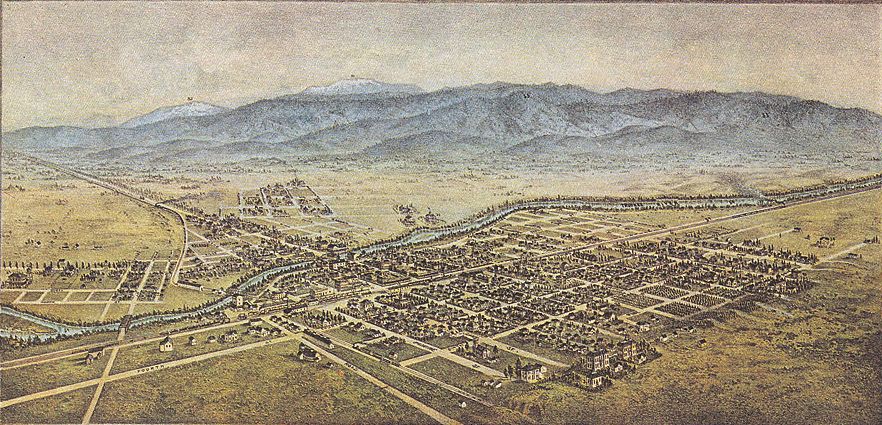 "An Enterprising House.Virignia Street is where the bridge crosses the Truckee river in the center of town, above. Second avenue is just a couple of blocks from the river, on the near side. Annie Murphy Nelligan died in December 1884, in Reno. Her obituary: "Nelligan - Died in Reno, December 16th, Annie, wife of Henry P. Nelligan, aged 25 years 12 months and 15 days; a native of Grass Valley"- from the Weekly Nevada State Journal of 20 December 1884 "Mrs. H. P. Nelligan died yesterday afternoon. Mr. Nelligan has the sympathy of the entire community in his bereavement." - from the Weekly Nevada State Journal 20 December 1884She was, therefore, born in about 1858. There are at least three Grass Valleys in the vicinity; a large community in Nevada county, California, a god forsaken patch of nothing in the middle of Nevada and a valley just below Rose Mountain, in Washoe county, between Reno and Virginia City. The latter is, I think, the right place for Annie's birth. Below is a painting of Grass Valley, California in the era.  Henry and his partner in the paint business broke up in 1886. "Dissolution of Copartnership Henry P. Nelligan, a native of Pennsylvania, aged 33, married Anna S. [Stasia] Malone, a native of California, aged 19, on 14 April 1887 in Camp Independance, Inyo county, California - from the Marriage Register. Both the bride's and groom's parents were natives of Ireland. She was known within the family as "Big Mama." The marriage was noted in the "Territorial Enterprise" newspaper of Virginia City. Anna was born on 16 August 1867, the daughter of James [Haberlin] Malone of Independence. " . . James Haberlin, was a tousled-haired, Irish Navy deserter [sic, an Irishman who deserted from the British Navy], who jumped his ship in New York, changed his name to Malone and joined the U.S. Army. He escorted a wagon train across the plains and arrived at Camp Independence in Owens Valley in the summer of 1864 with a wife and a baby, who later died. After several years of fighting bands of Paiutes, he bought a 160-acre ranch nearby [about two miles from the fort] and settled down to raise cattle, hay and his five daughters. Annie, his eldest daughter, a tall, athletic redhead, was the valley's first schoolteacher. In 1886 she married Henry Parnell Nelligan, a walrus-mustached house-painter from Reno. They moved to Bishop, where Nelligan opened a paint store, bought a six-acre spread on the outskirts of town and, in 1897, built a two-story Victorian home with turned-wood columns and doors which he decorated in his own special way, using his stiff thumbnail to carve chickens and hogs. Nelligan loved the valley. His idyll did not last long. In 1904, in one of the most celebrated swindles in the nation's history, the City of Los Angeles seized the bulk of the valley's water and proceeded to let the land go dry and to drive the ranchers out (see page 25). . . . ranch was being watered through a ditch he had dug from the north fork of Bishop Creek. He had no intention, however, of selling--not even after the city diverted Bishop Creek above his water gate, leaving him a mere trickle. Others also refused to ell; soon a wave of mysterious fires broke out on the ranches of recalcitrant farmers. . ." - from "New West" Volume 2 of 1977, page 23.James was a veteran, a Sergeant in company B, 9th Infantry. The company had originally been camped in the Owens valley in the town of Lone Pine and then been moved north to Camp Independence. In 1869 there were a total of 79 men in the company, including 4 officers. James had enlisted on 29 March 1860 and was discharged on 27 July 1870 - per the Veterans Administration. Orders were given to company B to depart Camp Independence for the Department of the Platte [river] between 1868 and 1869 which probably prompted James' departure from the Army. James' military records show that he was born in New Ross, Ireland. James Malone, born in about 1834, of Ireland, with his wife Priscila, was living in Independence, Inyo county, California in the 1870, 1880 and 1900 census. His children were Anna, Mary, Teresa, Sarah and Ella. Independence was the county seat, though not a town of any size, even today. James Malone died on 17 March 1906, in Independence. |
| Camp Independence
On July 4, 1862, Camp Independence was established to protect the interests of settlers from the Paiute who were engaged in Native American Wars that took place between 1861 and 1865 in various sites throughout the Owens Valley. The camp was named Independence to recognize the founding on America’s Independence Day – and never formally considered a military fort. In the early years of Camp Independence, soldiers lived in nearby caves, deprived of decent shelter. Their living conditions at any time were so poor that many soldiers soon abandoned the fort without clothes, food or payment for several months work. The Army refused to leave the Camp Independence unguarded as conflicts with the Native Americans continued. Volunteer soldiers from Nevada were commissioned to serve at Camp Independence and it remained open until 1877. After the Camp closed, members of the Native American tribes had land allotted to them. Executive Orders in 1915 and 1916 established the camp as an Indian Reservation. These orders provided 360 acres of land at Oak Creek for the Indian tribes to occupy without disturbance. |
|
The following is from an obituary of Anna Stasia's sister, Mary Malone. Note that Mrs. H.P. Nelligan was said to be "of Reno." Does this indicate that Henry didn't move to Bishop until after 1887? "Malone-In Reno, October 31, 1887, Miss Mary E. Malone, a native of Independence, Inyo county, California, aged 18 years, 10 months and 18 days, sister of Mrs. H. P. Nelligan, of Reno. Remains will be taken Thursday to Independence, Inyo county, Cal, for interment. Inyo county papers please copy." - from the Reno Evening Gazette of 1 November 1887 On 29 April 1888 a son was born to Mr. and Mrs. H.P. Nelligan in Reno, per the Nevada State Journal. This was James Haberlin Nelligan. |
| The Nelligans in Inyo county, California
By 1892, at least, Henry was in Inyo county, California. In the California Voter Registration of 1892 for Inyo county, California. "Nelligan, Henry P. - Age: 39 - Hgt: 5 9 - Complexion: dark - Eyes: blue - Hair: black - Scars: __ - Born: Pennsylvania, Lincoln - Naturalized: __ - Residence: Bishop - Registered: Aug. 6 1892"Also in the listing of 1896 as Henry Parnell Nelligan, a painter. There was a Nelligan ranch on West Bishop Lane [where the Clarkson's now reside?]. More importantly, did this citation mix up Bishop and Brockman; Henry's house was on Brockman lane. There is no Bishop lane in Bishop. Below is the Nelligan house in Bishop. 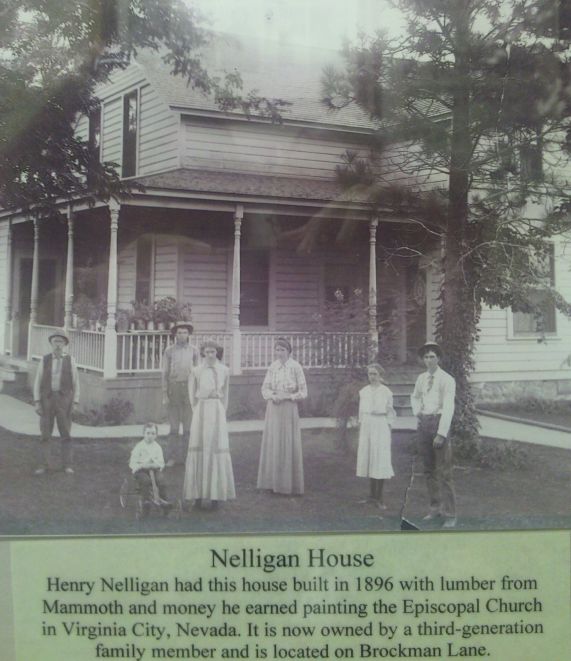 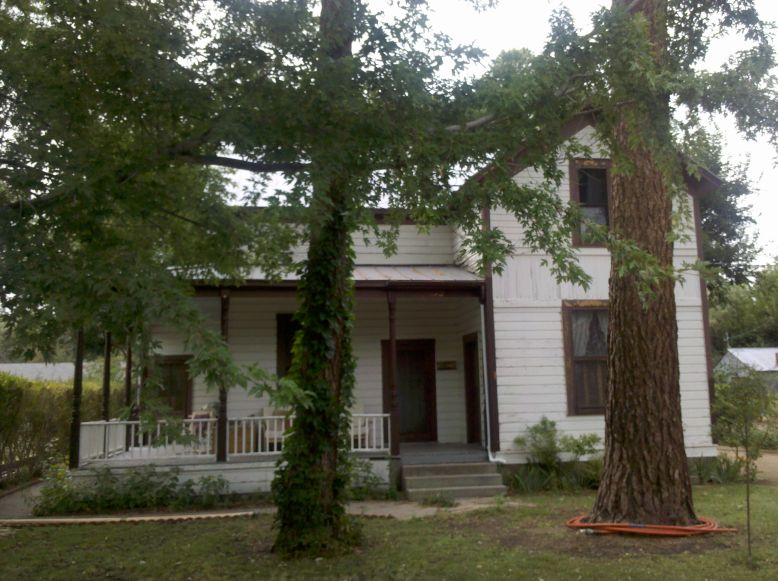
The same house today In the 1900 census of Township 1, Inyo county, California as H.P. Nelligan, a 47 year old painter-house & carriage, born in February 1853, of Pennsylvania. Living with him were his wife Annie, 32, and children, Haber J., 12, Floyd, 9, Annie, 7, Florence, 5, Belle, 3, and William D., a 21 year old painter-house & carriage. Why was William listed last? Below is Henry's store on West Line, off Main Street, in Bishop. 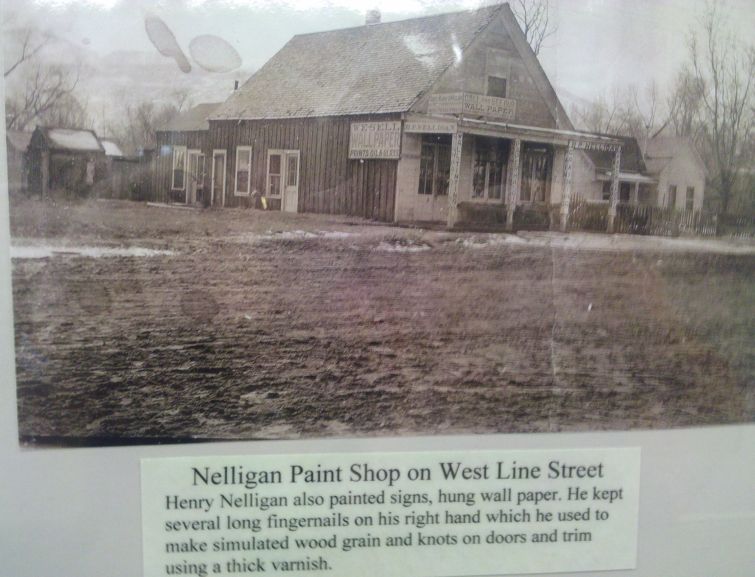 In the 1910 census of Inyo county, California as Henry P. Nelligan, 58 (c1852). Living with him was Annie S. In the 1920 census . . . The H.P. Nelligan company of Bishop, California was noted as carrying the wallpaper books of the Reno Paint company - from the Reno Evening Gazette of 29 March 1920. In the 1930 census of Inyo county, where Bishop is located, but on the Paiute Indian Reservation, as Henry P. Nelligan, 72 (born circa 1858). In his household were Anna S., 62 (born circa 1868), and Nellie B., 15 (born circa 1915). Anna Stacia [Malone] Nelligan died in 1954. The following were buried in the West Line Street cemetery, Bishop, Inyo county, California. Name - Birth - DeathThere is an Anne Nelligan interview recorded by UCLA in 1932 in the Bynum Oral Histories. Henry was buried in the East Line cemetery. 
The children of Henry Nelligan and Annie Murphy were:
"I am the great grandson of James Haberlin Nelligan, who was the son of Henry Parnell Nelligan from his second marriage. His (James H.'s) only son, Marvin Nelligan, is my grandfather who still lives on the family properties in Bishop. His wife, my dear grandmother Rosalie, passed away in 2017. The original James Haberlin, who changed his name to Malone when he jumped ship, is buried near Independence in a cemetery that is rather difficult to find under the marker James Malone, next to him is one of his daughters. James Haberlin Nelligan is buried in the Pioneer Cemetery [West Line].Marvin W. Nelligan was born in 1929. His wife was Rosalie Mae Schubr. They had a son James and grandson James H. Could Marvin be the infamous asthmatic 'Cousin Marvin' of Lloyd Montague's cathouse story? (24) Floyd Henry Nelligan (1890), b. 14Jun1890, d. 15Mar1965. He married Carrie. Buried in West Line Street cemetery. (24) Carolyn Nelligan (1891), b. 16Apr1891, d. 30Jun1969. Buried in West Line Street cemetery. (24) Anne Julia Nelligan (1892), b. 1Aug1892, d. 6Feb1917. Buried in East Line Street cemetery. (24) Florence Jessie Nelligan (1894) (24) Our Baby Nelligan (1896), b. 22Apr1896, d. 26Apr1896. Buried in East Line Street cemetery. (24) Belle Vernon Nelligan (1897). Belle Nelligan Holland, known as Big Belle, the wife of Harry Holland. (24) Chester Arthur Nelligan (1898), b. 2Oct1898, d. 26Apr1900. Buried in East Line Street cemetery. (24) Duane Chesley Nelligan (1903), b. 23Nov1903, d. 03Aug1980. U.S. Army veteran. Buried in East Line Street cemetery. (24) Charley D. Nelligan (c1905) (24) Nellie Bly Nelligan (c1915) (24) William Daniel Nelligan (1878) He was born on 13 October 1878 in Virginia City, Nevada. Both a William and Rosali Nelligan provided information about the inhabitants of the West Line Cemetery in Bishop. A W.D. Nelligan was the president of the Tonopah-Aloha Mining company, with claims in the Lone Mountain area, which was organized in 1903 - from "The Copper Handbook" Volume 6, by Horace Jared Stevens and Walter Harvey Weed. Note that his sister, Gertrude, married in Tonopah in 1903. Had Gertrude accompanied William to, perhaps, keep house for him? A Pennsylvania newspaper of the same year note that "A camp that is rapidly coming to the front is the Nelligan-Brockman camp at Granite Springs on the eastern slope of Lone Mountain and about 12 miles from Tonopah." In 1905 W.D. Nelligan sold a one-third interest in 10t.5 block F on St. Patrick St. and Bryan Ave., in Tonopah - from Nye County Records Office. In 1905 William married Emma Adaline, the daugther of Pleasant Arthur Chalfont and Adaline Slater. The Chalfont's were an important family in Inyo county. Her father published the Bishop newspaper, the Inyo Independent. In the 1910 census of Esmeralda county, Nevada as William D. Nelligan, 31. Living with him was Emma, 32, and Maurice, a newborn. This was another mining community. As early as 1912, and as late as 1915, William and Emma Adaline were living in Yerington, Lyon county, Nevada. In the 1920 census of Inyo county, California as William D. Nelligan, 41. Living with him was Emma, 41. Their children were probably Marjorie, 11, Maurice, 10, and Robert, 6. In the 1930 census of [Reno?] Washoe county, Nevada as William D. Nelligan, 51. Living with him was Emma C., 52, and Maurice W., 20, and Robert C., 16. (24) Gertrude Margaret Nelligan (1880)She was born in Virginia City, Storey county, Nevada, on 23 July 1880. In the 1900 census . . . She married Albert Lloyd Wells on 17 December 1903 in Tonopah, Nevada. |
After marrying Albert and Gertrude moved to Bishop, California where Gertrude's parents lived.
| Bishop, California
Bishop was named after Samuel A. Bishop on August 22nd, 1861. Bishop, his wife, three white men and several herders, driving 500 to 600 head of cattle and 50 horses, arrived in Owen's Valley and established camp. The Paiute Indians called Owens Lake by the name of "Pacheta" and the Owens River "Wakopee." Inyo County is also an Indian name meaning "dwelling place of the great spirit." Cattlemen and sheepherders first used the valley as a grazing area while passing on to other destinations. By 1912 such diverse crops as celery, potatoes, alfalfa, wheat and corn were being grown. Orchards produced apples, figs, almonds, walnuts, peaches, pears, plums and berries - even grapes flourished in the temperate climate of Bishop. In 1883 the Carson & Colorado narrow gauge railroad was built. You can relive some of the railroad history at Laws. The original narrow gauge engine, the "Slim Princess" is on view plus a museum and old town. Between the years of 1892 and 1904 California experienced a 12 year drought. Over a period of time most of the land of the Owens Valley was purchased by Los Angeles; and in November of 1913 the now famous Los Angeles Aquaducut was completed, 223 miles long and using no pumping stations just gravity siphons sending water to Southern California. |
In the 1910 census of Bishop (township 1), Inyo county, California Albert L. was a 34 year old with no occupation listed, born in Illinois. Living with him were his wife, Gertrude M., 29, of Nevada, Lloyd H., 5, Clara A., 2, and C. Marvyn, 1. The family, minus Marvyn, is pictured below.
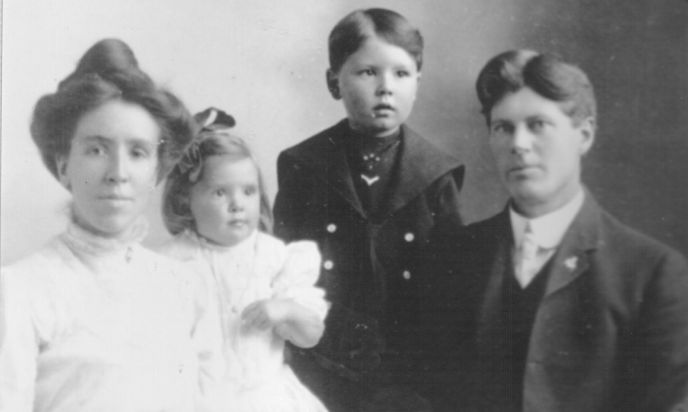
Albert Lloyd Wells, 42, of Bishop, Inyo county, California, registered for the draft on 12 September 1918. He was listed as a clerk in a hardware store, working for Lever and Watterson, of Bishop. His next of kin was his wife, Gertrude. He was of medium height and build, with blue eyes and brown hair. George Watterson was noted as owning the hardware store in Bishop circa 1920.
In the 1920 census of Township 1, Inyo county, California as Albert L. Wells, 44, of Illinois, a clerk in a hardware store. Living with him were his wife, Gertrude, 39, of Nevada, and children, Lloyd A., 15, Clara, 12, Marvin, 10, and Janette, 8, all of California.
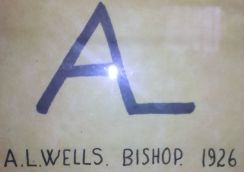 Since Albert was known to have owned a hardware store in Bishop, I assume he bought out Watterson at some point after 1920. Albert also had a ranch in Bishop with the distinctive brand, to the right.
Since Albert was known to have owned a hardware store in Bishop, I assume he bought out Watterson at some point after 1920. Albert also had a ranch in Bishop with the distinctive brand, to the right.
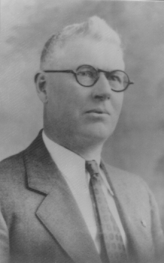 In the 1930 census of Riverside, California as Albert L. Wells, 54. Living with him was his wife, Gertrude M., 49, Lloyd H., 26, a salesman at a hardware store, Marvin C., 20, a clerk at a bank, and Jeanettte, 18. Clara had married in 1927 and moved out. The value of Albert's real property was $3,500 and he owned his own home. His occupation was listed as none. His father's place of birth New York, mother's as Illinois.
In the 1930 census of Riverside, California as Albert L. Wells, 54. Living with him was his wife, Gertrude M., 49, Lloyd H., 26, a salesman at a hardware store, Marvin C., 20, a clerk at a bank, and Jeanettte, 18. Clara had married in 1927 and moved out. The value of Albert's real property was $3,500 and he owned his own home. His occupation was listed as none. His father's place of birth New York, mother's as Illinois.
At some point Albert had a local dairy farm from which he retired to Arlington, California in the early 1930s. Arlington is just southwest of Riverside.
Inn the 1940 census of Riverside, California as A. L. Wells, 64, of Illinois. Living with him was his wife, Gertrude M., 59, of Nevada. They lived at 9695 Magnolia avenue. They had lived at the same address in 1935. This is now a funeral home and may be the actual house they lived in.
Albert Lloyd Wells died on 12 July 1941 in Riverside, California. He was buried at the Olivewood cemetery in Riverside. Gertrude died on 23 June 1943, also in Riverside.
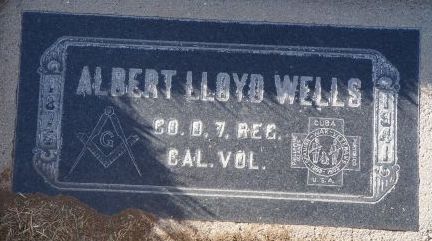
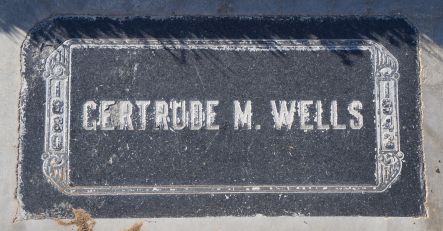
Albert's children were,
(25) Lloyd Henry Wells (1904)
(25) Clara Ann Wells (1907)
(25) Marvin Chester Wells (1909)
(25) Jeannette Gertrude Wells (1911)
| The Hollands and the Owen's Valley Water Wars
The Holland's were an Owen's Valley family related to the Nelligan's and Wells via marriage. Pg 21:"Harry Holland lasted a little longer than the others, but on the night of July 14, 1932, he, too, gave up and sold his stucco house on East Line Street in Bishop to the City of Los Angeles. He figured that, with everybody leaving town, and with his theater taking in a bare $10 a night, the money he could get for the house would allow him to pack up his family and move away. Besides, there was no point in waiting for a better offer. For more than two decades L.A. had been acquiring nearly every square foot in the valley. Some clown had actually posted a "Los Angeles City Limits" sign at the north end of town. Thirteen-year-old Vernon, eldest of the six Holland children, was only . . . Pg. 22:". . . Looking across the arid landscape, Holland said, 'It was green all the time, and all the ducks and geese would blacken the sky' . . ." Happy days: The family posed outside its new home in 1900. The grandfather had come to the Owens . . .. . . vaguely aware of what was happening. All he knew was that the family was sitting around the heavy oak kitchen table, and they were all crying. Across the table, his mother was staring at a gilt-framed, ivory-toned photograph of her grandfather, who had come to the valley 70 years earlier to fight Indians. "What a waste," she said to nobody in particular. "You bleed and sweat to build something in this wilderness, and as soon as you succeed some bully takes it away from you." Vernon wondered if the sale of the house included his room- an old miner's shack his father had hauled in from the hills and set up in the back yard next to the horse pasture. Vernon and his brother Jim had it all to themselves, an out [sic] looking up. Vernon felt as if he had been kicked in the stomach. A few weeks later, Will Rogers drove up to the valley to shoot a film and filed the following newspaper dispatch: "Bishop, Calif., Aug. 25- Ten years ago this was a wonderful valley with one quarter of a million acres of fruit and alfalfa. But Los Angeles needed more water for the Chamber of Commerce to drink more toasts to its growth, more water to dilute its orange juice, more water for its geraniums to delight the tourists, while the giant cottonwoods here died. So, now, this is a valley of desolation. "I shall never forget that night as long as I live," shouted Vernon Holland, now a rugged, ruddy-faced 57, as he gunned Road [sic]. We jumped over a barbed wire fence into the chest-high dusty rabbit brush and spent the rest of the afternoon roaming through the remnants of a vanished civilization- crumbled water gates, broken-down house foundations, fallen canal bridges, weathered corral posts. As the sun sank behind the Sierra peaks, Holland dug up a rusty old cast-iron school desk. "My grandmother was such a great lady, the first white baby born in Camp Independence. She used to teach in the school that once stood here," he said softly. "I have been following the dispute between the DWP and the valley since 1972 . . ." - pg. 22 ". . . such a show, quit and opened the Gem Theater. He subsequently built the Bishop Opera House. In 1918 Harry Holland married Nelligan's daughter, Belle. Their son Vernon ["Tex"] was born a year later." "The battle between the city and the ranchers climaxed in the following decade. The ranchers fought back by bombing the city aqueduct and by appealing to Sacramento and Washington, but to no avail. During one legislative hearing, a DWP representative stormed out shouting that the city would invade any part of California if it needed the water. And it did. By 1930 the city owned 95 percent of the valley farmlands and 85 percent of . . ." Pg. 24:". . . Harry Holland died in 1950; his wife Belle died last year. Now the town of Bishop is building a park named after them. Five of their six children still live in the valley- and they are doing quite . . ." - from the "New West" Volume 2 |
He was born on 11 November 1904 in Bishop. In the 1910 and 1920 Federal census of Bishop (township 1), Inyo county, California as Lloyd H., 5 years old & 15 years old respectively, born in California and living with his folks. In the 1930 census he was 26 years old and still living with his father, then in Riverside, California. He was at the time a salesman in a hardware store, much like his father had been earlier.
He married Helen Isabel MacQuarrie on 25 December 1937 in Yuma, Arizona. She had been born on 23 August 1906 in Riverside, California. He was big, good natured man who very active as a Boy Scout leader. He was also a fine banjo player. He died on 21 July 1971 in San Bernardino county, California at the Loma Linda Hospital. Helen died on 4 March 1994 in Monterey, California. Their children were Janet Isabel and Helen Gertrude.
(26) Janet Isabel Wells (1939)His name was at times spelled Marvyn and sometimes rendered Chester Marvin, but he was known as Bud. He was born on 10 April 1909 in Bishop. In the 1910 and 1920 Federal census of Bishop (township 1), Inyo county, California as Marvin, 1 and 10 years old respectively, born in California and living with his folks. In the 1930 census he was 20 years old and still living at home with his father, in Riverside. He was already a clerk in a bank. In later years he had a dynamic life as a bank manager, rancher and accomplished aviator. He was president of the Security Bank of Blythe at one time.
He married Ardeen Phyllis Rees on 4 August 1933 in San Bernardino. She was born on 30 March 1912 in Oregon. She died on 16 May 1994 in Sonoma county, California. They had a son, Albert Lloyd Wells.
A biographhy of Bud, made in about 1954.
"Marvyn C. WellsComing to Blythe in 1935 just as the dark days of the depression were ending, and and after a period of four years of no banking facilities in the town, M. C. Wells, with his wife and clerk, established the branch of the Citizens National Trust & Savings Bank of Riverside here. Beginning with this personnel of three, and with assets of only $300,000 the first year, he has been largely instrumental in the growth of the branch to the point where it is now one of the largest in the banking system. The Blythe branch is now the third largest branch of the bank, exceeded only by Riversidde and San Bernardino. The growth of the Palo Verde Valley and the growth of the bank have been synonymous. From the original position of assistant cashier and manager, Mr. Wells is now vice-president and manager of the institution.
It is interesting to note that Mr. Wells was only twenty-six years of age when selected to open the bank in Blythe, and he was at that poinnt the youngest branch manager in the county.
A native son, Mr. Wells was born in Bishop, California, on April 10, 1909, the son of Albert Lloyd and Gertrude (Nelligan) Wells, both of whom are deceased. Mr. Wells graduated from Bishop High School and soon thereafter came to Riverside. He started with the Citizens Bank on December 27, 1927, at the Arlington branch. While working there, he took several banking courses at the Riverside Junior College, given under the auspices of the American Institute of Banking. In addition to completely managing the bank, Mr. Wells has been very active in community affairs. For several years he was treasurer of the Chamber of Commerce, and has served on the boards of most of the community organizations. He is a charter member of the Rotary Club and also belongs to the Lions Club being a former director of the latter. A Mason, he is a Past Master of the Blythe Lodge and honorary life member of The De Molay Legion of Honor.
Mr. Wells has been interested in farming all of his life and has 160 acres in the Palo Verde Valley, where he grows alfalfa, and on which he also runs cattle. In addition to his farming interests, he also owns business property in this area.
Mrs. Wells was formerly Miss Ardean Rees, and was born in Salem, Oregon. She is a graduate of Riverside High School and Riverside Junior College. She was employed by the Riverside High School for several years, and was with the bank for three years. Mr. and Mrs. Wells have a son, Albert Lloyd, who was born in Blythe in 1948 and attends the local high school.
During World War II, Mr. Wells was a civilian flying instructor at the Morton Air Academy in Blythe at the same time he managed the bank and farmed. He has had over 6,000 hours of flying. In addition to flying, other hobbies are golf, hunting, and fishing." - from the "Riverside Community Book" of 1954
Bud died on 15 September 2009 in Santa Rosa, Sonoma county, California - he almost made it to 100. He was buried in Riverside.
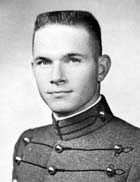 (26) Albert Lloyd Wells (1938)
(26) Albert Lloyd Wells (1938)Albert graduated from West Point in 1961. I have an Albert L. Wells in the Santa Maria and Lompoc Areas, California City Directory of 1963, living in Santa Maria.
"Albert L. Wells
"Al"
Company E-1
25 Sep 1938 - 12 Jun 2007
Place of Death: Novato, CA
Interment: Palo Verde Cemetery
Blythe, CA"
It is with great regret and sorrow that we must inform you of the death of our Classmate, Albert Lloyd Wells, Company E-1, on June 12, 2007 at his home in Novato, CA. Al is survived by his wife, Joan, and their children Mark and Allison and several grandchildren. Al is also survived by his father.
A Memorial Service was held on June 24, 2007 at 2 PM in the Keaton's Redwood Chapel of Marin, 1801 Novato Boulevard, Novato, CA 94947.
There will be a graveside service and burial in Blythe, CA, where Al and Joan grew up. The Graveside Service will be held on Wednesday, June 27th at 9:00 a.m. at the Palo Verde Cemetery, 10700 10th Avenue, Blythe, CA (760) 922-4631. There will an opportunity to visit with Joan at the family home in Blythe after the service."
The following is a tribute by Al's son.
"Albert Lloyd Wells' journey in life began in Blythe, CA, on 25 Sep 1938, continued through West Point, brightened by his marriage to Joan soon after graduation, blessed by the births of their daughter Allyson and son Mark, continued through an exciting and rewarding career in the Infantry and Army reserve, culminating in his promotion to colonel, followed by a challenging but rewarding series of civilian endeavors, further blessed by the addition of grandchildren to spoil, and ended all too abruptly at home in Novato, CA on 12 Jun 2007.Joan L. Wells was born on 1 January 1940. (27) Mark Albert Wells (1965)
During his youth in Blythe, Al was an active participant in all aspects of school and civic activities, he was quarterback of his high school football team, student body president, achieved high marks in academics, and made many contributions to civic endeavors. Most importantly, he began his lifelong relationship with Joan, his wife-to-be. The high ideals, professional attributes, and associated hard work ethics he developed there continued and improved throughout his lifetime, just as did his love and devotion to Joan. Al and Joan's love affair was special. Al first proposed to Joan when he was fifteen years old and loved her until his final breath. His last journal entry, literally days before his passing, reads:
"It is seemingly impossible that my wife becomes more precious every day. My love for her has never been so strong! I tell her, but I hope she really understands what she has become to mean to me."
My father was so proud to be a West Pointer. I think he had a solid character before his entrance into West Point, but surely he was forged there into the most ethical man I have ever known. My father's sense of honor, dedication, commitment and integrity has been a tremendous example to all that have known him. Life is full of situations that may appear gray, but my father saw things more in black and white and in terms of what was right and wrong. He was an example of doing the right thing, regardless of whether or not it was the easy path.
My father was an only child. His close friends became his brothers, and he loved them as such. My dad deeply cared for his family. He was not only a husband, son, father and grandfather, but a sounding board, mentor, provider and, most of all, our biggest advocate. My Dad always told us how much he loved us. All that my Dad ever wanted for us was "everything".
As a member of the Class of 1961, Al was fortunate to be part of the era when, for the most part, cadets remained in the same company for all four years. As a stalwart champion of the philosophy that E-1 was the only fraternity at West Point, he was a key participant in the unsanctioned activities of Epsilon Uno. Al was not known for his academic achievements, but he was well-known for wearing his well-decorated B-robe even after graduation.
Their first assignment was at Ft. Benning, GA. During the time it took to complete the basic infantry officers' course and Airborne and Ranger training, Al and Joan established relationships with other couples that have continued through the years. The first real tour with the troops was with the 25th Infantry Division at Schofield Barracks, HI. Al distinguished himself during his tour with the 25th and three tours in Viet Nam.
He left active duty in 1971, began a career in real estate, continued to serve his country in the Army Reserve, and was very active in politics. Al was successful in his work, but now he could take more time to enjoy his family. He was enthusiastic in the performance of his Army Reserve duties, wearing his uniform proudly and at every opportunity. He was a thoughtful patriot and a dedicated American. He had little tolerance for those who couch criticism of our country in terms of "freedom of speech" when the underlying goodness of America was not clear to them. He was proud to be an American and a soldier and was convinced that those roles provided value in one's life.
At the same time, he and Joan began to more actively participate in activities at the country club near their home. Ever an athlete, Al was an enthusiastic golfer and tennis player. He was jocular, always able to find something humorous in a situation, and never turned down an opportunity to meet with friends and acquaintances to enjoy a glass of wine and exchange perspectives/war stories. He was always thoughtful of others, taking time and making the extra effort to ensure that friends and widows were included in activities and provided assistance in their times of need.
Al was a loyal friend and confidant to all who knew and loved him. From our West Point days in E-1, through action-packed work and fun-filled times in Hawaii, through the challenges of Viet Nam and other assignments, through the varied paths we took in returning to civilian life, we shared common values, goals, and were blessed with loving families and friends. It would be very difficult to find anyone among us who loved his family and country more, who valued the association with, and love for, his West Point classmates more than Al Wells. Great memories, Al; you are truly missed! Let's Roll!!!!"
- Written by his son Mark A. Wells and AT's classmates
Of Grass Valley, California. He was born on 25 June 1965.
(27) Allyson Lei WellsMarried a Hernblom.
(25) Jeannette Gertrude Wells (1911)She was born on 2 December 1911 in Bishop. In the 1920 Federal census of township 1, Inyo county, California as Jeannette, 8, born in California. The 1930 Federal census as Jeannette, 18, living with her parents, then in Riverside, California. She was a registered nurse and served in Europe during World War II as an army nurse. She married Vernon Lloyd Randau. He was born on 14 February 1904 in Iowa. The couple lived in Fresno, California. My father-in-law has said he was very close to her. She was a good friend and had a magnificent sense of humor. Her husband, Vernon, died on 16 September 1980. She died on 31 August 1988 in Fresno.
 (25) Clara Ann Wells (1907)
(25) Clara Ann Wells (1907)Anita's Grandmother. She was born in Bishop, California on 22 June 1907 and lived there for the greatest part of her life, growing up on the family dairy. In the 1920 census of township 1, Inyo county, California as Clara A., born in California.
She married Lee Roy Montague on 28 March 1927 in San Bernardino. She was a very accomplished horsewoman in her youth and enjoyed music. She played the coronet in high school and the piano well into her 70's [Anita inherited her piano]. She served as a member of the Bishop Union School Board and worked in a variety of local jobs. Her last position was as a service advisor for the Interstate Telephone Company covering the eastern Sierra and western Nevada area.
She divorced Lee in the 1950's and subsequently married Robert A. Dinsmore on 19 July 1959. He was a marketing executive with Continental Telephone Company. They retired in Bishop. Late in life they moved down to San Diego county, living in a nursing home in Escondido, just north of her son, Lloyd, and grand-daughter, Anita. Clare died on 31 December 1999.
Below, Clare is in a characteristic western poise.
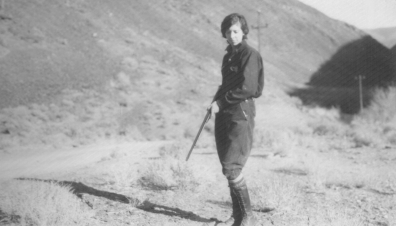
Here's a photograph of a Wells reunion. Clara is in the front row, sitting in the chair. The note is from Emily Lopeman, a cousin.

| The Dinsmore Family
The family claims a Scottish descent. (18) Robert Dinsmure (c1676)(19) Thomas Dinsmore (1706) He was possibly the Thomas Dinsmure, the son of Robert Dinsmure, born on 2 June3 1706 in Beith, Ayrshire, Scotland. (20) Abel Dinsmore (1736)(19) Thomas Dinsmore (1706) Abel Dinsmore, the son of Thomas and Hannah Dinsmore, was born on 27 December 1736 in Bedford township, Hillsborough county, New Hampshire. Abel Dinsmore married Esther Sanderson on 14 December 1756 in Hatfield, Hampshire county, Massachusetts. He died in 1803 in Conway, Franklin county, Massachusetts. (21) John Dinsmore (1774)(19) Thomas Dinsmore (1706) (20) Abel Dinsmore (1736) John Dinsmore, the son of Abel and Esther Dinsmore, was born on 12 September 1774 in Conway, Franklin county, Massachusetts. He married Mary Gates. (22) Rufus Dinsmore (1804)(19) Thomas Dinsmore (1706) (20) Abel Dinsmore (1736) (21) John Dinsmore (1774) Rufus Dinsmore, the son of John Dinsmore and Mary Gates, was born on 10 June 1804 in Massachusetts. Rufus had first married Louisa Stebbins of Conway, Franklin county, Massachusetts. Next, Rufus Dinsmore, 36, married Arsinoe Foot on 24 February 1842 in Ionia county, Michigan. She was born in 1819 in New York. Rufus died in 1848 and was buried in the Oak Hill cemetery in Ionia, Michigan. (23) Andrew Foote Dinsmore (1843)(19) Thomas Dinsmore (1706) (20) Abel Dinsmore (1736) (21) John Dinsmore (22) Rufus Dinsmore (1804) Andrew, the son of Rufus Dinsmore and Arsinoe Foot, was born on 13 May 1843 in Ionia township, Ionia county, Michigan. After his father died Andrew's mother, Arsinoe, married Amos Monroe. As a young man Andrew learned the trade of a printer. Andrew enlisted on 13 May 1861 as a Private in Company E of the Third Regiment of Michigan Infantry. He was wounded at the battle of Fair Oaks, Virginia on 31 May 1862 by a musket ball which fractured the upper third of the left femur and lodged. He was 19 years old. On 11 July 1863 he enlisted in the Second Battalion, Veteran Reserve Corps for three years. Andrew served in the 25th Company and in the 137th Company of the 2nd Battalion as well as in the 3rd Independent Company of the VRC. He was discharged as a Corporal on July 21, 1866, at Indianapolis After the war he was employed as a clerk in the General Land Office. He became Chief of the Drafting Division in 1889 - from the Detroit Free Press of 4 August 1889. By the following year he was listed as chief of the Topography Division. "A. F. Dinsmore, is chief of division of the general land office, is a printer by trade and is widely known in Grand Army circles. He is a native of Michigan and is a . . ." - from the "Evening Star" of Washington, D.C. of 17 February 1892My father-in-law, Lloyd Montague, inherited an antique map from Robert A. Dinsmore, Andrew's grandson; Robert was the second husband of Lloyd's mother, Clara Wells Montague. This map, dated 1846, was of the New Map of Texas, Oregon and California on the verge of the Mexican-American war. We are taking this to the Antiques Roadshow! 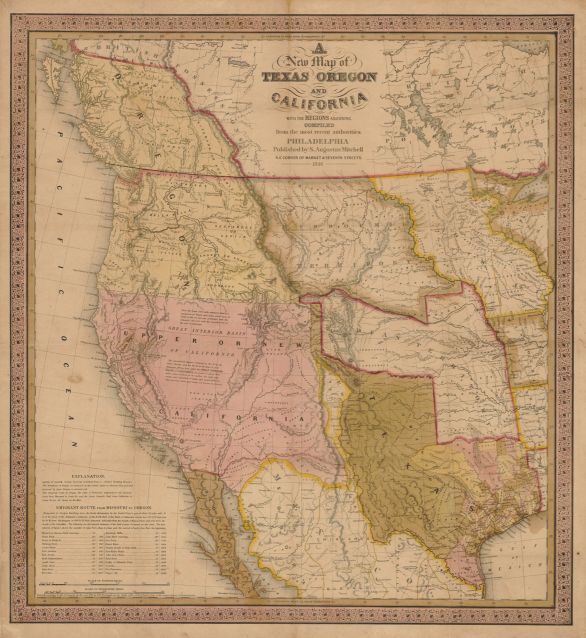 Commander of the Department of Potomac in the Grand Army of the Republic, a service organization for Civil War veterans. He married Imogene Selden [Sheldon]. Imogene died in 1887 of a brain damage received by a blow to the hea. Andrew was later shown married to a Mary H. Dinsmore, who had been his nurse when he recovered from his war wounds. Andrew died on 7 June 1925 while residing at 1401 Girard NW, Washington, D.C. (24) Robert Rufus Dinsmore (1884)(19) Thomas Dinsmore (1706) (20) Abel Dinsmore (1736) (21) John Dinsmore (22) Rufus Dinsmore (1804) (23) Andrew F. Dinsmore (1843) Robert, unnamed in the record of his birth, the son of Andrew F. Dinsmore and Imogene Selden, was born on 6 April 1884 in Washington, D.C. Robert R. Dinsmore, 21, the son of Andrew F. Dinsmore and Imogen Selden, married Grace Troutman, 18, the daughter of Edward Troutman, in Stark county, Ohio on 7 September 1905. (25) Robert A. Dinsmore (1907)(19) Thomas Dinsmore (1706) (20) Abel Dinsmore (1736) (21) John Dinsmore (22) Rufus Dinsmore (1804) (23) Andrew F. Dinsmore (1843) (24) Robert R. Dinsmore (1884) Robert, the son of Robert Dinsmore and Grace Troutman, was born on 26 October 1907 in Alliance, Stark county, Ohio. He died on 29 November 1995 in Escondido, California at the age of 88. He was buried in the East Line cemetery in Bishop, Calfornia. He was a Mason. |
He married Virginia.
(26) Margaret Kay Montague (1931)She married Sherm Triscuit.
(24) Laura Althea Wells (1877)She was was born on 12 September 1877 in Illinois and was two years old at the time of the 1880 census of Odell, Illinois. She married Frederick Noble. He was born on 14 September 1877.
In the 1900 census of Hueneme, Ventura county, California as Frederick B. and Laura Noble.
In the 1910 census of Rocky Ford, Otero, Colarado as Frederick and Laura Noble.
In the 1920 census of . . .
In the 1930 census of Oxnard, California as Frederick and Laura A. Noble. Their daughters were Clara Grace, 27, and Emily Lorraine, 25, who died unmarried. Laura's little brother, Merrill, was living with them. She died on 7 July 1958 in Ventura, California. Fred bequethed a large amount of money to the University of Southern California.
| Frederick Noble
|
He was 11 months old, the son of Lloyd Sylvester, at the time of the 1880 census of Odell, Illinois. Another reference shows a Wesley Louis Wells born on 19 August 1879 in Odell, Livingston county, Illinois. I haven't been able to find anything more about him and I assume he died young.
(24) Augusta Wells (1881) 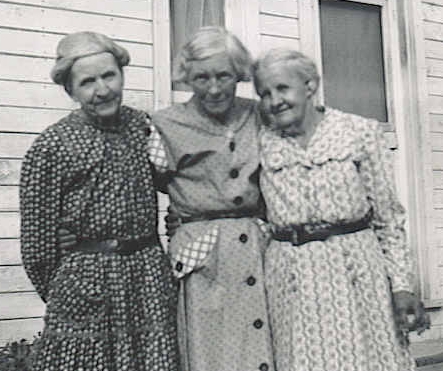 A previously unknown daughter. The information that follows comes from a descendent, Phyllis Dickerson. Agusta "Gussie" Wells was born on 11 August 1881 in Illinois. She married John Samuel Taylor. He was born on 16 March 1871 in California. She married at the age of 19. They were living with her Father-in-law in 1900. This is probally the reason she is not found in census.
A previously unknown daughter. The information that follows comes from a descendent, Phyllis Dickerson. Agusta "Gussie" Wells was born on 11 August 1881 in Illinois. She married John Samuel Taylor. He was born on 16 March 1871 in California. She married at the age of 19. They were living with her Father-in-law in 1900. This is probally the reason she is not found in census.
They only had one child, John Vernon Taylor, who was born on 19 July 19??, in Riverside county, California. John married Georgia McPeak who was born on 4 April 1904 in Floydada, Texas. She was married before to Loyd Elmer Dodd.
John Samuel Taylor died on 15 June 1948. He was buried in Corona, California. Phyllis She died on 26 June 1961 and was buried in Corona, California. Their son died on 6 February 1965 in Utah. He was bBuried in Hillside Cemetery. Redlands, California.
At left is Gussie, center, with two of her sisters. They have not been positively identified,but I would guess the older sister, Laura, was on the left. The family resemblence to my father-in-law is remarkable. At risk of being irreverent, Gussie looks like Lloyd Montague in drag.
(24) Jesse W. Wells (1883)He was born on 1 September 1883 in South Dakota. At the time of the 1910 census he was a book-keeper in a bank, living at home with his father in Riverside, California. Note that his brothers, Albert and George, had moved to Bishop by this time.
He married Corena M. Kimbley. She was born on 17 May 1885 in Indiana. In the 1920 census he was still living in Riverside, California, a 36 year old cashier at a bank. Living with him were his wife, Corena M., 34, and children, Florence, 4 11/12, and John W., 2 11/12, both born in California.
In the 1930 census of Riverside, California Jesse W. Wells was a 46 year old baker working in a bakery shop. He owned his own home on 9342 Magnolia avenue, next door to his younger brother, George L., below. Living with him were his wife, Corena M., 44, of Indiana, and children, Florence C., 15, John W., 13, Eleanor R., 8, and Majorie L., 6, all born in California.
Jesse died on 20 October 1968 while still living in Riverside. Corena died on 19 December 1973 in Riverside.
(25) Florence C. Wells (1915)She was born on 12 January 1915 in California. I belive she married Grant Austin Newlin. He was born on 5 December 1915 in Iowa (though he lived in Nebraska for a time). She died on 8 February 1953 in Riverside, California. Grant survived her by a number of years, dying on 23 August 1997 in Calimesa, Riverside county, California.
(25) John Warren Wells (1917)He was born on 14 January 1917 in California. He died on 31 July 1986 in Los Angeles, California.
(25) Eleanor R. Wells (1922)She was born in California.
(25) Marjorie L. Wells (1924)She was born in California.
(24) George Lucian Wells (1885)The sixth child and fourth son of Lloyd and Clarissa. He was born on 30 September 1885. I'm not certain he was Lloyd's son, though his grand-daughter, Emily Symons Jorge in California, believes so. He was living next door to Jesse W. Wells in the 1930 census, he was born in South Dakota, and he would be the 10th of 10 known children of Lloyd and Clara.
He married Maybelle Cleora Smith. She was born on 8 August 1889 in Idaho. In the 1910 census of Bishop (1st township), Inyo county, California George L. Wells wa a 24 year old clerk in a hardware store. He was listed as born in South Dakota, and his parents were from Illinois [perhaps he remembered where he father came from rather than where he was born]. Living with him was his wife, Mable C., 20, of Idaho. Note that Albert Lloyd Wells was also living in Inyo county at this time.
In the 1920 census of Bishop, Inyo county, California George was a 34 year old retail merchant in the grocery business. In this census he placed his father as born in New York and his mother in Illinois. Living with him were his wife, Maybelle C., 30, and Mildred, 6 11/12, and Georgia, 2 1/12.
In the 1930 census of Riverside, California George L. Wells was a 47 year old [1883] salesman in a hardware store. He owned his own home on 9262 Magnolia avenue. Living with him were his wife, Mable C., 40, of Idaho, and daughters Mildred E., 17, and Georgia D., 13, both born in California. His elder brother, Jesse W., lived next door.
George died on 13 March 1979 in Riverside, California. Maybelle died on 28 November 1989 In Inyo county.
(25) Mildred E. Wells (1913)She was born on 14 September 1913 in California. She died on 29 April 2000 in Bakersfield, Kern county, California.
(25) Georgia D. Wells (1917)She was born in California.
(24) Bessie Wells (1889)She was born on 20 July 1889 in Hartland, Kingsbury county, South Dakota and died the same day.
| Kingsbury County
The weather in South Dakota can be cruel. Blizzards and large accumulations of snow limit the growing season. |
He was born on 26 September 1890 in Hartland, Kingsbury county, South Dakota. He would have gone to Pomona, California with his father shortly after his birth. However, on 5 June 1917 he was living in what appears to have been a boarding house in Rocky Ford, Otero county, Colorado, where he registered for the the draft. He was 26 years old and described as a tall, slender man with blue eyes and light brown hair. He was working as a sugar [garbled] for The American Beet Sugar company.
| Rocky Ford, Colorado
Rocky Ford, named for a rock-strewn river crossing discovered by famed scout Kit Carson, is alocated in Otero county, on the eastern plains of Colorado in the Arkansas river valley, about 50 east of Pueblo. It is an agricultural area today known for its cantaloupe and watermelons which ship nationwide. The Atchison, Topeka, and Santa Fe Railway Company built its tracks through Rocky Ford in 1875-76. One of the biggest developments in the life of Rocky Ford was the American Sugar Beet Company. The company set up shop in 1900 and started converting local farmers' sugar beets into sugar, then shipping the end product by rail throughout the country. Much in Rocky Ford revolved around the plant, later renamed the American Crystal Sugar Co., with the big brick buildings, smokestacks and silos towering over the low-slung farm town. The plant guaranteed a market for Arkansas Valley sugar beet farmers and a paycheck for workers, who happily spent their wages at local stores and bars. In 1979 the company announced it was closing its doors as a result of competition from cane sugar grown in Hawaii and the Caribbean, which, for a time, devastated the town. |
Merrill served in World War I as a Private in the Quarter Masters Corps [this is Army-talk for the Supply Corps]. The QMC was responsible for supplying clothing; individual, camp and garrison equipment; general supplies; transportation; camp and station construction and utilities; feeding and paying the Army.
In the 1920 census Merrill was living, alone, in Los Angeles, California, aged 29. His occupation was listed as agriculturalist. In 1930 he was living in Oxnard, Ventura county, California, in the house of his sister, Laura A. Wells Noble. His occupation was listed as farmer. Apparently he never married. He died on 28 June 1931, at the age of 41.
(24) Harry Byron Wells (1893)He was born on 29 October 1893 in California. At the time of the 1910 census he was 16 years old, living at home with his father in Riverside, California. In 1920, after the death of his father in 1917, he was living at home with his mother in Riverside. He was in the Exchange Department of the local bank.
He married Florence Marie Thomas. She was born on 16 November 1896 in New York. In the 1930 census of Riverside, California Harry B. was a 36 year old Cert. [?] cashier at a bank. Living with him were his wife, Florence, 32, of New York, and William T., 7/12
Harry died on 13 April 1986 in San Diego, California. Florence had predeceased him, dying on 19 January 1986 in San Diego.
(25) William T. Wells (1929)He was born in California. 'T' for Thomas, his mother's maiden name? Did he also live in San Diego? There was a William T. Wells in both San Diego and nearby Escondido in 1994.
(24) Eva N. Wells (1897)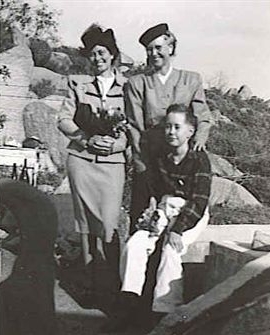 She was born in California. At the time of the 1910 census she was 13 years old, living at home with her father in Riverside, California. In the 1920 census, after the death of her father in 1917, she was living at home with her mother in Riverside. She was practicing millinery at home.
She was born in California. At the time of the 1910 census she was 13 years old, living at home with her father in Riverside, California. In the 1920 census, after the death of her father in 1917, she was living at home with her mother in Riverside. She was practicing millinery at home.
At right is a photograph of Elizbeth Amy and Eva Wells. The boy is Eva's son Richard, who had Downs syndrome. The picture was taken in Corona, California in 1947. Eva lived to be over 100 years old.
(24) Elizbeth Amy Wells (1899)She was born on 12 January 1899 in California. At the time of the 1910 census Lizzie A. was 11 years old, living at home with her father in Riverside, California. In the 1920 census, after the death of her father in 1917, she was living at home with her mother in Riverside. She married Robert J. Darter, of Indiana, sometime between 1920 and 1930. He was born on 4 January 1901 in Indiana. In 1930 they were living in Berkeley, California. He was a lawyer. She was a State Bacteriologist at the university. Robert died on 28 December 1973 in Contra Costa, California. She died on 17 February 1997 in Alameda, California.
There was a Robert J. Darter living in Berkeley, California in 1994. I suspect he was Robert & Lizbeth's son.
(22) Electa Wells (1803)She was born on 13 July 1803 in Brookfield township, Orange county, Vermont and died on 4 September 1842.
(21) Perez Welles (1757)Perez Wells, the son of Noah Wells, was born on 19 November 1757 in Hatfield, just before his father removed to Whately. A soldier in the Revolutionary War. He married Elizabeth Crafts, the daughter of Benoni and Abigail Crafts, on 17 April 1783 in Whately. Elizabeth was born on 11 November 1767. They lived together for 65 years.
In the 1790 census for Whately, Massachusetts, there is one male over 16, 2 under, and 2 females living in Perez's house. His children were Chester (1782), Calvin (1785), Lucinda (1787), Luther (1790), Rhoda (1793), Lewis (1795), Isaac (1797), Lewis (1799), Lucinda (1802), Rhoda (1806), and Isaac (1808). These repetitions are a sign of younger children who died and whose names were repeated.
Perez died on 25 January 1852 in Whately. He was buried in the Center cemetery in Whately. Elizabeth died on 30 July 1848.
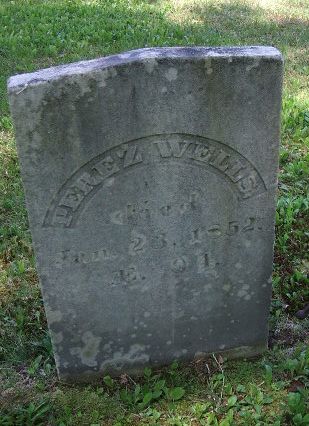
The children of Perez and Elizabeth Wells were,
(22) Chester Wells (1782)
(22) Calvin Wells (1785)
(22) Lucinda Wells (1787), died at the age of 7
(22) Luther Wells (1790)
(22) Rhoda Wells (1793), died young
(22) Lewis Wells (1795), died young
(22) Isaac Wells (1797), died young
(22) Lewis Wells (1799)
(22) Lucinda Wells (1802)
(22) Rhoda Wells (1806)
(22) Isaac Wells (1808)
She was born about 1759. She married Joel Morton/
(21) John Welles (1761)He was born about 1761. In the 1790 census for Whately, Massachusetts, there are two males over the age of 16, 2 under, and 4 females living in Rufus Wells' house. Is this another son of Noah's?